Mitac 8050Qma Users Manual
8050QMA to the manual 137a2d8d-7614-42d1-9e13-933b7ed7a390
2015-02-09
: Mitac Mitac-8050Qma-Users-Manual-556367 mitac-8050qma-users-manual-556367 mitac pdf
Open the PDF directly: View PDF ![]() .
.
Page Count: 138 [warning: Documents this large are best viewed by clicking the View PDF Link!]

BY: ZX Xiao
Repair Technology Research Department /EDVD
Repair Technology Research Department /EDVD
Jun.2005 / R01
SERVICE MANUAL FOR
8050QMA
SERVICE MANUAL FOR
SERVICE MANUAL FOR
8050QMA
8050QMA

1
80
8050QMA
50QMA N/B Maintenance
N/B Maintenance
Contents
1. Hardware Engineering Specification ………………………………………………………………………
1.1 Introduction ………………………………………………………………………………………………………………..
1.2 System Hardware Parts …………………………………………………………………………………………………...
1.3 Other Functions ……………………………………………………………………………………………………………
1.4 Power Management ……………………………………………………………………………………………………….
1.5 Appendix 1 : Intel ICH6-M GPIO Definitions ………………………………………………………………………….
1.6 Appendix 2 : W83L950D KBC Pins Definitions …………………………………………………………………………
1.7 Appendix 3 : 8050QMA Product Spec ……………………………………………………………………………….. …
2. System View and Disassembly ……………………………………………………………………………...
2.1 System View ………………………………………………………………………………………………………………..
2.2 Tools Introduction …………………………………………………………………………………………………..…….
2.3 System Disassembly ………………………………………………………………………………………………………..
3. Definition & Location of Connectors / Switches …………………………………………………………..
3.1 Mother Board (Side A) ……………………………………………………………………………………………………
3.2 Mother Board (Side B) ……………………………………………………………………………………………………
4. Definition & Location of Major Components ……………………………………………………………..
4.1 Mother Board (Side A) ……………………………………………………………………………………………………
4.2 Mother Board (Side B) ……………………………………………………………………………………………………
4
4
7
32
39
49
74
74
76
49
77
52
42
44
75
46
76
53
MiTac Secret
Confidential Document

2
80
8050QMA
50QMA N/B Maintenance
N/B Maintenance
Contents
5. Pin Description of Major Component …….……………………………………………………………….
5.1 Intel 915PM North Bridge ……………………………………………………………………………………………….
5.2 Intel ICH6-M South Bridge ………………………………………………………………………………………………
6. System Block Diagram ………………………………………………………………………………………
7. Maintenance Diagnostics ……………………………………………………………………………………
7.1 Introduction ………………………………………………………………………………………………………………..
7.2 Maintenance Diagnostics…………………………………………………………………………………………………..
7.3 Error Codes ………………………………………………………………………………………………………………..
8. Trouble Shooting …………………………………………………………………………………………….
8.1 No Power ……………………………………………………………………………………………………………………
8.2 No Display ………………………………………………………………………………………………………………….
8.3 VGA Controller Failure LCD No Display ………………………………………………………………………………..
8.4 External Monitor No Display ……………………………………………………………………………………………..
8.5 Memory Test Error ………………………………………………………………………………………………………..
8.6 Keyboard (K/B) Touch-Pad (T/P) Test Error ……………………………………………………………………………
8.7 Hard Drive Test Error ……………………………………………………………………………………………………
8.8 CD-ROM Drive Test Error ………………………………………………………………………………………………
8.9 USB Port Test Error ……………………………………………………………………………………………………….
8.10 Audio Failure ……………………………………………………………………………………………………………..
8.11 LAN Test Error …………………………………………………………………………………………………………..
103
115
121
127
117
119
98
105
112
123
125
129
78
88
132
99
101
99
100
78
MiTac Secret
Confidential Document

3
80
8050QMA
50QMA N/B Maintenance
N/B Maintenance
Contents
8.12 PC Card Socket Failure …………………………………………………………………………………………………
9. Spare Parts List ……………………………………………………………………………………………...
10. Reference Material …...……………………………………………………………………………………. 150
136
134
MiTac Secret
Confidential Document

4
80
8050QMA
50QMA N/B Maintenance
N/B Maintenance
1.1 Introduction
1. Hardware Engineering Specification
This document describes the brief introduction for MiTAC 8050QMA portable notebook computer system.
1.1.1 General Description
1.1.2 System Overview
The MiTAC 8050Q model is designed for Intel Dothan processor with 533MHz FSB with Micro-FCPGA package.
This system is based on PCI architecture and is fully compatible with IBM PC/AT specification, which has
standard hardware peripheral interface. The power management complies with Advanced Configuration and Power
Interface. It also provides easy configuration through CMOS setup, which is built in system BIOS software and can
be pop-up by pressing F2 key at system start up or warm reset. System also provides icon LEDs to display system
status, such as AC Power indicator, Battery Power indicator, Battery status indicator, HDD,CD-ROM, NUM
LOCK, CAP LOCK, SCROLL LOCK, Wireless on/off Card Reader Accessing. It also equipped with LAN, 56K
Fax MODEM, 4 USB port, S-Video and audio line in/out , external microphone function.
The memory subsystem supports DDR or DDR2 SDRAM channels (64-bits wide).
The 915PM MCH Host Memory Controller integrates a high performance host interface for Intel Dothan processor,
a high performance PCI Express interface, a high performance memory controller and Direct Media Interface
MiTac Secret
Confidential Document

5
80
8050QMA
50QMA N/B Maintenance
N/B Maintenance
(DMI) connecting with Intel ICH6-M.
The Intel ICH6-M integrates three Universal Serial Bus 2.0 Host Controllers Interface (UHCI), the Audio
Controller with AC97 interface, the Ethernet includes a 32-bit PCI controller, the IDE Master/Slave controllers, the
SATA controller and Direct Media Interface technology.
The Realtek RTL8100CL is a highly integrated, cost-effective single-chip Fast Ethernet controller that provides 32-
bit performance, PCI bus master capability, and full compliance with IEEE 802.3u 100Base-T specifications and
IEEE 802.3x Full Duplex Flow Control. It also supports the Advanced Configuration Power management Interface
(ACPI).
The VT6301S is a single chip PCI Host Controller for IEEE 1394-1995 Release 1.0 and IEEE 1394a P2000. It
implements the Link and PHY layers for IEEE 1394-1995 High Performance Serial Bus specification release 1.0
and 1394a P2000. It is compliant with 1394 Open HCI 1.0 and 1.1 with DMA engine support for high performance
data transfer via a 32-bit bus master PCI host bus interface. The VT6301S supports 100, 200 and 400 Mbit/sec
transmission via an integrated 1-port PHY. The VT6301S services two types of data packets: asynchronous and
isochronous (real time). The 1394 link core performs arbitration requesting, packet generation and checking, and
bus cycle master operations. It also has root node capability and performs retry operations.
The ENE CB712 CardBus/Media Reader controller functions as a single slot PCI to Cardbus bridge and also PCI
interface MS/SD/MMC flash card reader. The CB712 provide one Cardbus slot and all reader interface may
operate simultaneously.
The W83L950D is a high performance microcontroller on-chip supporting functions optimized for embedded
control. These include ROM, RAM, four types of timers, a serial communication interface, optional I²C bus
interface, host interface, A/D converter, D/A converter, I/O ports and other functions needed in control system
MiTac Secret
Confidential Document

6
80
8050QMA
50QMA N/B Maintenance
N/B Maintenance
configurations, so that compact, high performance systems can be implemented easily.
A full set of software drivers and utilities are available to allow advanced operating systems such as Windows ME,
Windows 2000 and Windows XP to take full advantage of the hardware capabilities. Features such as bus mastering
IDE, Plug and Play, Advanced Power Management (APM) with application restart, software-controlled power
shutdown.
Following chapters will have more detail description for each individual sub-systems and functions.
MiTac Secret
Confidential Document

7
80
8050QMA
50QMA N/B Maintenance
N/B Maintenance
1.2 System Hardware Parts
CPU Intel® Pentium® M Processor (Dothan) 90nm, 2M L2, 533 MHz FSB
Intel® Celeron® M processor, 90nm, 512K L2, 400 MHz FSB
Core logic Intel 915PM + ICH6-M chipset
System BIOS SST49LF004A
Memory 0MB DDR2-SDRAM on Board
Expandable with combination of optional 128MB/256MB/512MB/1GB(P) memory
Two 200-pin DDR2 400/533 SDRAM Memory Module
VGA Control Type I MXM Interface (max 25W) with 8 cells Vram
Priority at launch: NV44M + 32MB discrete Vram + Turbo Memory
Clock Generator ICS 954226
IEEE1394 VT6301S
LAN RTL8100CL
PCMCIA + 4 IN 1 CARD ENE CB712
Audio System AC97 CODEC: Advance Logic, Inc, ALC655
Power Amplifier: TI TPA0212
Modem AC97 Link: MDC (Mobile Daughter Card) Askey: V1456VQL-P1(INT)
MiTac Secret
Confidential Document

8
80
8050QMA
50QMA N/B Maintenance
N/B Maintenance
1.2.1 Intel Dothan Processors in Micro-FCBGA Package
Intel Dothan Processors with 479 pins Micro-FCBGA package.
It will be manufactured on Intel’s advanced 90 nanometer process technology with copper interconnect. It’s features
include Intel Architecture with Dynamic Execution, On-die primary 32-kB instruction cache and 32-kB write-back
data cache, on-die 2-MB second level cache with advanced Transfer Cache Architecture, Data Prefetch Logic,
Streaming SIMD Extensions 2 (SSE2), 533-MHz FSB.
The Streaming SIMD Extensions 2 (SSE2) enable break-through levels of performance in multimedia applications
including 3-D graphics, video decoding/encoding, and speech recognition.
Use Source-Synchronous Transfer (SST) of address and data to improve performance by transferring data four times
per bus clock.
Support Enhanced Intel SpeedStep technology, which enables real-time dynamic switching of the voltage and
frequency between two performance modes.
1.2.2 Clock Generator
System frequency synthesizer: ICS954226 is a CK410M Compliant clock synthesizer. It provides a single-chip
solution for mobile systems built with Intel P4-M processors and Intel mobile chipsets. It is driven with a
14.318MHz crystal and generates CPU outputs up to 400MHz. It provides the tight ppm accuracy required by
Serial ATA and PCI-Express.
MiTac Secret
Confidential Document

9
80
8050QMA
50QMA N/B Maintenance
N/B Maintenance
•Supports tight ppm accuracy clocks for Serial-ATA and SRC.
•Supports spread spectrum modulation, 0 to –0.5% down spread.
•Uses external 14.318MHz crystal, external crystal load caps are required for frequency tuning.
•Supports undriven differential CPU, SRC pair in PD# for power management.
1.2.3 The Mobile Intel 915PM Express Chipset
The Mobile Intel 915PM Express Chipset integras a memory controller hub (MCH) designed for use with the
Dothan, Yonah and Intel Celeron M Processor. It is PCI Express based Graphics.
The 915PM MCH integrates a system memory DDR/DDR2 controller with two, 64-bit wide interfaces. Only
Double Data Rate (DDR/DDR2) memory is supported; the buffers support DDR SSTL_2 and DDR2 SSTL_18
signaling interfaces. The memory controller interface is fully configurable through a set of control registers. It
integras a high performance transition interface PCI Express Interface. PCI Express operates at a data rate of 2.5
for 8050QMA project. GB/s. This allows a maximum theoretical bandwidth of 40 GB/s each direction. The 915PM
MCH integrates Direct media interface (DMI) chip-to-chip interconnect between the MCH and ICH6-M. DMI
supports DMI x2 and DMI x4 configuration.
Features:
Processor/FSB Support
MiTac Secret
Confidential Document

10
80
8050QMA
50QMA N/B Maintenance
N/B Maintenance
•Intel®Dothan processor
•AGTL+ bus driver technology with integrated GTL termination resistors (gated AGTL+ receivers for reduced
power)
•Supports 32-bit AGTL+ host bus addressing
•Supports system bus at 533MT/s (533 MHz) and 400MT/s (400 MHz)
•2X Address, 4X data
•Host bus dynamic bus inversion HDINV support
•12 deep, in-order queue
Memory System
•Directly supports to two DDR or DDR2 SDRAM channels, 64-bts wide.
•Supports SO-DIMMs of the same type (e.g.,all DDR or all DDR2), not mixed.
•Maximum of two, double-sided unbuffered SO-DIMMs (4 rows populated)
•Minimum amount of memory supported is 128 MB (16 MB x 16-b x 4 devices x 1 rows = 128 MB) using
256-MB technology
•Maximum amount of memory supported is 2 GB using 1-GB technology.
MiTac Secret
Confidential Document

11
80
8050QMA
50QMA N/B Maintenance
N/B Maintenance
•256-MB, 512-MB and 1-GB technology using x8 and x16 devices.
•Three memory channel organizations are supported for DDR / DDR2 :
– Single channel
– Dual channel interleaved
– Dual channel asymmetric
•Supports DDR 333 devices and DDR2 400 /533 devices
– Supports on-die termination (ODT) for DDR2
•Supports Fast Chip Select mode
•Supports partial write to memory using Data Mask signal (DM)
•Supports high-density memory package for DDR or DDR2 type devices
PCI Express Interface
•One x16 (16 lanes) PCI Express port intended for graphics attach
•Maximum theoretical realized bandwidth on interface of 4 GB/s in each direction simultaneously, for an
average of 8 GB/s when x16
•Automatic discovery, negotiation and training of link out of reset
•Supports traditional PCI style traffic (asynchronous snooped, PCI ordering)
MiTac Secret
Confidential Document

12
80
8050QMA
50QMA N/B Maintenance
N/B Maintenance
•Supports only 1.5-V AGP electrics
•32 deep AGP request queue
•Hierarchical PCI-compliant configuration mechanism for downstream devices
•Direct Media Interface (DMI)
– Chip-to-chip interconnect between the GMCH and ICH6-M
– DMI x2 and DMI x4 configuration supported
– Bit swapping is supported
– Lane reversal is not supported
1.2.4 I/O Controller Hub : Intel ICH6-M
The ICH6 provides extensive I/O support. Functions and capabilities include:
•PCI Express Base Specification, Revision 1.0a-compliant
•PCI Local Bus Specification, Revision 2.3-compliant with support for 33 MHz PCI operations(supports up to
seven Req/Gnt pairs)
•ACPI Power Management Logic Support
•Enhanced DMA controller, interrupt controller and timer functions
MiTac Secret
Confidential Document

13
80
8050QMA
50QMA N/B Maintenance
N/B Maintenance
•Integrated Serial ATA host controller with independent DMA operation on two ports and AHCI support
•Integrated IDE controller supports Ultra ATA100/66/33
•USB host interface with support for three USB ports; three UHCI host controllers; one EHCI high-speed
USB2.0 Host controller
•Integrated LAN controller
•System Management Bus (SMBus) Specification, Version 2.0 with additional support for I2C devices
•Supports Audio Codec ’97, Revision 2.3 Specification (a.k.a.,AC ’97 Component Specification, Revision 2.3)
which provides a link for Audio and Telephony codecs (up to 7 channels)
•Supports Intel High Definition Audio
•Low Pin Count (LPC) interface
•Firmware Hub (FWH) interface support
1.2.5 CardBus: CB712
Features:
3.3V operation with 5V tolerant
LFBGA 169-ball package
MiTac Secret
Confidential Document

14
80
8050QMA
50QMA N/B Maintenance
N/B Maintenance
Pin out Compatible with CB1410
•PCI Interface
– Compliant with PCI Local Bus Specification Revision 2.3
– Compliant with PCI Bus Power Management Interface Specification Revision 1.1
– Compliant with PCI Mobile Design Guide Version 1.1
– Compliant with Advanced Configuration and Power Interface Specification Revision 1.0
•CardBus Interface
– Compliant with PC Card Standard 8.0
– Support Standardized Zoomed Video Register Model
– Support SPKROUT CAUDIO and RIOUT#
•Secure Digital Interface
– Compliant with SD Host Controller Standard Specification Version 1.0
– Support SD Suspend/Resume Functionality
– Support DMA Mode to Minimize CPU Overhead
– Support High Speed with the SD Clock Frequency Up to 50Mhz
– Contain two 512-byte buffer to maximize the transfer speed
– Support Traffic LED Light
– Support Over Current Protection
MiTac Secret
Confidential Document

15
80
8050QMA
50QMA N/B Maintenance
N/B Maintenance
•Memory Stick Interface
– Compliant with Memory Stick PRO Format Specification Version 1.0
– Support 4-bit Parallel Data Transfer Mode
– Memory Stick Clock Frequency Up to 40Mhz
– Support DMA Mode to Minimize CPU Overhead
– Support Traffic LED Light
– Support Over Current Protection
•Interrupt Configuration
– Support Parallel PCI Interrupts
– Support Parallel IRQ and Parallel PCI Interrupts
– Support Serialized IRQ and Parallel PCI Interrupts
– Support Serialized IRQ and PCI Interrupts
•Power Management Control Logic
– Support CLKRUN# protocol
– Support SUSPEND#
– Support PCI PME# from D3, D2, D1 and D0
– Support PCI PME# from D3cold
•Support Zoomed Video port
MiTac Secret
Confidential Document

16
80
8050QMA
50QMA N/B Maintenance
N/B Maintenance
•Support parallel 4-wire power switch interface
The ALC655 is a 16-bit, full duplex AC'97 2.3 compatible six channels audio CODEC designed for PC multimedia
systems, including host/soft audio and AMR/CNR based designs. The ALC655 incorporates proprietary converter
technology to meet performance requirements on PC99/2001 systems. The ALC655 CODEC provides three pairs of
stereo outputs with 5-Bitvolume controls, a mono output, and multiple stereo and mono inputs, along with flexible
mixing, gain and mute functions to provide a complete integrated audio solution for PCs. The digital interface
circuitry of the ALC655 CODEC operates from a 3.3V power supply for use in notebook and PC applications. The
ALC655 integrates 50mW/20ohm headset audio amplifiers at
Front-Out and Surr-Out, built-in 14.318M 24.576MHz PLL and PCBEEP generator, those can save BOM costs. The
ALC655 also supports the S/PDIF input and output function, which can offer easy connection of PCs to consumer
electronic products, such as AC3 decoder/speaker and mini disk devices. ALC655 supports host/soft audio from Intel
ICH6 chipsets as well as audio controller based VIA/SIS/ALI/AMD/nVIDIA/ATI chipset. Bundled Windows series
drivers (WinXP/ME/2000/98/NT), EAX/
Direct Sound 3D/ I3DL2/ A3D compatible sound effect utilities (supporting Karaoke, 26-kind of environment sound
emulation,10-band equalizer), HRTF 3D positional audio and Sensaura™ 3D (optional) provide an excellent
entertainment package and game experience for PC users. Besides, ALC655 includes Realtek’s impedance sensing
techniques that makes device load on outputs and inputs can be detected.
1.2.6 AC’97 Audio System: Advance Logic, Inc, ALC655
MiTac Secret
Confidential Document

17
80
8050QMA
50QMA N/B Maintenance
N/B Maintenance
•Meets performance requirements for audio on PC99/2001 systems
•Meets Microsoft WHQL/WLP 2.0 audio requirements
•16-bit Stereo full-duplex CODEC with 48KHz sampling rate
•Compliant with AC’97 2.3 specifications
– 14.318MHz- 24.576MHz PLL to save crystal
– 12.288MHz BITCLK input can be consumed
– Integrated PCBEEP generator to save buzzer
– Interrupt capability
•Three analog line-level stereo inputs with 5-bit volume control: LINE_IN, CD, AUX
•High quality differential CD input
•Two analog line-level mono input: PCBEEP,PHONE-IN
•Two software selectable MIC inputs applications (software selectable)
•Boost preamplifier for MIC input 50mW/20 amplifier
•External Amplifier Power Down (EAPD) capability
•Power management and enhanced power saving features
MiTac Secret
Confidential Document

18
80
8050QMA
50QMA N/B Maintenance
N/B Maintenance
•Stereo MIC record for AEC/BF application
•Supports Power Off CD function
•Adjustable VREFOUT control Supports double sampling rate (96KHz) of DVD audio playback
•Support 48KHz of S/PDIF output is compliant with AC’97 rev2.3 specification
•Power support: Digital: 3.3V; Analog: 3.3V/5V
1.2.7 MDC: Pctel Modem Daughter Card PCT2303W (Askey V1456VQL-P1)
The PCT2303W chipset is designed to meet the demand of this emerging worldwide AMR/MDC market. The
combination of PC-TEL’s well proven PCT2303W chipset and the HSP56TM MR software modem driver allows
systems manufactures to implement modem functions in PCs at a lower bill of materials (BOM) while maintaining
higher system performance.
PC-TEL has streamlined the traditional modem into the Host Signal Processing (HSP) solution. Operating with the
Pentium class processors, HSP becomes part of the host computer’s system software. It requires less power to
operate and less physical space than standard modem solutions. PC-TEL’s HSP modem is an easily integrated, cost-
effective communications solution that is flexible enough to carry you into the future.
The PCT2303W chip set is an integrated direct access arrangement (DAA) and Codec that provides a programmable
line interface to meet international telephone line requirements. The PCT2303W chip set is available in two 16-pin
MiTac Secret
Confidential Document

19
80
8050QMA
50QMA N/B Maintenance
N/B Maintenance
small outline packages (AC’97 interface on PCT303A and phone-line interface on PCT303W). The chip set
eliminates the need for an AFE, an isolation transformer, relays, opto-isolators, and 2-to 4-wire hybrid. The
PCT2303W chip set dramatically reduces the number of discrete components and cost required to achieve
compliance with international regulatory requirements. The PCT2303W complies with AC’97 Interface specification
Rev. 2.1.
The chip set is fully programmable to meet world-wide telephone line interface requirements including those
described by CTR21, NET4, JATE, FCC, and various country-specific PTT specifications. The programmable
parameters of the PCT2303W chip set include AC termination, DC termination, ringer impedance, and ringer
threshold. The PCT2303W chip set has been designed to meet stringent world-wide requirements for out-of-band
energy, billing-tone immunity, lightning surges, and safety requirements.
Features:
Virtual com port with a DTE throughout up to 460.8Kbps.
G3 Fax compatible
Auto dial and auto answer
Ring detection
•AC97 2.1 compliant
•86dB dynamic range TX/RX paths
Codec/DAA Features
MiTac Secret
Confidential Document

20
80
8050QMA
50QMA N/B Maintenance
N/B Maintenance
•2-4-wire hybrid
•Integrated ring detector
•High voltage isolation of 4000V
•Support for “Caller ID”
•Compliant with FCC Part68, CTR21, Net4 and JATE
•Low power standby
•Low profile SOIC package 16 pins 10x3x1.55mm
•Low power consumption
•10mA @ 3.3V operation
•1mA @ 3.3V power down
•Integrated modem codec
MiTac Secret
Confidential Document

21
80
8050QMA
50QMA N/B Maintenance
N/B Maintenance
•Data
– ITU-T V.90 (56Kbps), V.34 (4.8Kbps TO 33.6 Kbps), V.32 bis (4.8Kbps to 14.4Kbps), V.22 bis (1.2 bps
to 2.4 Kbps), V.21 and Bell 103 and 212A(300 to 1200 bps) modulation protocol
– Data Compression ITU-T V.42bis MNP Class 5
– Error Correction ITU-T V.42 LAPM MNP 2-4
•Fax
– ITU-T V. 17, V.29, V.27ter, V.21, Channel 2, Group 3, EIA Class I
Standard Features
MiTac Secret
Confidential Document

22
80
8050QMA
50QMA N/B Maintenance
N/B Maintenance
1.2.8 IEEE1394 VT6301S
1.2.8.1 Overview
The VT6301S IEEE 1394 OHCI Host Controller provides high performance serial connectivity. It implements
the Link and Phy layers for IEEE 1394-1995 High Performance Serial Bus specification release 1.0 and 1394a-
2000. It is compliant with 1394 Open HCI 1.0 and 1.1 with DMA engine support for high performance data
transfer via a 32-bit bus master PCI host bus interface. The VT6301S supports 100, 200 and 400 Mbit/sec
transmission via an integrated 1-port PHY. The VT6301S services two types of data packets: asynchronous and
isochronous (real time). The 1394 link core performs arbitration requesting, packet generation and checking,
and bus cycle master operations. It also has root node capability and performs retry operations. The VT6301S is
ready to provide industry-standard IEEE 1394 peripheral connections for desktop and mobile PC platforms.
Support for the VT6301S is built into Microsoft Windows 98, Windows ME, Windows 2000 and Windows XP
1.2.8.2 Features
•32 bit CRC generator and checker for receive and transmit data
•On-chip isochronous and asynchronous receive and transmit FIFOs for packets (2K for general
receive plus 2K for isochronous transmit plus 2K for asynchronous transmit)
•8 isochronous transmit contexts
•4 isochronous receive contexts
MiTac Secret
Confidential Document

23
80
8050QMA
50QMA N/B Maintenance
N/B Maintenance
•3-deep physical post-write queue
•2-deep physical response queue
•Dual buffer mode enhancements
•Skip Processing enhancements
•Block Read Request handling
•Ack_tardy processing
Firmware Hub for Intel® 810, 810E, 815, 815E,815EP, 820, 840, 850 Chipsets
Flexible Erase Capability
– Uniform 4 KByte Sectors
– Uniform 16 KByte overlay blocks for SST49LF002A
– Uniform 64 KByte overlay blocks for SST49LF004A
– Top boot block protection
– 16 KByte for SST49LF002A
– 64 KByte for SST49LF004A
1.2.9 System Flash Memory (BIOS)
MiTac Secret
Confidential Document

24
80
8050QMA
50QMA N/B Maintenance
N/B Maintenance
– Chip-Erase for PP Mode
Single 3.0-3.6V Read and Write Operations
Superior Reliability
Firmware Hub Hardware Interface Mode Supports Intel High Definition Audio
– 5-signal communication interface supporting byte Read and Write
– 33 MHz clock frequency operation
– WP# and TBL# pins provide hardware write protect for entire chip and/or top Boot Block
– Block Locking Register for all blocks
– Standard SDP Command Set
– Data# Polling and Toggle Bit for End-of-Write detection
– 5 GPI pins for system design flexibility
– 4 ID pins for multi-chip selection
1.2.10 Memory System
1.2.10.1 256MB, 512MB, 1GB (x64) 200-Pin DDR2 SDRAM SODIMMs
•JEDEC-standard 200-pin, small-outline, dual in-line memory module (SODIMM)
•VDD=+1.8V±0.1V, VDDQ=+1.8V±0.1V
MiTac Secret
Confidential Document

25
80
8050QMA
50QMA N/B Maintenance
N/B Maintenance
•JEDEC standard 1.8V I/O (SSTL_18-compatible)
•Differential data strobe (DQS,DQS#) option
•Four-bit prefetch architecture
•Differential clock input (CK,CK#)
•Command entered on each rising CK edge
•DQS edge-aligned with data for Reads
•DQS center-aligned with data for Writes
•Duplicate output strobe (RDQS) option for x8 configuration
•DLL to align DQ and DQS transitions with CK
•Four internal banks for concurrent operation
•Data mask (DM) for masking write data
•Programmable CAS Latency (CL) : 2,3,4 and 5
•Posted CAS additive latency (AL) : 0,1,2,3 and 4
•Write latency = Read latency – 1tCK
MiTac Secret
Confidential Document

26
80
8050QMA
50QMA N/B Maintenance
N/B Maintenance
•Programmable burst lengths : 4 or 8
•Read burst interrupt supported by another READ
•Write burst interrupt supported by another WRITE
•Adjustable data – output drive strength
•Concurrent auto precharge option is supported
•Auto Refresh (CBS) and Self Refresh Mode
•64ms, 8,192-cycle refresh
•Off-chip drive (OCD) impedance calibration
•On-die termination (ODT)
General
1.2.11 LAN PHY: RTL8100C(L)
The Realtek RTL8100C(L) is a highly integrated, cost-effective single-chip Fast Ethernet controller that provides 32-
bit performance, PCI bus master capability, and full compliance with IEEE 802.3u 100Base-T specifications and
IEEE 802.3x Full Duplex Flow Control. It also supports the Advanced Configuration Power management Interface
(ACPI), PCI power management for modern operating systems that are capable of Operating System Directed Power
MiTac Secret
Confidential Document

27
80
8050QMA
50QMA N/B Maintenance
N/B Maintenance
Management (OSPM) to achieve the most efficient power management possible. The RTL8100C(L) does not
support CardBus mode as the RTL8139C does. In addition to the ACPI feature, the RTL8100C(L) also supports
remote wake-up (including AMD Magic Packet, LinkChg, and Microsoft® wake-up frame) in both ACPI and APM
environments. The RTL8100C(L) is capable of performing an internal reset through the application of auxiliary
power. When auxiliary power is applied and the main power remains off, the RTL8100C(L) is ready and waiting for
the Magic Packet or Link Change to wake the system up. Also, the LWAKE pin provides 4 different output signals
including active high, active low, positive pulse, and negative pulse. The versatility of the RTL8100C(L) LWAKE
pin provides motherboards with Wake-On-LAN (WOL) functionality. The RTL8100C(L) also supports Analog
Auto-Power-down, that is, the analog part of the RTL8100C(L) can be shut down temporarily according to
user requirements or when the RTL8100C(L) is in a power down state with the wakeup function disabled. In
addition, when the analog part is shut down and the IsolateB pin is low (i.e. the main power is off), then both the
analog and digital parts stop functioning and the power consumption of the RTL8100C(L) will be negligible.
The RTL8100C(L) also supports an auxiliary power auto-detect function and will auto-configure related bits
of their own PCI power management registers in PCI configuration space.
•128 pin QFP/LQFP
•Integrated Fast Ethernet MAC, Physical chip and transceiver in one chip
•10 Mb/s and 100 Mb/s operation
•Supports 10 Mb/s and 100 Mb/s N-way Auto-negotiation operation
•PCI local bus single-chip Fast Ethernet controller
1. Compliant to PCI Revision 2.2
MiTac Secret
Confidential Document

28
80
8050QMA
50QMA N/B Maintenance
N/B Maintenance
2. Supports PCI clock 16.75MHz-40MHz
3. Supports PCI target fast back-to-back transaction
4. Provides PCI bus master data transfers and PCI memory space or I/O space mapped data transfers of
RTL8100C(L)'s operational registers
5. Supports PCI VPD (Vital Product Data)
6. Supports ACPI, PCI power management
•Supports 25MHz crystal or 25MHz OSC as the internal clock source. The frequency deviation of either crystal
or OSC must be within 50 PPM.
•Compliant to PC99/PC2001 standard
•Supports Wake-On-LAN function and remote wake-up (Magic Packet*, LinkChg and Microsoft® wake-up
frame)
•Supports 4 Wake-On-LAN (WOL) signals (active high, active low, positive pulse and negative pulse)
•Supports auxiliary power-on internal reset, to be ready for remote wake-up when main power still remains off
•Supports auxiliary power auto-detect, and sets the related capability of power management registers in PCI
configuration space
•Includes a programmable, PCI burst size and early Tx/Rx threshold
•Supports a 32-bit general-purpose timer with the external PCI clock as clock source, to generate timer-interrupt
•Contains two large (2Kbyte) independent receive and transmit FIFOs
MiTac Secret
Confidential Document

29
80
8050QMA
50QMA N/B Maintenance
N/B Maintenance
•Advanced power saving mode when LAN function or wakeup function is not used
•Uses 93C46 (64*16-bit EEPROM) to store resource configuration, ID parameter and VPD data
•Supports LED pins for various network activity indications
•Supports loop back capability
•Half/Full duplex capability
•Supports Full Duplex Flow Control (IEEE 802.3x)
The Winbond Keyboard controller architecture consists of a Turbo 51 core controller surrounded by various registers,
nine general purpose I/O port, 2k+256 bytes of RAM, four timer/counters, dual serial ports, 40K MTP-ROM that is
divided into four banks, two SMBus interface for master and slave, Support 4 PWM channels, 2 D-A and 8 A-D
converters.
1.2.12 Keyboard System: Winbond W83L950D
•8051 uC based
•Keyboard Controller Embedded Controller
•Supply embedded programmable flash memory (internal ROM size: 40KB) and RAM size is 2 KB
•Support 4 Timer (8 bit) signal with 3 prescalers
MiTac Secret
Confidential Document

30
80
8050QMA
50QMA N/B Maintenance
N/B Maintenance
•Support 2 PWM channels, 2 D-A and 8 A-D converters
•Reduce Firmware burden by Hardware PS/2 decoding
•Support 72 useful GPIOs totally
•Support Flash utility for on board re-flash
•Support ACPI
•Hardware fast Gate A20 with software programmable
IDE HDD
1.2.13 Hard Disk Drive
The ICH6 IDE controller features one set of interface signals that can be enabled, tri-stated or driven low. The IDE
interfaces of the ICH6 can support several types of data transfers:
•Programmed I/O (PIO): processor is in control of the data transfer
•8237 style DMA: DMA protocol that resembles the DMA on the ISA bus, although it does not use the 8237 in
the ICH6. This protocol off loads the processor from moving data. This allows higher transfer rate of up to
16MB/s
MiTac Secret
Confidential Document

31
80
8050QMA
50QMA N/B Maintenance
N/B Maintenance
•Ultra ATA/33/66/100: DMA protocol that redefines signals on the IDE cable to allow both host and target
throttling of data and transfer rates of up to 33/66/100 MB/s
MiTac Secret
Confidential Document

32
80
8050QMA
50QMA N/B Maintenance
N/B Maintenance
Keys
Combination Feature Meaning
Fn + F1 Power down Mini PCI power down
Fn + F2 Reserve
Fn + F3 Volume Down
Fn + F4 Volume Up
Fn + F5 LCD/external CRT switching Rotate display mode in LCD only, CRT only, and
simultaneously display.
Fn + F6 Brightness down Decreases the LCD brightness
Fn + F7 Brightness up Increases the LCD brightness
Fn + F10 Battery Low Beep On/Off Battery Low Beep
Fn + F11 Panel Off/On Toggle Panel on/off
Fn + F12 Suspend to DRAM / HDD Force the computer into either Suspend to HDD or
Suspend to DRAM mode depending on BIOS Setup.
1.3 Other Functions
1.3.1 Hot Key Function
MiTac Secret
Confidential Document

33
80
8050QMA
50QMA N/B Maintenance
N/B Maintenance
1.3.2 Power On/Off/Suspend/Resume Button
1.3.2.1 APM Mode
At APM mode, Power button is on/off system power.
At ACPI mode. Windows power management control panel set power button behavior.
You could set “standby”, “power off” or “hibernate”(must enable hibernate function in power Management) to
power button function.
Continue pushing power button over 4 seconds will force system off at ACPI mode.
1.3.2.2 ACPI Mode
1.3.3 Cover Switch
System automatically provides power saving by monitoring Cover Switch. It will save battery power and prolong
the usage time when user closes the notebook cover.
At ACPI mode there are four functions to be chosen at windows power management control panel.
1. None
2. Standby
MiTac Secret
Confidential Document

34
80
8050QMA
50QMA N/B Maintenance
N/B Maintenance
1.3.4 LED Indicators
1.3.4.1 Three LED Indicators at Front Side:
From left to right that indicate BATTERY POWER, BATTERY STATUS and AC POWER
-- AC POWER:
This LED lights green when the notebook was powered by AC power line, Flashes (on 1 second, off 1
second) when entered suspend to RAM state with AC powered. The LED is off when the notebook is in
power off state or powered by battery.
-- BATTERY POWER
This LED lights green when the notebook is being powered by Battery, and flashes (on 1 second, off 1
second) when entered suspend to RAM state with AC powered. The LED is off when the notebook is in
power off state or powered by AC adapter.
-- BATTERY STATUS:
During normal operation, this LED stays off as long as the battery is charged. When the battery charge
drops to 10% of capacity, the LED lights red, flashes per 1 second and beeps per 2 second. When AC is
3. Off
4. Hibernate (must enable hibernate function in power management)
MiTac Secret
Confidential Document

35
80
8050QMA
50QMA N/B Maintenance
N/B Maintenance
connected, this indicator glows green if the battery pack is fully charged or orange (amber) if the battery is
being charged.
AC POWER:This LED lights green when AC is powering the notebook, and flash (on 1 second, off 1 second)
when Suspend to RAM no matter using AC power or Battery power. The LED is off when the
notebook is off or powered by battery.
BATTERY POWER: This LED lights green when the notebook is being powered by Battery, and flash (on 1
second, off 1 second) when Battery is low. The LED is off when the notebook is off or
powered by AC adaptor.
1.3.4.2 Seven LED Indicators:
System has seven status LED indicators at front side which to display system activity. From left to right that
indicate HARD DISK, CD-ROM, NUM LOCK, CAPS LOCK, SCROLL LOCK, Wireless on/off, Card Reader
Accessing Blue-Tooth.
1.3.5 Battery Status
1.3.5.1 Battery Warning
-- System also provides Battery capacity monitoring and gives users a warning signal to alarm they to
store data before battery dead. This function also protects system from mal-function while battery
capacity is low.
MiTac Secret
Confidential Document

36
80
8050QMA
50QMA N/B Maintenance
N/B Maintenance
-- Battery Warning: Capacity below 10%, Battery Capacity LED flashes , and system beeps per 2 seconds.
-- System will Suspend to HDD after 2 Minutes to protect users data.
1.3.5.2 Battery Low State
After Battery Warning State, and battery capacity is below 5%, system will generate beep sound for twice per
second.
1.3.5.3 Battery Dead State
When the battery voltage level reaches 11.5 volts, system will shut down automatically in order to extend the
battery packs' life.
FAN is controlled by W83L950D embedded controller-using ADT7460 to sense CPU and VGA temperature and
PWM control fan speed. Fan speed is depended on CPU and VGA temperature. Higher CPU or VGA temperature
faster Fan Speed.
1.3.6 Fan Power On/Off Management
1.3.7 CMOS Battery
CR2032 3V 220mAh lithium battery
MiTac Secret
Confidential Document

37
80
8050QMA
50QMA N/B Maintenance
N/B Maintenance
When AC in or system main battery inside, CMOS battery will consume no power.
AC or main battery not exists, CMOS battery life at less (220mAh/5.8uA) 4 years.
One Power Supply Jack
One External DVI-I Connector For DVI Display
Supports four USB port for all USB devices.
One MODEM RJ-11 phone jack for PSTN line
One RJ-45 for LAN.
One IEEE1394 port
One TV-Out port
Reserve 1 connector on board for USB 2.0 Device
Headphone Out Jack.
Microphone Input Jack.
1.3.8 I/O Port
MiTac Secret
Confidential Document

38
80
8050QMA
50QMA N/B Maintenance
N/B Maintenance
Implanted H/W current limit and battery learning circuit to enhance protection of battery.
1.3.9 Battery Current Limit and Learning
Line in Jack
MiTac Secret
Confidential Document

39
80
8050QMA
50QMA N/B Maintenance
N/B Maintenance
1.4 Power Management
The 8050MB system has built in several power saving modes to prolong the battery usage for mobile purpose. User
can enable and configure different degrees of power management modes via ROM CMOS setup (booting by pressing
F2 key). Following are the descriptions of the power management modes supported.
1.4.1 System Management Mode
1.4.1.1 Full on Mode
In this mode, each device is running with the maximal speed. CPU clock is up to its maximum.
1.4.1.2 Doze Mode
In this mode, CPU will be toggling between on & stop grant mode either. The technology is clock throttling. This
can save battery power without loosing much computing capability.
The CPU power consumption and temperature is lower in this mode.
1.4.1.3 Standby Mode
For more power saving, it turns of the peripheral components. In this mode, the following is the status of each
device:
-- CPU: Stop grant
MiTac Secret
Confidential Document

40
80
8050QMA
50QMA N/B Maintenance
N/B Maintenance
-- LCD: backlight off
-- HDD: spin down
1.4.1.4 Suspend to DRAM
The most chipset of the system is entering power down mode for more power saving. In this mode, the following
is the status of each device:
Suspend to DRAM
-- CPU: off
-- Intel 915GM: Partial off
-- VGA: Suspend
-- PCMCIA: Suspend
-- Audio: off
-- SDRAM: self refresh
Suspend to HDD
-- All devices are stopped clock and power-down
-- System status is saved in HDD
MiTac Secret
Confidential Document

41
80
8050QMA
50QMA N/B Maintenance
N/B Maintenance
-- All system status will be restored when powered on again
Implanted H/W current limit and battery learning circuit to enhance protection of battery.
1.4.2 Other Power Management Functions
1.4.2.1 HDD & Video Access
System has the ability to monitor video and hard disk activity. User can enable monitoring function for video
and/or hard disk individually. When there is no video and/or hard disk activity, system will enter next PMU state
depending on the application. When the VGA activity monitoring is enabled, the performance of the system will
have some impact.
MiTac Secret
Confidential Document

42
80
8050QMA
50QMA N/B Maintenance
N/B Maintenance
1.5 Appendix 1: Intel ICH6-M GPIO Definitions (1)
Pin name Current Define Power plane
GPIO0 PCI_REQ6# I MAIN
GPIO1 MINIPCI_ACT# I MAIN
GPIO2 PCI_INTE# I MAIN
GPIO3 PCI_INTF# I MAIN
GPIO4 PCI_INTG# I MAIN
GPIO5 PCI_INTH# I MAIN
GPIO6 PM_BMBUSY# I MAIN
GPIO9 X I RESUME
GPIO10 X I RESUME
GPIO11 SMBALERT# I RESUME
GPIO12 KBD_US/JP# I MAIN
GPIO13 WAKE_UP# I RESUME
GPIO14 X I RESUME
GPIO15 X I RESUME
GPIO16 SB_BY_ON# O MAIN
GPIO17 SCI# I MAIN
GPIO18 STOP_PCI# O MAIN
GPIO20 STOP_CPU# O MAIN
GPIO23 WIRELESS_PD# O MAIN
GPIO24 SPK_OFF I/O RESUME
GPIO25 I/O RESUME
GPIO26 PANEL_ID0 I MAIN
GPIO27 X I/O RESUME
MiTac Secret
Confidential Document

43
80
8050QMA
50QMA N/B Maintenance
N/B Maintenance
Pin name Current Define Power plane
GPIO28 X I/O RESUME
GPIO29 PANEL_ID1 I MAIN
GPIO30 PANEL_ID2 I MAIN
GPIO31 PANEL_ID3 I MAIN
GPIO32 PCLKRUN# I/O MAIN
GPIO33 MB_ID0 I/O MAIN
GPIO34 MB_ID1 I/O MAIN
GPIO40 MXM_DETECT# I MAIN
GPIO41 CRT_IN# I MAIN
GPIO48 X O MAIN
GPIO49 HPWRGD OD O MAIN
1.5 Appendix 1: Intel ICH6-M GPIO Definitions (2)
Continue to previous page
MiTac Secret
Confidential Document

44
80
8050QMA
50QMA N/B Maintenance
N/B Maintenance
1.6 Appendix 2: W83L950D KBC Pins Definitions (1)
Port Pin Function Implement
P0 0-7 KO[0..7]
P1 0-7 KO[8..15]
P3 0-7 KI[0..7]
0 LPC enable H8_THRM#
1GPIO x1 H8_WAKE_UP#
2 BATT_G#
3 BATT_R#
4EXTSMI#
5CAP#
6 NUM#
7 SCROLL#
0H8_ENABKL
1CHARGING
2LEARING
3 H8_SUSB
4 KBRST H8_HRCIN#
5 A20 A20GATE
6H8_SCI
7H8_PWRON
0GPIO x1 SW_VDD3
1H8_LIDSW#
2 BATT_DEAD#
3H8_ADEN#
4 BATT_LED#
5 KBC_PWRON_VDD3S
6BLADJ
7H8_I_CTR
Scan matrix
P2
SMBUS1 or UART
GPIO x4
P4
Xcin/cout or PWM 2,3
GPIO x2 (INT1)
GPIO x2
P5
GPIO x3 (INT20,30,40)
GPIO x2
D/A, PWM 2,3
MiTac Secret
Confidential Document

45
80
8050QMA
50QMA N/B Maintenance
N/B Maintenance
Port Pin Function Implement
0 PWRBTN#
1 KBC_RI#
2 AC_ POWER#
3 BATT_V
4 BATT_T
5H8_I_LIMIT
6H8_PROCHOT#
7 +BC_CPUCORE
0T_DATA
1H8_RSMRST
2 ICH_PWRBTN
3T_CLK
4 H8_PWRON_SUSB#
5SUSC#
6 BAT_DATA
7BAT_CLK
0 PCICLK_KBC
1SERIRQ
2LAD3
3LAD2
4LAD1
5LAD0
6 KBC_PCIRST#
7LFRAME#
P8 LPC interface
P6 A/D (INT5-12)
P7
PS/2 port x3
SMBUS
1.6 Appendix 2: W83L950D KBC Pins Definitions (2)
Continue to previous page
MiTac Secret
Confidential Document

46
80
8050QMA
50QMA N/B Maintenance
N/B Maintenance
1.7 Appendix 3: 8050QMA Product Spec (1)
Item Description
CPU
Intel® Pentium® M Processor (Dothan) 90nm, 2M L2, 533 MHz FSB
Intel® Celeron® M processor, 90nm, 512K L2, 400 MHz FSB
- CPU Thermal ceiling: 27W
Core logic
Intel 915PM + ICH6M
- Dual Channel Memory Support
- DDR2 400/533
Expandable to 2048MB(P)
System BIOS
Inside 512KB Flash EPROM
Include System BIOS, VGA BIOS
ACPI2.0; 2.31 compliants
Boot from USB mass storage device
Memory
- 200-pin SO-DIMM DDR2 Memory Slot x2
- Support DDR2 400/533
- 0MB Memory onboard ; Expandable to 2.0GB(P)
VGA Controller - Type I MXM Interface (max 25W) with 8 cells Vram
- Priority at launch: NV44M + 32MB discrete Vram + Turbo Memory
ROM Drive
12.7mm Optical Drive
- Combo Drive
- DVD Dual
- DVD Super Multi drive
HDD
One 2.5" 9.5 mm height HDD;
- 5400/7200 RPM Serial PATA HDD
- 40/60/80 GB Capacity
Display 15.4" Wide WXGA TFTLCD
- Resolution: 1280 x 800
Keyboard
- Key pitch: 19mm, Key travel: 3.0mm
- Windows Logo Key x 2
- W/z Hot Key Functions
Touch Pad - Intelligence Glide pad without scroll button
- 2 touch pad buttons
MiTac Secret
Confidential Document

47
80
8050QMA
50QMA N/B Maintenance
N/B Maintenance
Continue to previous page
1.7 Appendix 3: 8050QMA Product Spec (2)
Item Description
Audio/AV Function
- AC97, support S/PDIF output
- 5.1 channel analog output
- 2.1 channel system speaker. two full range speakers(1W*2 Front), one subwoofer(3W)
- Build in microphone
Multi Card reader - 4 in 1 Card Reader (SD/MMC/MS/MS Pro)
Indicator on board
- 3 LEDs for Power/Battery status (AC In status/Battery status/Reserved Power
- System Status) (on inverter board)
- 2 LEDs for HDD Access, ODD Access
- 3 LEDs for Number lock, Caps lock, Scroll lock
- 1 LED for Wireless on/off
- 1 LED for Card Reader Accessing
PC CARD 1x Type II PCMCIA Interface without Zoom Video
Support Support 3.3V, 5V device
I/O Ports
I/O:
USB (support USB 1.1 and USB 2.0) port x 4
Reserve 1 connector on board for USB 2.0 Device
RJ-11 port x 1 (4Pin)
RJ-45 port x 1
DC input (2.5 * 5.5 * 11mm) x 1
IEEE1394 x 1(4 pin).
Type III B MiniPCI x 1 (For wireless LAN)
Audio(Normal /5.1Analog output):
Line - out/SPDIF x 1 (5.1 mode: Front 2 channels)
Mic - in x 1 (5.1 mode: LBF/Middle channels)
Line - in x 1 (5.1 mode: Rear 2 channels)
Video
DVI- I x 1
TV-Out x 1 (7 Pin S-Video connector NTSC/PAL)
MiTac Secret
Confidential Document

48
80
8050QMA
50QMA N/B Maintenance
N/B Maintenance
Item Description
Communication PCI 10/100 LAN MDC 56K, V.90 Modem
802.11g wireless LAN (Mini PCI optional) with built-in Antenna
Power Supply 6 cell Li-ion (2400mAH/3.7V) Battery pack
Battery Life > 3HRs
AC adapter Universal AC adapter 2 Pin 2.5*5.5*11 65W 19V DC output, Input: 100-240V, 50/60Hz AC
Dimensions 35mm x 250mm x 25 ~ 38mm(Max)(P)
Weight 2.8KG (TBD)
Manuals EN, GR , Pan-EU
Accessories
AC Adapter,
Power Cord,
RJ-11 cable, (Option)
SAFETY LOCK Security Lock hole (Kensington Lock)
Architecture - Support PC2001 specifications;
- WHQL-certified for Windows XP Professional/Home edition SP2
Sales Region Europe
USA
Agency FCC, CE, CB,
Retailer Option Summary
CPU
Memory
Wireless Card
HDD
Battery
ODD
MDC
1.7 Appendix 3: 8050QMA Product Spec (3)
Continue to previous page
MiTac Secret
Confidential Document

49
80
8050QMA
50QMA N/B Maintenance
N/B Maintenance
2.1 System View
2.1.1 Front View
2.1.2 Left-side View
2. System View and Disassembly
Line In Connector
MS/SD/MMC Card Slot
1394 Port
MIC In Connector
Line Out Connector
Top Cover Latch
S-Video Port
RJ-11 Connector
DVI Port
Ventilation Openings
USB Ports *2
RJ-45 Connector
PCMCIA Card Socket
MiTac Secret
Confidential Document

50
80
8050QMA
50QMA N/B Maintenance
N/B Maintenance
2.1.3 Right-side View
2.1.4 Rear View
Lock
AC Power Connector
USB Ports *2
CD/DVD-ROM Drive
Kensington Lock
MiTac Secret
Confidential Document

51
80
8050QMA
50QMA N/B Maintenance
N/B Maintenance
2.1.5 Bottom View
2.1.6 Top-open View
Hard Disk Drive
CPU
Battery Park
Stereo Speaker Set
LCD Screen
Internal MIC In
Keyboard
Stereo Speaker Set
Power Button
Device LED Indicators
Touch Pad
AC Power Indicator
Battery Charge Indicator
Battery Power Indicator
MiTac Secret
Confidential Document

52
80
8050QMA
50QMA N/B Maintenance
N/B Maintenance
2.2 Tools Introduction
2mm
2mm
Bit Size
#0
Screw Size Tooling Tor. Bit Size
1. M2.0 Auto-Screw driver 2.0-2.5 kg/cm2 #0
2. Auto screw driver for notebook assembly & disassembly.
1. Minus screw driver with bit size 2mm for notebook assembly & disassembly.
MiTac Secret
Confidential Document

53
80
8050QMA
50QMA N/B Maintenance
N/B Maintenance
2.3 System Disassembly
The section discusses at length each major component for disassembly/reassembly and show corresponding
illustrations.Use the chart below to determine the disassembly sequence for removing components from the
notebook.
NOTE: Before you start to install/replace these modules, disconnect all peripheral devices and make sure the
notebook is not turned on or connected to AC power.
Modular Components
LCD Assembly Components
Base Unit Components
NOTEBOOK
2.3.1 Battery Pack
2.3.2 Keyboard
2.3.3 CPU
2.3.4 HDD Module
2.3.5 CD/DVD-ROM Drive
2.3.6 DDR-SDRAM
2.3.7 Modem Card
2.3.8 LCD Assembly
2.3.9 LCD Panel
2.3.10 Inverter Board
2.3.11 System Board
2.3.12 Touch Pad
MiTac Secret
Confidential Document

54
80
8050QMA
50QMA N/B Maintenance
N/B Maintenance
1. Carefully put the notebook upside down.
2. Slide the two release lever outwards to the “unlock” position (), while take the battery pack out of the
compartment (). (Figure 2-1)
1. Replace the battery pack into the compartment. The battery pack should be correctly connected when you hear a
clicking sound.
2. Slide the release lever to the “lock” ( ) position.
2.3.1 Battery Pack
Disassembly
Figure 2-1 Remove the battery pack
Reassembly
MiTac Secret
Confidential Document

55
80
8050QMA
50QMA N/B Maintenance
N/B Maintenance
2.3.2 Keyboard
1. Remove the battery pack. (Refer to section 2.3.1 Disassembly)
2. Open the top cover.
3. Loosen the five latches locking the keyboard. (Figure 2-2)
Figure 2-2 Loose the five latches
Disassembly
MiTac Secret
Confidential Document

56
80
8050QMA
50QMA N/B Maintenance
N/B Maintenance
Figure 2-3 Free the keyboard
Reassembly
1. Reconnect the keyboard cable and fit the keyboard back into place.
2. Replace the keyboard fasten the five latches.
3. Replace the battery pack. (Refer to section 2.3.1 Reassembly)
4. Slightly lift up the keyboard and disconnect the cable from the system board, then separate the keyboard.
(Figure 2-3)
MiTac Secret
Confidential Document

57
80
8050QMA
50QMA N/B Maintenance
N/B Maintenance
2.3.3 CPU
Figure 2-4 Remove the seven screws Figure 2-5 Free the heatsink
Disassembly
1. Remove the battery pack. (Refer to section 2.3.1 Disassembly)
2. Remove the seven screws fastening the CPU cover. (Figure 2-4)
3. Remove the four spring screws and two screws that secure the heatsink upon the CPU and disconnect the fan’s
power cord from the system board. (Figure 2-5)
MiTac Secret
Confidential Document

58
80
8050QMA
50QMA N/B Maintenance
N/B Maintenance
Reassembly
1. Carefully, align the arrowhead corner of the CPU with the beveled corner of the socket, then insert CPU pins
into the holes. Tighten the screw by a flat screwdriver to locking the CPU.
2. Connect the fan’s power cord to the system board, fit the heatsink upon the CPU, then secure with four spring
screws and two screws.
3. Replace the CPU cover and secure with seven screws.
4. Replace the battery pack. (Refer to section 2.3.1 Reassembly)
4. To remove the existing CPU, loosen the screw by a flat screwdriver, upraise the CPU socket to unlock the CPU.
(Figure 2-6)
Figure 2-6 Remove the CPU
MiTac Secret
Confidential Document
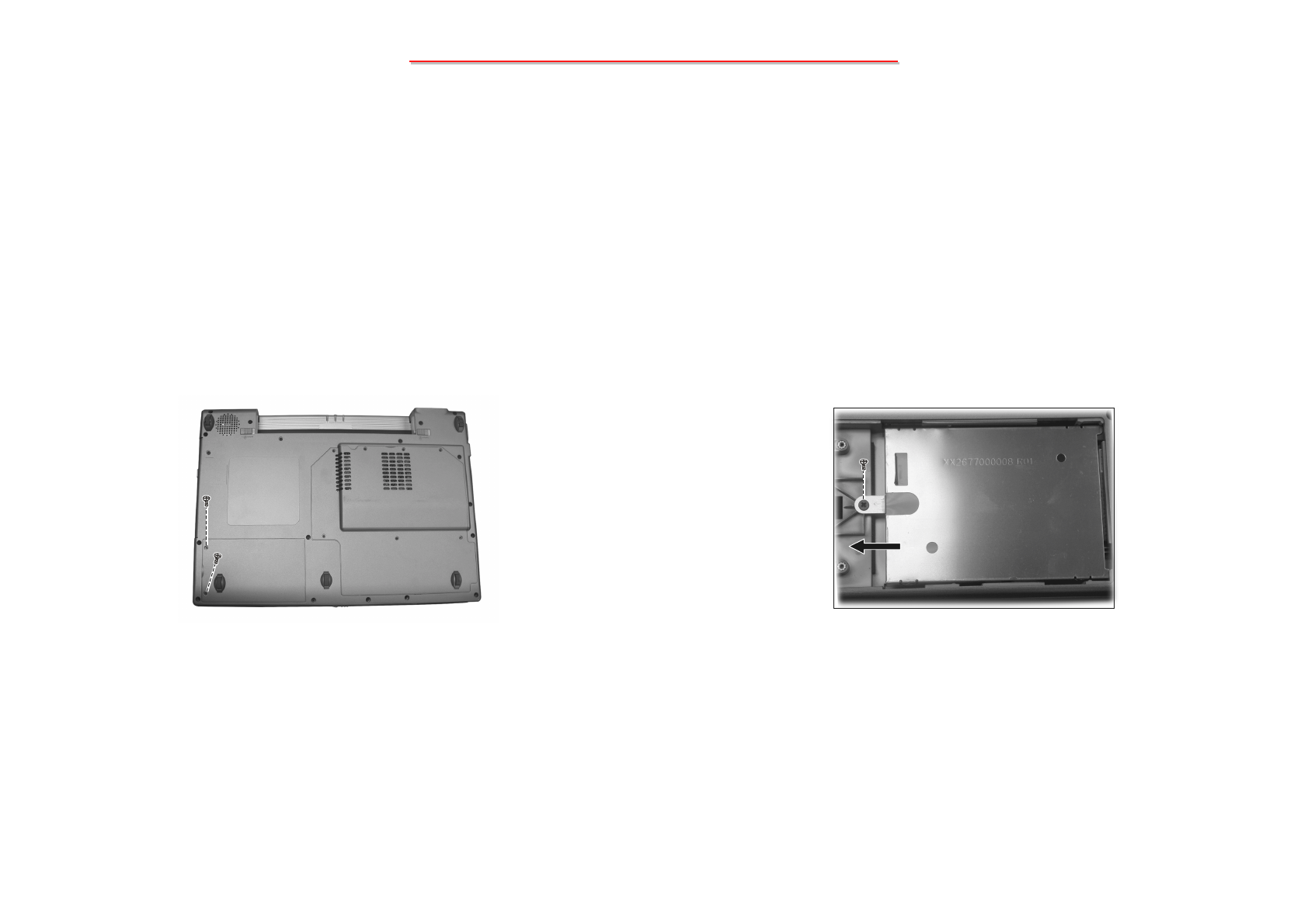
59
80
8050QMA
50QMA N/B Maintenance
N/B Maintenance
2.3.4 HDD Module
Figure 2-8 Remove HDD moduleFigure 2-7 Remove the HDD compartment
cover
Disassembly
1. Carefully put the notebook upside down. Remove the battery pack. (Refer to section 2.3.1 Disassembly)
2. Remove the two screws fastening the HDD compartment cover. (Figure 2-7)
3. Remove the one screw and slide the HDD module out of the compartment. (Figure 2-8)
MiTac Secret
Confidential Document

60
80
8050QMA
50QMA N/B Maintenance
N/B Maintenance
4. Remove the four screws to separate the hard disk drive from the bracket, remove the hard disk drive. (Figure 2-9)
Reassembly
1. Attach the bracket to hard disk drive and secure with four screws.
2. Slide the HDD module into the compartment and secure with one screw.
3. Place the HDD compartment cover and secure with two screws.
4. Replace the battery pack. (Refer to section 2.3.1 Reassembly)
Figure 2-9 Remove hard disk drive
MiTac Secret
Confidential Document

61
80
8050QMA
50QMA N/B Maintenance
N/B Maintenance
1. Push the CD/DVD-ROM drive into the compartment and secure with one screw.
2. Replace the battery pack. (See section 2.3.1 Reassembly)
Disassembly
1. Carefully put the notebook upside down. Remove the battery pack. (See section 2.3.1 Disassembly)
2. Remove the one screw fastening the CD/DVD-ROM drive. (Figure 2-10)
3. Insert a small rod, such as a straightened paper clip, into CD/DVD-ROM drive’s manual eject hole () and
push firmly to release the tray. Then gently pull out the CD/DVD-ROM drive by holding the tray that pops
out ().
2.3.5 CD/DVD-ROM Drive
Reassembly
Figure 2-10 Remove the CD/DVD-ROM drive
MiTac Secret
Confidential Document

62
80
8050QMA
50QMA N/B Maintenance
N/B Maintenance
1. To install the DDR, match the DDR's notched part with the socket's projected part and firmly insert the
SO-DIMM into the socket at 20-degree angle. Then push down until the retaining clips lock the DDR into
position.
2. Replace the CPU cover and secure with seven screws. (Refer to the step 3 of section 2.3.3 Reassembly)
3. Replace the battery pack. (See section 2.3.1 Reassembly)
Disassembly
1. Carefully put the notebook upside down. Remove the battery pack. (See section 2.3.1 Disassembly)
2. Remove the seven screws fastening the CPU cover. (Refer to the step 2 of section 2.3.3 Disassembly)
2.3.6 DDR-SDRAM
3. Pull the retaining clips outwards () and remove the SO-DIMM (). (Figure 2-11)
Reassembly
Figure 2-11 Remove the SO-DIMM
MiTac Secret
Confidential Document

63
80
8050QMA
50QMA N/B Maintenance
N/B Maintenance
2.3.7 Modem Card
Figure 2-12 Remove two screws Figure 2-13 Disconnect the cord
1. Reconnect the cord and fit the modem card.
2. Fasten the modem card by two screws.
3. Replace the CPU cover by seven screws. (Refer to step 3 of section 2.3.3 Reassembly).
4. Replace the battery pack. (Refer to section 2.3.1 Reassembly)
Disassembly
1. Carefully put the notebook upside down. Remove the battery pack. (Refer to section 2.3.1 Disassembly)
2. Remove seven screws fastening CPU cover. (Refer to step 2 of section 2.3.3 Disassembly)
3. Remove two screws fastening the modem card. (Figure 2-12)
4. Lift up the modem card and disconnect the cord. (Figure 2-13)
Reassembly
MiTac Secret
Confidential Document

64
80
8050QMA
50QMA N/B Maintenance
N/B Maintenance
2.3.8 LCD ASSY
Figure 2-14 Remove the eighteen screws
and separate the antenna
Figure 2-15 Free the top cover
Disassembly
1. Remove the battery pack, keyboard, CPU, hard disk drive, CD/DVD-ROM drive, DDR and modem card.
(See sections 2.3.1, 2.3.2, 2.3.3, 2.3.4, 2.3.5, 2.3.6 and 2.3.7 Disassembly)
2. Remove the eighteen screws fastening the housing and separate the antenna from the Mini PCI compartment.
(Figure 2-14)
3. Disconnect the touch pad’s cable from the system board and remove the two screws, then free the top cover.
(Figure 2-15)
MiTac Secret
Confidential Document

65
80
8050QMA
50QMA N/B Maintenance
N/B Maintenance
4. Remove the seven screws and lift the top shielding up, then free the top shielding. (Figure 2-16)
5. Separate the antenna and disconnect the two cables from the system board. (Figure 2-17)
Figure 2-16 Remove the seven screws Figure 2-17 Disconnect the two cables
and separate the antenna
MiTac Secret
Confidential Document

66
80
8050QMA
50QMA N/B Maintenance
N/B Maintenance
6. Remove the two screws and lift the two hinge covers up, then free the two hinge covers. (Figure 2-18)
7. Remove the four screws, then free the LCD assembly. (Figure 2-19)
Figure 2-18 Free the two hinge covers Figure 2-19 Free the LCD assembly
1. Attach the LCD assembly to the base unit and secure with four screws.
2. Replace the antenna back into Mini PCI compartment.
3. Reconnect the two cables to the system board.
4. Replace the two hinge covers and secure with two screws.
5. Replace the top shielding and secure with seven screws.
6. Replace the top cover and secure with two screws, then reconnect the touch pad’s cable into the system board.
7. Secure with eighteen screws fasten the housing.
8. Replace the modem card, DDR, CD/DVD-ROM drive, hard disk drive, CPU, keyboard and battery pack.
(Refer to previous section reassembly)
Reassembly
MiTac Secret
Confidential Document

67
80
8050QMA
50QMA N/B Maintenance
N/B Maintenance
2.3.9 LCD Panel
Disassembly
1. Remove the battery, keyboard, CPU, hard disk drive, CD/DVD-ROM drive, DDR, modem card and LCD
assembly. (Refer to section 2.3.1, 2.3.2, 2.3.3, 2.3.4, 2.3.5, 2.3.6, 2.3.7 and 2.3.8 Disassembly)
2. Remove the two rubber pads and two screws on the corners of the panel. (Figure 2-20)
3. Insert a flat screwdriver to the lower part of the LCD cover and gently pry the frame out. Repeat the process
until the cover is completely separated from the housing.
4. Remove the ten screws and disconnect the cable. (Figure 2-21)
Figure 2-21 Remove the ten screws and
disconnect the cable
Figure 2-20 Remove LCD cover
MiTac Secret
Confidential Document

68
80
8050QMA
50QMA N/B Maintenance
N/B Maintenance
Reassembly
1. Replace the cable to the LCD panel.
2. Attach the LCD panel’s brackets back to LCD panel and secure with four screws.
3. Replace the LCD panel into LCD housing and secure with ten screws.
4. Reconnect one cable to inverter board.
5. Fit the LCD cover and secure with two screws and rubber pads.
6. Replace the LCD assembly, modem card, DDR, CD/DVD-ROM drive, hard disk drive, CPU, keyboard and
battery pack. (Refer to previous section reassembly)
Figure 2-23 Free the LCD panel
5. Remove the four screws that secure the LCD brackets. (Figure 2-22)
6. Disconnect the cable to free the LCD panel. (Figure 2-23)
Figure 2-22 Remove the four screws
MiTac Secret
Confidential Document

69
80
8050QMA
50QMA N/B Maintenance
N/B Maintenance
2.3.10 Inverter Board
Disassembly
1. Remove the battery, keyboard, CPU, hard disk drive, CD/DVD-ROM drive, DDR, modem card, LCD
assembly and LCD panel. (Refer to section 2.3.1, 2.3.2, 2.3.3, 2.3.4, 2.3.5, 2.3.6, 2.3.7, 2.3.8 and 2.3.9
Disassembly)
2. Remove the one screw fastening the inverter board, then free the inverter board. (Figure 2-24)
Figure 2-24 Free the inverter board
Reassembly
1. Fit the inverter board back into place and secure with one screw.
2. Replace the LCD panel, LCD assembly, modem card, DDR, CD/DVD-ROM drive, hard disk drive, CPU
keyboard and battery pack. (Refer to previous section reassembly)
MiTac Secret
Confidential Document

70
80
8050QMA
50QMA N/B Maintenance
N/B Maintenance
2.3.11 System Board
Figure 2-25 Remove the two screws Figure 2-26 Remove the two screws
Disassembly
1. Remove the battery, keyboard, CPU, hard disk drive, CD/DVD-ROM drive, DDR, modem card and LCD
assembly. (Refer to sections 2.3.1, 2.3.2, 2.3.3, 2.3.4, 2.3.5, 2.3.6, 2.3.7 and 2.3.8 Disassembly)
2. Remove the two screws fastening the housing. (Figure 2-25)
3. Remove the two screws fastening the housing. (Figure 2-26)
MiTac Secret
Confidential Document

71
80
8050QMA
50QMA N/B Maintenance
N/B Maintenance
4. Disconnect the three speakers’ cables from the system board and separate the (R&L) rear covers. (Figure 2-27)
5. Remove the four screws and lift the system board from the housing. (Figure 2-28)
Figure 2-27 Disconnect the cables and
separate the rear covers
Figure 2-28 Remove the four screws
MiTac Secret
Confidential Document

72
80
8050QMA
50QMA N/B Maintenance
N/B Maintenance
Reassembly
1. Fit the system board into the I/O bracket and secure with two screws.
2. Replace the system board into the housing and secure with four screws.
3. Reconnect the three speakers’ cables into the system board and replace the (R&L) rear covers.
4. Secure with four screws fasten the housing.
5. Replace the LCD assembly, modem card, DDR, CD/DVD-ROM drive, hard disk drive, CPU, keyboard and
battery pack. (Refer to the section 2.3.8, 2.3.7, 2.3.6, 2.3.5, 2.3.4, 2.3.3, 2.3.2 and 2.3.1 Reassembly)
6. Remove the two screws and separate the I/O bracket from the system board, then free the system board.
(Figure 2-29)
Figure 2-29 Free the system board
MiTac Secret
Confidential Document

73
80
8050QMA
50QMA N/B Maintenance
N/B Maintenance
2.3.12 Touch Pad
1. Remove the battery pack, keyboard, CPU, hard disk drive, CD/DVD-ROM drive, DDR and modem card.
(See sections 2.3.1, 2.3.2, 2.3.3, 2.3.4, 2.3.5, 2.3.6 and 2.3.7 Disassembly)
2. Remove the top cover. (Refer to the steps 1-3 of 2.3.8 section Disassembly)
3. Remove the four screws and lift the shielding, then free the touch pad. (Figure 2-30)
Disassembly
Figure 2-30 Free the touch pad
Reassembly
1. Replace the touch pad, then fit the shielding and secure with two screws.
2. Replace the top cover. (Refer to the step 6 of section 2.3.8 Disassembly)
3. Replace the modem card, DDR, CD/DVD-ROM drive, hard disk drive, CPU, keyboard and battery pack.
(See sections 2.3.8, 2.3.7, 2.3.6, 2.3.5, 2.3.4, 2.3.3, 2.3.2 and 2.3.1 Reassembly)
MiTac Secret
Confidential Document

74
80
8050QMA
50QMA N/B Maintenance
N/B Maintenance
3. Definition & Location of Connectors / Switches
3.1 Mother Board (Side A)
J8
J2
J1
J3
J5
J4
J7
SW3
SW4
SW2
J1 : Inverter Board Connector
J2 : LCD Panel Connector
J3 : Internal Left Speaker Connector
J4 : Touch-pad Module Connector
J5 : Internal Key-board Connector
J7 : Internal Right Speaker Connector
J8 : PCMCIA Card Connector
SW2 : Power Button
SW3 : Left Button Switch of Touch-pad
SW4 : Right Button Switch of Touch-pad
MiTac Secret
Confidential Document

75
80
8050QMA
50QMA N/B Maintenance
N/B Maintenance
3. Definition & Location of Connectors / Switches
3.2 Mother Board (Side B)
J706
PJ701
J701 J716
J713
J714
J501
J703
J710 J715
J702
J502
J709
J507
J704 J503
J504
J720
J721
J508
J509
J719
J723
PJ701 : AC Adaptor Connector
J701&J706 : USB Port Connector
J702 : DVI Connector
J703 : Battery Connector
J704 : S-video Connector
J709 : RJ45 & RJ11 Connector
J710 : CD-ROM IDE Connector
J713&J714 : DDR SO-DIMM Module Socket
J715 : Hard Disk Driver Connector
J716 : Mini-PCI Connector
J723 : MXM_Connector
J501 : Internal Subwoofer Speaker
J502 : FAN Connector
J504 : FAN Connector
J508 : MS/SD/MMC Connector
MiTac Secret
Confidential Document
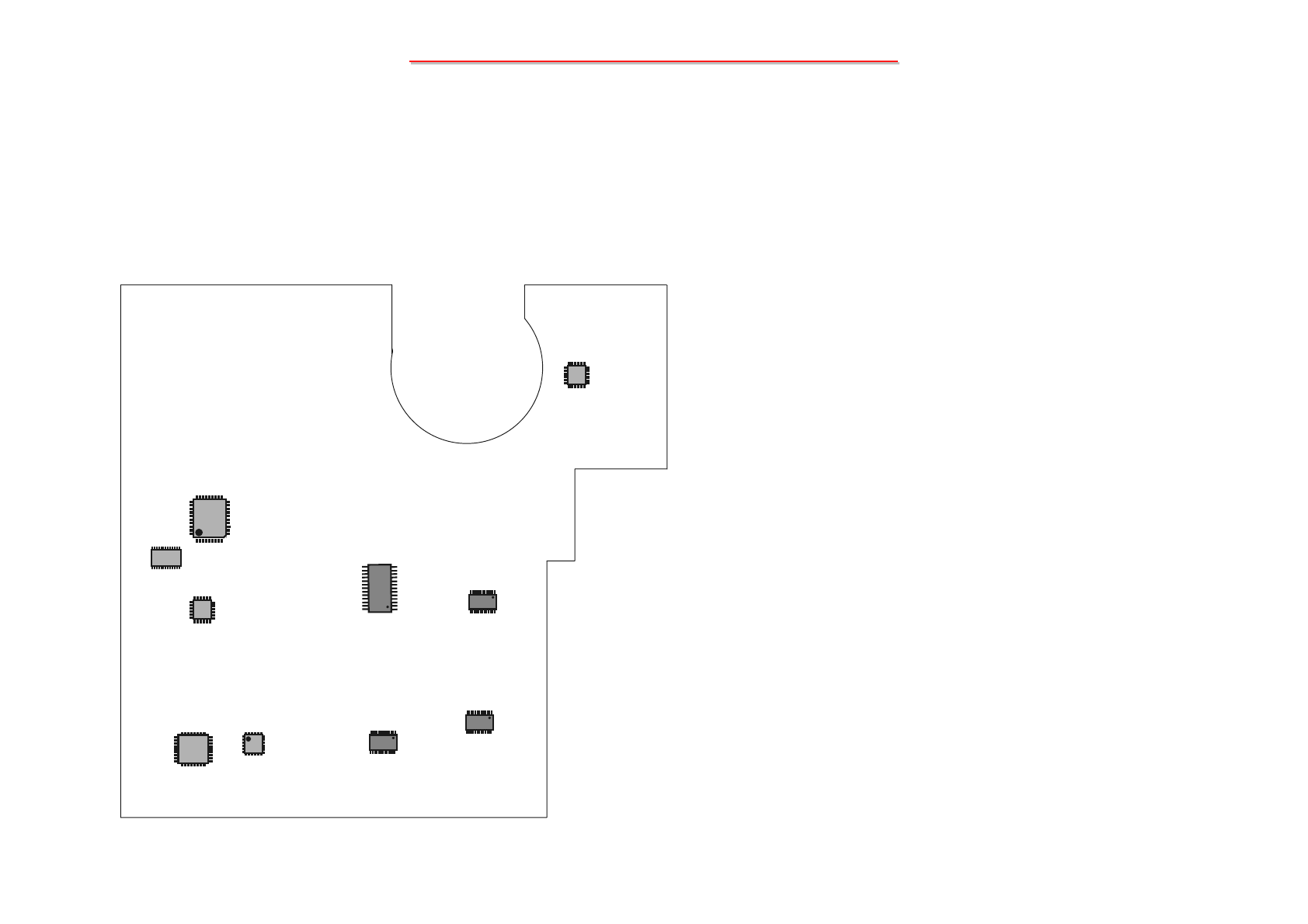
76
80
8050QMA
50QMA N/B Maintenance
N/B Maintenance
4. Definition & Location of Major Components
4.1 Mother Board (Side A)
PU2
PU12
U13
U19
U14
PU5
PU6
PU3
U7
U18
PU2 : +3VS/+5VS Voltage Generator
PU3 : Charging Voltage Controller
PU5 : CPU_Core Voltage Generator
PU6 : +1.5VS/+1.05VS Voltage Generator
PU12 : +1.8V_P/0.9VS_P Voltage Generate
U7 : CLOCK SYNTHERIZER
U13 : WINBOND KBC Controller
U14 : SYSTEM BIOS
U18 : SUBWOOFER AMP Controller
U19 : AUDIO AMPLIFIER
MiTac Secret
Confidential Document

77
80
8050QMA
50QMA N/B Maintenance
N/B Maintenance
4. Definition & Location of Major Components
4.2 Mother Board (Side B)
U710
U711
U717
U722
U724
U709
U517
U709 : Intel ICH6-M South Bridge
U710 : Intel 915PM North Bridge
U711 : Intel Dothan CPU
U717 : LAN-RTL8100CL Controller
U722 : IEEE1394 Controller
U724 : Serial ATA Bridge 88SA8040
U517 : Audio CODEC(ALC655)
MiTac Secret
Confidential Document

78
80
8050QMA
50QMA N/B Maintenance
N/B Maintenance
5.1 Intel 915PM North Bridge(1)
Host Interface Signals
Signal Name Type Description
HADS# I/O
AGTL+ Host Address Strobe:
The system bus owner asserts HADS# to indicate the first of two
cycles of a request phase. The GMCH can also assert this signal for
snoop cycles and interrupt messages.
HBNR# I/O
AGTL+ Host Block Next Request:
Used to block the current request bus owner from issuing a new
request. This signal is used to dynamically control the CPU bus
pipeline depth.
HBPRI# O
AGTL+ Host Bus Priority Request:
The GMCH is the only Priority Agent on the system bus. It asserts
this signal to obtain the ownership of the address bus. This signal has
priority over symmetric bus requests and will cause the current
symmetric owner to stop issuing new transactions unless the
HLOCK# signal was asserted.
HBREQ0# I/O
AGTL+ Host Bus Request 0#:
The GMCH pulls the processor bus HBREQ0# signal low during
HCPURST#. The signal is sampled by the processor on the
active-to-inactive transition of HCPURST#.
HBREQ0# should be tri-stated after the hold time requirement has
been satisfied.
HCPURST# O
AGTL+ Host CPU Reset:
The CPURST# pin is an output from the GMCH. The GMCH asserts
HCPURST# while RSTIN# is asserted and for approximately 1 ms
after RSTIN# is deasserted. HCPURST# allows the processor to
begin execution in a known state.
HDBSY# I/O
AGTL+ Host Data Bus Busy:
Used by the data bus owner to hold the data bus for transfers
requiring more than one cycle.
HDEFER# O
AGTL+ Host Defer:
Signals that the GMCH will terminate the transaction currently being
snooped with either a deferred response or with a retry response.
HDINV[3:0]# I/O
AGTL+ Host Dynamic Bus Inversion:
Driven along with the HFD[63:0]# signals. Indicates if the associated
signals are inverted or not. HDINVF[3:0]# are asserted such that the
number of data bits driven electrically low (low voltage) within the
corresponding 16-bit group never exceeds 8.
HDINV# Data Bits
HDINV[3]# HD[63:48]#
HDINV[2]# HD[47:32]#
HDINV[1]# HD[31:16]#
HDINV[0]# HD[15:0]#
Host Interface Signals (Continued)
Signal Name Type Description
HDRDY# I/O
AGTL+ Host Data Ready:
Asserted for each cycle that data is transferred.
HA[31:3]# I/O
AGTL+
2X
Host Address Bus:
HA[31:3]# connects to the CPU address bus. During processor cycles
the HA[31:3]# are inputs. The GMCH drives HA[31:3]# during
snoop cycles on behalf of DMI.
HA[31:3]# are transferred at 2x rate.
Note that the address is inverted on the CPU bus.
HADSTB[1:0]# I/O
AGTL+
2X
Host Address Strobe:
HA[31:3]# connects to the CPU address bus. During CPU cycles, the
source synchronous strobes are used to transfer HA[31:3]# and
HREQ[4:0]# at the 2x transfer rate.
Strobe Address Bits
HADSTB[0]# HA[16:3]#, HREQ[4:0]#
HADSTB[1]# HA[31:17]#
HD[63:0]# I/O
AGTL+
4X
Host Data:
These signals are connected to the CPU data bus. HD[63:0]# are
transferred at 4x rate.
Note that the data signals are inverted on the CPU bus depending on
the HDINV[3:0]# signals.
HDSTBP[3:0]#
HDSTBN[3:0]#
I/O
AGTL+
4X
Host Differential Host Data Strobes:
The differential source synchronous strobes are used to transfer
HD[63:0]# and HDINV[3:0]# at the 4x transfer rate.
Strobe Data Bits
HDSTBP[3]#, HDSTBN[3]# HD[63:48]#, HDINV[3]#
HDSTBP[2]#, HDSTBN[2]# HD[47:32]#, HDINV[2]#
HDSTBP[1]#, HDSTBN[1]# HD[31:16]#, HDINV[1]#
HDSTBP[0]#, HDSTBN[0]# HD[15:00]#, HDINV[0]#
HHIT# I/O
AGTL+ Host Hit:
Indicates that a caching agent holds an unmodified version of the
requested line.
Also, driven in conjunction with HITM# by the target to extend the
snoop window.
HHITM# I/O
AGTL+ Host Hit Modified:
Indicates that a caching agent holds a modified version of the
requested line and that this agent assumes responsibility for providing
the line.
Also, driven in conjunction with HIT# to extend the snoop window.
5. Pin Descriptions of Major Components
MiTac Secret
Confidential Document

79
80
8050QMA
50QMA N/B Maintenance
N/B Maintenance
5.1 Intel 915PM North Bridge(2)
Host Interface Signals (Continued)
Signal Name Type Description
HLOCK# I
AGTL+ Host Lock:
All CPU bus cycles sampled with the assertion of HLOCK# and
HADS#, until the negation of HLOCK# must be atomic, i.e. PCI
Express graphics access to System Memory is allowed when
HLOCK# is asserted by the CPU.
HREQ[4:0]# I/O
AGTL+
2X
Host Request Command:
Defines the attributes of the request. HREQ[4:0]# are transferred at
2x rate.
Asserted by the requesting agent during both halves of the Request
Phase. In the first half the signals define the transaction type to a level
of detail that is sufficient to begin a snoop request. In the second half
the signals carry additional information to define the complete
transaction type.
HTRDY# O
AGTL+ Host Target Ready:
Indicates that the target of the processor transaction is able to enter
the data transfer phase.
HRS[2:0]# O
AGTL+ Host Response Status:
Indicates the type of response according to the following the table:
HRS[2:0]# Response type
000 Idle state
001 Retry response
010 Deferred response
011 Reserved (not driven by GMCH)
100 Hard Failure (not driven by GMCH)
101 No data response
110 Implicit Write back
111 Normal data response
HDPWR# O
AGTL+ Host Data Power:
Used by GMCH to indicate that a data return cycle is pending within
2 HCLK cycles or more. CPU use’s this signal during a read-cycle to
activate the data input buffers in preparation for HDRDY# and the
related data.
HCPUSLP# O
CMOS Host CPU Sleep:
When asserted in the Stop-Grant state, causes the processor to enter
the Sleep state. During Sleep state, the processor stops providing
internal clock signals to all units, leaving only the Phase-Locked
Loop (PLL) still operating. Processors in this state will not recognize
snoops or interrupts.
Host Interface Reference and Compensation
Signal Name Type Description
HVREF I
A Host Reference Voltage:
Reference voltage input for the Data, Address, and Common clock
signals of the Host AGTL+ interface.
HXRCOMP I/O
A Host X RCOMP:
Used to calibrate the Host AGTL+ I/O buffers.
This signal is powered by the Host Interface termination rail (VCCP).
HXSCOMP I/O
A Host X SCOMP:
Slew Rate Compensation for the Host Interface
HXSWING I
A Host X Voltage Swing:
These signals provide reference voltages used by the HXRCOMP
circuits.
HYRCOMP I/O
A Host Y RCOMP:
Used to calibrate the Host AGTL+ I/O buffers.
HYSCOMP I/O
A Host Y SCOMP:
Slew Rate Compensation for the Host Interface
HYSWING I
A Host Y Voltage Swing:
These signals provide reference voltages used by the HYRCOMP
circuitry.
DMI
Signal Name Type Description
DMI_RXP[1:0]
DMI_RXN[1:0]
I
PCIE DMI input from ICH6-M:
Direct Media Interface receive differential pair
DMI_TXP[1:0]
DMI_TXN[1:0]
O
PCIE DMI output to ICH6-M:
Direct Media Interface transmit differential pair
DMI x2 is supported for Intel 915GMS chipset
MiTac Secret
Confidential Document

80
80
8050QMA
50QMA N/B Maintenance
N/B Maintenance
5.1 Intel 915PM North Bridge(3)
DDR / DDR2 SDRAM Channel A Interface
Signal Name Type Description
SA_DQ[63:0] I/O
SSTL1.8/2
2x
Data Bus:
DDR / DDR2 Channel A data signal interface to the SDRAM data
bus.
Single channel mode: Route to SO-DIMM 0 & SO-DIMM1
Dual channel mode: Route to SO-DIMM A
SA_DM[7:0] I/O
SSTL1.8/2
2x
Data Mask:
These signals are used to mask individual bytes of data in the case of
a partial write, and to interrupt burst writes.
When activated during writes, the corresponding data groups in the
SDRAM are masked. There is one SA_DM[7:0] for every data byte
lane.
Single channel mode: Route to SO-DIMM 0 & SO-DIMM1
Dual channel mode: Route to SO-DIMM A
SA_DQS[7:0] I/O
SSTL1.8
2x
Data Strobes:
DDR: The rising and falling edges of SA_DQS[7:0] are used for
capturing data during read and write transactions.
DDR2: SA_DQS[7:0] and its complement signal group make up a
differential strobe pair. The data is captured at the crossing point of
SA_DQS[7:0] and its SA_DQS[7:0]# during read and write
transactions.
Single channel mode: Route to SO-DIMM 0 & SO-DIMM1
Dual channel mode: Route to SO-DIMM A
SA_DQS[7:0]# I/O
SSTL1.8
2x
Data Strobe Complements
DDR1: No Connect. These signals are not used for DDR devices
DDR2 : These are the complementary DDR2 strobe signals.
Single channel mode: Route to SO-DIMM 0 & SO-DIMM1
Dual channel mode: Route to SO-DIMM A
SA_MA[13:0] O
SSTL1.8/2 Memory Address:
These signals are used to provide the multiplexed row and column
address to the SDRAM.
Single channel mode: Route to SO-DIMM 0
Dual channel mode: Route to SO-DIMM A
Note: SA_MA13 is for support of 1 Gb devices.
SA_BS[2:0] O
SSTL1.8/2 Bank Select:
These signals define which banks are selected within each SDRAM
rank.
Single channel mode: Route to SO-DIMM 0
Dual channel mode: Route to SO-DIMM A
Note: SA_BS2 is for support for DDR2 only for 8 bank devices.
DDR / DDR2 SDRAM Channel A Interface (Continued)
Signal Name Type Description
SA_RAS# O
SSTL1.8/2 RAS Control signal:
Used with SA_CAS# and SA_WE# (along with SM_CS#) to define
the SDRAM commands.
Single channel mode: Route to SO-DIMM 0
Dual channel mode: Route to SO-DIMM A
SA_CAS# O
SSTL1.8/2 CAS Control signal:
Used with SA_RAS# and SA_WE# (along with SM_CS#) to define
the SDRAM commands.
Single channel mode: Route to SO-DIMM 0
Dual channel mode: Route to SO-DIMM A
SA_WE# O
SSTL1.8/2 Write Enable Control signal:
Used with SA_RAS# and SA_CAS# (along with SM_CS#) to define
the SDRAM commands.
Single channel mode: Route to SO-DIMM 0
Dual channel mode: Route to SO-DIMM A
SA_RCVENIN# O
SSTL1.8/2 Clock Input:
Used to emulate source-synch clocking for reads. Connects internally
to SA_RCVENOUT#.
Leave as No Connect.
SA_RCVENOUT
#
O
SSTL1.8/2 Clock Output:
Used to emulate source-synch clocking for reads. Connects internally
to SA_RCVENIN#.
Leave as No Connect.
PCI Express Based Graphics Interface Signals
Signal Name Type Description
EXP_RXN[15:0]
EXP_RXP[15:0]
I
PCIE
PCI Express Receive Differential Pair
EXP_TXN[15:0]
EXP_TXP[15:0]
O
PCIE
PCI Express Transmit Differential Pair
EXP_ICOMPO I
A
PCI Express Output Current and Resistance Compensation
EXP_COMPI I
A
PCI Express Input Current Compensation
PCI Express Based Graphics is supported for Intel 915GM and Intel 915PM chipsets.
MiTac Secret
Confidential Document

81
80
8050QMA
50QMA N/B Maintenance
N/B Maintenance
5.1 Intel 915PM North Bridge(4)
DDR / DDR2 SDRAM Channel B Interface
Signal Name Type Description
SB_DQ[63:0] I/O
SSTL1.8/2
2x
Data Lines:
DDR / DDR2 Channel B data signal interface to the SDRAM data
bus.
Single Channel mode: No connect.
Dual channel mode: Route to SO-DIMM B
NOTE: Signals do not exist in Intel 915GMS.
SB_DM[7:0] O
SSTL1.8/2
2x
Data Mask:
When activated during writes, the corresponding data groups in the
SDRAM are masked. There is one SB_DM[7:0] for every data byte
lane. These signals are used to mask individual bytes of data in the
case of a partial write, and to interrupt burst writes.
Single Channel mode: No connect.
Dual channel mode: Route to SO-DIMM B
NOTE: Signals do not exist in Intel 915GMS.
SB_DQS[7:0] I/O
SSTL1.8/2
2x
Data Strobes:
DDR: The rising and falling edges of SB_DQS[7:0] are used for
capturing data during read and write transactions.
DDR2: SB_DQS[7:0] and its complement signal group make up a
differential strobe pair. The data is captured at the crossing point of
SB_DQS[7:0] and its SB_DQS[7:0]# during read and write
transactions.
Single Channel mode: No connect.
Dual channel mode: Route to SO-DIMM B
NOTE: Signals do not exist in Intel 915GMS.
SB_DQS[7:0]# I/O
SSTL1.8
2x
Data Strobe Complements (DDR2 only):
DDR1: No Connect. These signals are not used for DDR devices
DDR2 : These are the complementary DDR2 strobe signals.
Single Channel mode: No connect.
Dual channel mode: Route to SO-DIMM B
NOTE: Signals do not exist in Intel 915GMS.
SB_MA[13:0] O
SSTL1.8/2 Memory Address:
These signals are used to provide the multiplexed row and column
address to the SDRAM.
Single channel mode: Route to SO-DIMM 1
Dual channel mode: Route to SO-DIMM B
NOTE: SB_MA13 is for support of 1 Gb devices.
SB_BS[2:0] O
SSTL1.8/2 Bank Select:
These signals define which banks are selected within each
SDRAM rank.
Single channel mode: Route to SO-DIMM 1
Dual channel mode: Route to SO-DIMM B
NOTE: SB_BS2 is for DDR2 support only.
DDR / DDR2 SDRAM Channel B Interface (Continued)
Signal Name Type Description
SB_RAS# O
SSTL1.8/2 RAS Control signal:
Used with SB_CAS# and SB_WE# (along with SM_CS#) to define
the SDRAM commands.
Single channel mode: Route to SO-DIMM 1
Dual channel mode: Route to SO-DIMM B
SB_CAS# O
SSTL1.8/2 CAS Control signal:
Used with SB_RAS# and SB_WE# (along with SM_CS#) to define
the SDRAM commands.
Single channel mode: Route to SO-DIMM 1
Dual channel mode: Route to SO-DIMM B
SB_WE# O
SSTL1.8/2 Write Enable Control signal:
Used with SB_RAS# and SB_CAS# (along with SM_CS#) to define
the SDRAM commands.
Single channel mode: Route to SO-DIMM 1
Dual channel mode: Route to SO-DIMM B
SB_RCVENIN# I
SSTL1.8/2 Clock Input:
Used to emulate source-synch clocking for reads.
Leave as No Connect.
NOTE: Signals do not exist in Intel 915GMS.
SB_RCVENOUT
# O
SSTL1.8/2 Clock Output:
Used to emulate source-synch clocking for reads.
Leave as No Connect.
NOTE: Signals do not exist in Intel 915GMS.
DMI
Signal Name Type Description
DMI_RXP[3:0]
DMI_RXN[3:0]
I
PCIE DMI input from ICH6-M:
Direct Media Interface receive differential pair
DMI_TXP[3:0]
DMI_TXN[3:0]
O
PCIE DMI output to ICH6-M:
Direct Media Interface transmit differential pair
DMI x2 or x4 is supported for Intel 915GM, Intel 915PM and Intel 910GML chipsets.
MiTac Secret
Confidential Document

82
80
8050QMA
50QMA N/B Maintenance
N/B Maintenance
5.1 Intel 915PM North Bridge(5)
DDR / DDR2 Common Signals
Signal Name Type Description
SM_CK[1:0],
SM_CK[4:3] O
SSTL1.8/2 SDRAM Differential Clock:
The crossing of the positive edge of SM_CKx and the negative edge
of its complement SM_CKx# are used to sample the command and
control signals on the SDRAM.
SM_CK[0:1] and its complement SM_CK[1:0]# signal make a
differential clock pair output.
Single channel mode: Route to SO-DIMM 0
Dual channel mode: Route to SO-DIMM A
SM_CK[4:3] and its complement SM_CK[4:3]# signal make a
differential clock pair output.
Single channel mode: Route to SO-DIMM 1
Dual channel mode: Route to SO-DIMM B
NOTE: SM_CK2 and SM_CK5 are reserved and not supported.
SM_CK[1:0]#,
SM_CK[4:3]# O
SSTL1.8/2 SDRAM Inverted Differential Clock:
These are the complementary Differential DDR2 Clock signals.
NOTE: SM_CK2# and SM_CK5# are reserved and not supported.
SM_CS[3:0]# O
SSTL1.8/2 Chip Select: (1 per Rank):
These signals select particular SDRAM components during the active
state. There is one Chip Select for each SDRAM rank
SM_CS[1:0]# :
Single channel mode: Route to SO-DIMM 0
Dual channel mode: Route to SO-DIMM A
SM_CS[3:2]# :
Single channel mode: Route to SO-DIMM 1
Dual channel mode: Route to SO-DIMM B
SM_CKE[3:0] O
SSTL1.8/2 Clock Enable: (1 per Rank):
SM_CKE[3:0] is used:
.To initialize the SDRAMs during power-up
.To power-down SDRAM ranks
. To place all SDRAM ranks into and out of self-refresh during STR.
SM_CKE[1:0]:
Single channel mode: Route to SO-DIMM 0
Dual channel mode: Route to SO-DIMM A
SM_CKE[3:2]:
Single channel mode: Route to SO-DIMM 1
Dual channel mode: Route to SO-DIMM B
DDR / DDR2 Common Signals (Continued)
Signal Name Type Description
SM_ODT[3:0] O
SSTL1.8/2 On Die Termination: Active Termination Control. (DDR2 only)
SM_ODT[1:0]:
Single channel mode: Route to SO-DIMM 0
Dual channel mode: Route to SO-DIMM A
Signal Description
The crossing of the positive edge of SM_CKx and the negative edge
of its
complement SM_CKx# are used to sample the command and control
SM_CK[0:1] and its complement SM_CK[1:0]# signal make a
differential
SM_CK[4:3] and its complement SM_CK[4:3]# signal make a
differential
NOTE: SM_CK2 and SM_CK5 are reserved and not supported.
These are the complementary Differential DDR2 Clock signals.
NOTE: SM_CK2# and SM_CK5# are reserved and not supported.
These signals select particular SDRAM components during the active
To place all SDRAM ranks into and out of self-refresh during STR.
On Die Termination: Active Termination Control. (DDR2 only)
SM_ODT[3:2]:
Single channel mode: Route to SO-DIMM 1
Dual channel mode: Route to SO-DIMM B
DDR: Leave as no connects. Not used for DDR devices.
DDR2: On-die termination for DDR2 devices.
MiTac Secret
Confidential Document

83
80
8050QMA
50QMA N/B Maintenance
N/B Maintenance
5.1 Intel 915PM North Bridge(6)
CRT DAC Signals
Signal Name Type Description
RED O
A RED Analog Video Output:
This signal is a CRT Analog video output from the internal color
palette DAC.
RED# O
A RED# Analog Output:
This signal is an analog video output from the internal color palette
DAC. This signal is used to provide noise immunity.
GREEN O
A GREEN Analog Video Output:
This signal is a CRT Analog video output from the internal color
palette DAC.
GREEN# O
A GREEN# Analog Output:
This signal is an analog video output from the internal color palette
DAC. This signal is used to provide noise immunity.
BLUE O
A BLUE Analog Video Output:
This signal is a CRT Analog video output from the internal color
palette DAC.
BLUE# O
A BLUE# Analog Output:
This signal is an analog video output from the internal color palette
DAC. This signal is used to provide noise immunity.
REFSET O
A Resistor Set:
Set point resistor for the internal color palette DAC. A 256-Ω ± 1%
resistor is required between REFSET and motherboard ground.
HSYNC O
HVCMOS CRT Horizontal Synchronization:
This signal is used as the horizontal sync (polarity is programmable)
or “sync interval”.
VSYNC O
HVCMOS CRT Vertical Synchronization:
This signal is used as the vertical sync (polarity is programmable).
Analog TV-out Signals
Signal Name Type Description
TVDAC_A O
A TVDAC Channel A Output:
TVDAC_A supports the following:
Composite: CVBS signal
Component: Chrominance (Pb) analog signal
TVDAC_B O
A TVDAC Channel B Output:
TVDAC_B supports the following:
S-Video: Luminance analog signal
Component: Luminance (Y) analog signal
TVDAC_C O
A TVDAC Channel C Output:
TVDAC_C supports the following:
S-Video: Chrominance analog signal
Component: Chrominance (Pr) analog signal
TV_IRTNA O
A Current Return for TVDAC Channel A:
Connect to ground on board
TV_IRTNB O
A Current Return for TVDAC Channel B:
Connect to ground on board
TV_IRTNC O
A Current Return for TVDAC Channel C:
Connect to ground on board
TV_REFSET O
A TV Resistor set:
TV Reference Current uses an external resistor to set internal
reference voltage levels. A 5-k §Ù ± 0.5% resistor is required
between REFSET and motherboard ground.
MiTac Secret
Confidential Document

84
80
8050QMA
50QMA N/B Maintenance
N/B Maintenance
5.1 Intel 915PM North Bridge(7)
LVDS Signals
Signal Name Type Description
LDVS Channel A
LADATAP[2:0] I/O
LVDS
Channel A differential data output - positive
LADATAN[2:0] I/O
LVDS
Channel A differential data output –negative
LACLKP I/O
LVDS
Channel A differential clock output – positive
LACLKN I/O
LVDS
Channel A differential clock output – negative
LDVS Channel B
LBDATAP[2:0] I/O
LVDS
Channel B differential data output – positive
NOTE: Signals do not exist in Intel 915GMS.
LBDATAN[2:0] I/O
LVDS
Channel B differential data output –negative
NOTE: Signals do not exist in Intel 915GMS.
LBCLKP I/O
LVDS
Channel B differential clock output – positive
NOTE: Signals do not exist in Intel 915GMS.
LBCLKN I/O
LVDS
Channel B differential clock output – negative
NOTE: Signals do not exist in Intel 915GMS.
LFP Panel power and backlight control
LVDD_EN O
HVCMOS
LVDS panel power enable: Panel power control enable control.
This signal is also called VDD_DBL in the CPIS specification and is
used to control the VDC source to the panel logic.
LBKLT_EN O
HVCMOS
LVDS backlight enable: Panel backlight enable control.
This signal is also called ENA_BL in the CPIS specification and is
used to gate power into the backlight circuitry.
LBKLT_CRTL O
HVCMOS
Panel backlight brightness control: Panel brightness control.
This signal is also called VARY_BL in the CPIS specification and is
used as the PWM Clock input signal.
LVDS Reference signals
LIBG I/O
Ref
LVDS Reference Current. –
1.5 kΩ Pull down resistor needed
LVREFH I
Ref
Reserved. - No connect.
LVREFL I
Ref
Reserved. - No connect.
LVBG O
A
Reserve. - No connect
Note: LVDS Channel B interface is not supported and do not exist for Intel 915GMS
DDR SDRAM Reference and Compensation
Signal Name Type Description
SMRCOMPN I/O
A System Memory RCOMP N:
Buffer compensation
This signal is powered by the System Memory rail (2.5 V for DDR,
1.8 V for DDR2).
SMRCOMPP I/O
A System Memory RCOMP P:
Buffer compensation
This signal is powered by the System Memory rail
SMXSLEWIN I
A X Buffer Slew Rate Input control.
SMXSLEWOUT O
A X Buffer Slew Rate Output control.
SMYSLEWIN I
A Y Buffer Slew Rate Input control.
SMYSLEWOUT O
A Y Buffer Slew Rate Output control.
SMVREF[1:0] I
A SDRAM Reference Voltage:
Reference voltage inputs for each DQ, DQS, & RCVENIN#.
Also used during ODT RCOMP.
SMOCDCOMP[1
:0] I
A On-Die DRAM OCD driver compensation
OCD compensation
Display Data Channel (DDC) and GMBUS Support
Signal Name Type Description
LCTLA_CLK I/O
COD
I2C Based control signal (Clock) for External SSC clock chip
control –
LCTLB_DATA I/O
COD
I2C Based control signal (Data) for External SSC clock chip control –
DDCCLK I/O
COD
CRT DDC clock monitor control support
DDCDATA I/O
COD
CRT DDC Data monitor control support
LDDC_CLK I/O
COD
EDID support for flat panel display
LDDC_DATA I/O
COD
EDID support for flat panel display
SDVOCTRL_CL
K I/O
COD
I2C Based control signal (Clock) for SDVO device
SDVOCTRL_DA
TA I/O
COD
I2C Based control signal (Data) for SDVO device
MiTac Secret
Confidential Document

85
80
8050QMA
50QMA N/B Maintenance
N/B Maintenance
5.1 Intel 915PM North Bridge(8)
Serial DVO Interface.
Signal Name Type Description
SDVO B Interface
SDVOB_CLKP O
PCIE
Serial Digital Video B Clock.
Multiplexed with EXP_TXP_3.
SDVOB_CLKN O
PCIE
Serial Digital Video B Clock Complement.
Multiplexed with EXP_TXN_3.
SDVOB_RED O
PCIE
Serial Digital Video B Red Data.
Multiplexed with EXP_TXP_0.
SDVOB_RED# O
PCIE
Serial Digital Video B Red Data Complement.
Multiplexed with EXP_TXN_0.
SDVOB_GREEN O
PCIE
Serial Digital Video B Green Data.
Multiplexed with EXP_TXP_1.
SDVOB_GREEN
# O
PCIE
Serial Digital Video B Green Data Complement.
Multiplexed with EXP_TXN_1.
SDVOB_BLUE O
PCIE
Serial Digital Video B Blue Data.
Multiplexed with EXP_TXP_2.
SDVOB_BLUE# O
PCIE
Serial Digital Video B Blue Data Complement.
Multiplexed with EXP_TXN_2.
SDVO C Interface
SDVOC_RED O
PCIE
Serial Digital Video C Red Data / SDVO B Alpha.
Multiplexed with EXP_TXP_4.
NOTE: Signals do not exist in Intel 915GMS..
SDVOC_RED# O
PCIE
Serial Digital Video C Red Complement / Alpha Complement.
Multiplexed with EXP_TXN_4.
NOTE: Signals do not exist in Intel 915GMS.
SDVOC_GREEN O
PCIE
Serial Digital Video C Green.
Multiplexed with EXP_TXP_5.
NOTE: Signals do not exist in Intel 915GMS.
SDVOC_GREEN
#
O
PCIE
Serial Digital Video C Green Complement.
Multiplexed with EXP_TXN_5.
NOTE: Signals do not exist in Intel 915GMS.
SDVOC_BLUE O
PCIE
Serial Digital Video Channel C Blue.
Multiplexed with EXP_TXP_6.
NOTE: Signals do not exist in Intel 915GMS.
SDVOC_BLUE# O
PCIE
Serial Digital Video C Blue Complement.
Multiplexed with EXP_TXN_6.
NOTE: Signals do not exist in Intel 915GMS.
Serial DVO Interface (Continued)
Signal Name Type Description
SDVO C Interface
SDVOC_CLKP O
PCIE
Serial Digital Video C Clock.
Multiplexed with EXP_TXP_7.
NOTE: Signals do not exist in Intel 915GMS.
SDVOC_CLKN O
PCIE
Serial Digital Video C Clock Complement.
Multiplexed with EXP_TXN_7.
NOTE: Signals do not exist in Intel 915GMS.
SDVO Common Signals
SDVO_TVCLKI
N
I
PCIE
Serial Digital Video TVOUT Synchronization Clock.
Multiplexed with EXP_RXP_0.
SDVO_TVCLKI
N#
I
PCIE
Serial Digital Video TV-out Synchronization Clock Complement.
Multiplexed with EXP_RXN_0.
SDVO_FLDSTA
LL
I
PCIE
Serial Digital Video Field Stall.
Multiplexed with EXP_RXP_2.
SDVO_FLDSTA
LL#
I
PCIE
Serial Digital Video Field Stall Complement.
Multiplexed with EXP_RXN_2.
SDVOB_INT I
PCIE
Serial Digital Video Input Interrupt.
Multiplexed with EXP_RXP_1.
SDVOB_INT# I
PCIE
Serial Digital Video Input Interrupt Complement.
Multiplexed with EXP_RXN_1.
SDVOC_INT I
PCIE
Serial Digital Video Input Interrupt.
Multiplexed with EXP_RXP_5.
SDVOC_INT# I
PCIE
Serial Digital Video Input Interrupt Complement.
Multiplexed with EXP_RXN_5.
MiTac Secret
Confidential Document

86
80
8050QMA
50QMA N/B Maintenance
N/B Maintenance
5.1 Intel 915PM North Bridge(9)
PLL Signals
Signal Name Type Description
HCLKP I
Diff Clk Differential Host Clock In:
Differential clock input for the Host PLL. Used for phase cancellation
for FSB transactions. This clock is used by all of the GMCH logic
that is in the Host clock domain. Also used to generate core and
system memory internal clocks. This is a low voltage differential
signal and runs at ¼ the FSB data rate.
HCLKN I
Diff Clk Differential Host Clock Input Complement:
GCLKP I
Diff Clk Differential PCI Express based Graphics / DMI Clock In:
These pins receive a differential 100 MHz Serial Reference clock
from the external clock synthesizer. This clock is used to generate the
clocks necessary for the support of PCI Express.
GCLKN I
Diff Clk Differential PCI Express based Graphics / DMI Clock In
complement
DREF_CLKP I
Diff Clk Display PLLA Differential Clock In –
Display PLL Differential Clock In, no SSC support –
DREF_CLKN I
Diff Clk Display PLLA Differential Clock In Complement –
Display PLL Differential Clock In Complement - no SSC support
DREF_SSCLKP I
Diff Clk Display PLLB Differential Clock In –
Optional Display PLL Differential Clock In for SSC support –
NOTE: Differential Clock input for optional SSC support for LVDS
display.
DREF_SSCLKN I
Diff Clk Display PLLB Differential Clock In complement –
Optional Display PLL Differential Clock In Complement for SSC
support
NOTE: Differential Clock input for optional SSC support for LVDS
display.
Note: PLL interfaces signal group are supported the Mobile Intel 915GM/PM/GMS and Intel
910GML Express chipsets, unless otherwise noted.
Reset and Miscellaneous Signals
Signal Name Type Description
RSTIN# I
HVCMOS Reset In:
When asserted this signal will asynchronously reset the GMCH logic.
This signal is connected to the PLT_RST# output of the ICH6-M.
This input has a Schmitt trigger to avoid spurious resets. This input
buffer is 3.3-V tolerant.
PWROK I
HVCMOS Power OK:
When asserted, PWROK is an indication to the GMCH that core
power has been stable for at least 10 µs.
This input buffer is 3.3-V tolerant.
H_BSEL [2:0]
(CFG[2:0]) I
HVCMOS Host Bus Speed Select:
At the deassertion of RSTIN#, the value sampled on these pins
determines the expected frequency of the bus.
External pull-ups are required.
CFG[17:3] I
AGTL+ HW straps:
CFG [17:3] has internal pull up.
NOTE: Not all CFG Balls are supported for Intel 915GMS.
CFG[20:18] I
HVCMOS HW straps:
CFG [20:18] has internal pull down
NOTE: Not all CFG Balls are supported for Intel 915GMS.
BM_BUSY# O
HVCMOS GMCH Integrated Graphics Busy:
Indicates to the ICH that the integrated graphics engine within the
MCH is busy and transitions to low power states should not be
attempted until that is no longer the case.
THRMTRIP# O
COD GMCH Thermal Trip:
Assertion of THERMTRIP# (Thermal Trip) indicates the GMCH
junction temperature has reached a level beyond which damage may
occur. Upon assertion of THERMTRIP#, the GMCH will shut off its
internal clocks (thus halting program execution) in an attempt to
reduce the GMCH core junction temperature. To protect GMCH, its
core voltage (Vcc) must be removed following the assertion of
THERMTRIP#. Once activated, THERMTRIP# remains latched
until RSTIN# is asserted. While the assertion of the RSTIN# signal
will deassert THERMTRIP#, if the GMCH’s junction temperature
remains at or above the trip level, THERMTRIP# will again be
asserted.
EXT_TS[1:0]# I
HVCMOS External Thermal Sensor Input:
If the system temperature reaches a dangerously high value then this
signal can be used to trigger the start of system memory throttling.
NOTE: EXT_TS1# functionality is not supported in 915GMS. A pull
up is required on this pin
MiTac Secret
Confidential Document

87
80
8050QMA
50QMA N/B Maintenance
N/B Maintenance
5.1 Intel 915PM North Bridge(10)
Power and Ground
Interface Ball Name Description
Host VTT (VCCP) FSB power supply (1.05 V) - (VCCP)
VCCA_SM VCCASM is the Analog power supply for SM data buffers used for
DLL & other logic (1.5 V)
DRAM
VCCSM System memory power supply (DDR=2.5 V; DDR2=1.8 V)
VCC3G PCI Express / DMI Analog power supply (1.5 V)
VCCA_3GBG PCI Express / DMI band gap power supply (2.5 V)
PCI Express
Based
Graphics /DMI VSSA_3GBG PCI Express / DMI band gap ground
VCCA_HPLL Power supply for the Host VCO in the host/mem/core PLL (1.5 V)
VCCA_MPLL Power supply for the mem VCO in the host/mem/core PLL (1.5 V)
VCCD_HMPL
L
Power Supply for the digital dividers in the HMPLL (1.5 V)
VCCA_3GPLL Power supply for the 3GIO PLL (1.5 V)
VCCA_DPLL
A
Display A PLL power supply (1.5 V)
PLL Analog
VCCA_DPLL
B
Display B PLL power supply (1.5 V)
High Voltage
Interfaces VCCHV Power supply for the HV buffers (2.5 V)
VCCA_CRTD
AC
Analog power supply for the DAC (2.5 V)
VSSA_CRTD
AC
Analog ground for the DAC
CRT DAC
VCC_SYNC Power supply for HSYNC/ VSYNC (2.5 V)
VCCD_LVDS Digital power supply (1.5 V)
VCCTX_LVD
S
Data/Clk Tx power supply (2.5 V)
VCCA_LVDS LVDS analog power supply (2.5 V)
LVDS
VSSALVDS LVDS analog VSS
Power and Ground (Continued)
Interface Ball Name Description
VCCA_TVBG TV DAC Band Gap Power (3.3 V)
VSSA_TVBG TV DAC Band Gap VSS
VCCD_TVDA
C
Dedicated Power Supply for TVDAC (1.5 V)
VCCDQ_TVD
AC
Power Supply for Digital Quiet TVDAC (1.5 V)
VCCA_TVDA
CA
Power Supply for TV Out Channel A (3.3 V)
VCCA_TVDA
CB
Power Supply for TV Out Channel B (3.3 V)
TVDAC
VCCA_TVDA
CC
Power Supply for TV Out Channel C (3.3 V)
Core VCC Core VCC – (1.05 V or 1.5 V)
Ground VSS Ground
Non-Critical To Function power signals:
“NCTF” (Non-Critical To Function) have been designed into the package footprint
to enhance the Solder Joint Reliability of our products by absorbing some of the
stress introduced by the Characteristic Thermal Expansion (CTE) mismatch of the
Die to package interface. It is expected that in some cases, these balls may crack
partially or completely, however, this will have no impact to our product
performance or reliability. Intel has added these balls primarily to serve as sacrificial
stress absorbers.
NOTE: Signals do not exist in Intel 915GMS.
VTT_NCTF NCTF FSB power supply (1.05 V or 1.2 V)
VCC_NCTF NTCF Core VCC – (1.05 V or 1.5 V)
VCCSM_NCT
F
NTCF System memory power supply (DDR=2.5 V; DDR2=1.8 V)
NCTF
VSS_NCTF NTCF Ground
MiTac Secret
Confidential Document

88
80
8050QMA
50QMA N/B Maintenance
N/B Maintenance
5.2 Intel ICH6-M South Bridge(1)
PCI Interface Signals
Name Type Description
AD[31:0] I/O PCI Address/Data: AD[31:0] is a multiplexed address and data bus.
During the first clock of a transaction, AD[31:0] contain a physical
address (32 bits). During subsequent clocks, AD[31:0] contain data.
The Intel® ICH6 will drive all 0s on AD[31:0] during the address
phase of all PCI Special Cycles.
C/BE[3:0]# I/O Bus Command and Byte Enables: The command and byte enable
signals are multiplexed on the same PCI pins. During the address
phase of a transaction,
C/BE[3:0]# define the bus command. During the data phase
C/BE[3:0]# define the Byte Enables.
C/BE[3:0]# Command Type
0000b Interrupt Acknowledge
0001b Special Cycle
0010b I/O Read
0011b I/O Write
0110b Memory Read
0111b Memory Write
1010b Configuration Read
1011b Configuration Write
1100b Memory Read Multiple
1110b Memory Read Line
1111b Memory Write and Invalidate
All command encodings not shown are reserved. The ICH6 does not
decode reserved values, and therefore will not respond if a PCI master
generates a cycle using one of the reserved values.
DEVSEL# I/O Device Select: The ICH6 asserts DEVSEL# to claim a PCI
transaction. As an output, the ICH6 asserts DEVSEL# when a PCI
master peripheral attempts an access to an internal ICH6 address or an
address destined DMI (main memory or graphics). As an input,
DEVSEL# indicates the response to an ICH6-initiated transaction on
the PCI bus. DEVSEL# is tri-stated from the leading edge of
PLTRST#. DEVSEL# remains tri-stated by the ICH6 until driven by
a target device.
FRAME# I/O Cycle Frame: The current initiator drives FRAME# to indicate the
beginning and duration of a PCI transaction. While the initiator
asserts FRAME#, data transfers continue. When the initiator negates
FRAME#, the transaction is in the final data phase. FRAME# is an
input to the ICH6 when the ICH6 is the target, and FRAME# is an
output from the ICH6 when the ICH6 is the initiator. FRAME#
remains tri-stated by the ICH6 until driven by an initiator.
PCI Interface Signals (Continued)
Name Type Description
IRDY# I/O Initiator Ready: IRDY# indicates the ICH6's ability, as an initiator,
to complete the current data phase of the transaction. It is used in
conjunction with TRDY#. A data phase is completed on any clock
both IRDY# and TRDY# are sampled asserted. During a write,
IRDY# indicates the ICH6 has valid data present on AD[31:0].
During a read, it indicates the ICH6 is prepared to latch data. IRDY#
is an input to the ICH6 when the ICH6 is the target and an output
from the ICH6 when the ICH6 is an initiator. IRDY# remains
tri-stated by the ICH6 until driven by an initiator.
TRDY# I/O Target Ready: TRDY# indicates the ICH6's ability as a target to
complete the current data phase of the transaction. TRDY# is used in
conjunction with IRDY#. A data phase is completed when both
TRDY# and IRDY# are sampled asserted.
During a read, TRDY# indicates that the ICH6, as a target, has placed
valid data on AD[31:0]. During a write, TRDY# indicates the ICH6,
as a target is prepared to latch data. TRDY# is an input to the ICH6
when the ICH6 is the initiator and an output from the ICH6 when the
ICH6 is a target. TRDY# is tri-stated from the leading edge of
PLTRST#. TRDY# remains tri-stated by the ICH6 until driven by a
target.
STOP# I/O Stop: STOP# indicates that the ICH6, as a target, is requesting the
initiator to stop the current transaction. STOP# causes the ICH6, as an
initiator, to stop the current transaction. STOP# is an output when the
ICH6 is a target and an input when the ICH6 is an initiator.
PAR I/O Calculated/Checked Parity: PAR uses “even” parity calculated on
36 bits, AD[31:0] plus C/BE[3:0]#. “Even” parity means that the
ICH6 counts the number of one within the 36 bits plus PAR and the
sum is always even. The ICH6 always calculates PAR on 36 bits
regardless of the valid byte enables. The ICH6 generates PAR for
address and data phases and only guarantees PAR to be valid one PCI
clock after the corresponding address or data phase. The ICH6 drives
and tri-states PAR identically to the AD[31:0] lines except that the
ICH6 delays PAR by exactly one PCI clock. PAR is an output during
the address phase (delayed one clock) for all ICH6 initiated
transactions. PAR is an output during the data phase (delayed one
clock) when the ICH6 is the initiator of a PCI write transaction, and
when it is the target of a read transaction. ICH6 checks parity when it
is the target of a PCI write transaction. If a parity error is detected, the
ICH6 will set the appropriate internal status bits, and has the option to
generate an NMI# or SMI#.
MiTac Secret
Confidential Document

89
80
8050QMA
50QMA N/B Maintenance
N/B Maintenance
5.2 Intel ICH6-M South Bridge(2)
PCI Interface Signals (Continued)
Name Type Description
PERR# I/O Parity Error: An external PCI device drives PERR# when it receives
data that has a parity error. The ICH6 drives PERR# when it detects a
parity error. The ICH6 can either generate an NMI# or SMI# upon
detecting a parity error (either detected internally or reported via the
PERR# signal).
REQ[0:3]#
REQ[4]# / GPI[40]
REQ[5]# / GPI[1]
REQ[6]# / GPI[0]
I PCI Requests: The ICH6 supports up to 7 masters on the PCI bus.
The REQ[4]#, REQ[5]#, and REQ[6]# pins can instead be used as a
GPI.
GNT[0:3]#
GNT[4]# /
GPO[48]
GNT[5]# /
GPO[17]#
GNT[6]# /
GPO[16]#
O PCI Grants: The ICH6 supports up to 7 masters on the PCI bus. The
GNT[4]# pin can instead be used as a GPO.
Pull-up resistors are not required on these signals. If pull-ups are
used, they should be tied to the Vcc3_3 power rail.
GNT[5]#/GPO[17] and GNT[6]#/GPO[17] both have an internal
pull-up.
NOTE: GNT[6] is sampled at the rising edge of PWROK as a
functional strap. See Section 2.22.1 for more details. There is a weak,
integrated pull-up resistor on the GNT[6] pin.
PCICLK I PCI Clock: This is a 33 MHz clock. PCICLK provides timing for all
transactions on the PCI Bus.
PCIRST# O PCI Reset: This is the Secondary PCI Bus reset signal. It is a logical
OR of the primary interface PLTRST# signal and the state of the
Secondary Bus Reset bit of the Bridge Control register (D30:F0:3Eh,
bit 6).
NOTE: PCIRST# is in the VccSus3_3 well.
PLOCK# I/O PCI Lock: This signal indicates an exclusive bus operation and may
require multiple transactions to complete. ICH6 asserts PLOCK#
when it performs non-exclusive transactions on the PCI bus.
PLOCK# is ignored when PCI masters are granted the bus.
SERR# OD I/O System Error: SERR# can be pulsed active by any PCI device that
detects a system error condition. Upon sampling SERR# active, the
ICH6 has the ability to generate an NMI, SMI#, or interrupt.
PME# OD I PCI Power Management Event: PCI peripherals drive PME# to
wake the system from low-power states S1–S5. PME# assertion can
also be enabled to generate an SCI from the S0 state. In some cases
the ICH6 may drive PME# active due to an internal wake event. The
ICH6 will not drive PME# high, but it will be pulled up to VccSus3_3
by an internal pull-up resistor.
Serial ATA Interface Signals
Name Type Description
SATA[0]TXP
SATA[0]TXN
O Serial ATA 0 Differential Transmit Pair: These are outbound
high-speed differential signals to Port 0.
SATA[0]RXP
SATA[0]RXN
I Serial ATA 0 Differential Receive Pair: These are inbound
high-speed differential signals from Port 0.
SATA[1]TXP
SATA[1]TXN
O Serial ATA 1 Differential Transmit Pair: These are outbound
high-speed differential signals to Port 1.
SATA[1]RXP
SATA[1]RXN
I Serial ATA 1 Differential Receive Pair: These are inbound
high-speed differential signals from Port 1.
SATA[2]TXP
SATA[2]TXN
O Serial ATA 2 Differential Transmit Pair: These are outbound
high-speed differential signals to Port 2.
SATA[2]RXP
SATA[2]RXN
I Serial ATA 2 Differential Receive Pair: These are inbound
high-speed differential signals from Port 2.
SATA[3]TXP
SATA[3]TXN
O Serial ATA 3 Differential Transmit Pair: These are outbound
high-speed differential signals to Port 3.
SATA[3]RXP
SATA[3]RXN
I Serial ATA 3 Differential Receive Pair: These are inbound
high-speed differential signals from Port 3.
SATARBIAS O Serial ATA Resistor Bias: These are analog connection points for an
external resistor to ground.
SATARBIAS# I Serial ATA Resistor Bias Complement: These are analog
connection points for an external resistor to ground.
SATA[0]GP /
GPI[26] I Serial ATA 0 General Purpose: This is an input pin which can be
configured as an interlock switch corresponding to SATA Port 0.
When used as an interlock switch status indication, this signal should
be drive to ‘0’ to indicate that the switch is closed and to ‘1’ to
indicate that the switch is open.
If interlock switches are not required, this pin can be configured as
GPI[26].
NOTE: All SATAxGP pins must be configured with the same
function: as either SATAxGP pins or GPI pins.
SATA[1]GP /
GPI[29] I Serial ATA 1 General Purpose: Same function as SATA[0]GP,
except for SATA Port 1.
If interlock switches are not required, this pin can be configured as
GPI[29].
SATA[2]GP /
GPI[30] I Serial ATA 2 General Purpose: Same function as SATA[0]GP,
except for SATA Port 2.
If interlock switches are not required, this pin can be configured as
GPI[30].
MiTac Secret
Confidential Document

90
80
8050QMA
50QMA N/B Maintenance
N/B Maintenance
5.2 Intel ICH6-M South Bridge(3)
Serial ATA Interface Signals (Continued)
Name Type Description
SATA[3]GP /
GPI[31] I Serial ATA 3 General Purpose: Same function as SATA[0]GP,
except for SATA Port 3.
If interlock switches are not required, this pin can be configured as
GPI[31].
SATALED# OC O Serial ATA LED: This is an open-collector output pin driven during
SATA command activity. It is to be connected to external circuitry
that can provide the current to drive a platform LED. When active,
the LED is on. When tri-stated, the LED is off. An external pull-up
resistor to Vcc3_3 is required.
NOTE: An internal pull-up is enabled only during PLTRST#
assertion.
LAN Connect Interface Signals
Name Type Description
LAN_CLK I LAN I/F Clock: This signal is driven by the LAN Connect
component. The frequency range is 5 MHz to 50 MHz.
LAN_RXD[2:0] I Received Data: The LAN Connect component uses these signals to
transfer data and control information to the integrated LAN
controller. These signals have integrated weak pull-up resistors.
LAN_TXD[2:0] O Transmit Data: The integrated LAN controller uses these signals to
transfer data and control information to the LAN Connect component.
LAN_RSTSYNC O LAN Reset/Sync: The LAN Connect component’s Reset and Sync
signals are multiplexed onto this pin.
Other Clocks
Name Type Description
CLK14 I Oscillator Clock: This clock is used for 8254 timers. It runs at
14.31818 MHz. This clock is permitted to stop during S3 (or lower)
states.
CLK48 I 48 MHz Clock: This clock is used to run the USB controller. IT runs
at 48.000 MHz.
This clock is permitted to stop during S3 (or lower) states.
SATA_CLKP
SATA_CLKN
I 100 MHz Differential Clock: These signals are used to run the
SATA controller. Runs at 100 MHz. This clock is permitted to stop
during S3 (or lower) states.
DMI_CLKP,
DMI_CLKN
I 100 MHz Differential Clock: These signals are used to run the
Direct Media Interface. Runs at 100 MHz.
Interrupt Signals
Name Type Description
SERIRQ I/O Serial Interrupt Request: This pin implements the serial interrupt
protocol.
PIRQ[D:A]# OD I PCI Interrupt Requests: In non-APIC mode the PIRQx# signals can
be routed to interrupts 3, 4, 5, 6, 7, 9, 10, 11, 12, 14 or 15 as described
in the Interrupt Steering section. Each PIRQx# line has a separate
Route Control register.
In APIC mode, these signals are connected to the internal I/O APIC in
the following fashion: PIRQA# is connected to IRQ16, PIRQB# to
IRQ17, PIRQC# to IRQ18, and PIRQD# to IRQ19. This frees the
legacy interrupts.
PIRQ[H:E]# /
GPI[5:2]
OD I PCI Interrupt Requests: In non-APIC mode the PIRQx# signals can
be routed to interrupts 3, 4, 5, 6, 7, 9, 10, 11, 12, 14 or 15 as described
in the Interrupt Steering section. Each PIRQx# line has a separate
Route Control register.
In APIC mode, these signals are connected to the internal I/O APIC in
the following fashion: PIRQE# is connected to IRQ20, PIRQF# to
IRQ21, PIRQG# to IRQ22, and PIRQH# to IRQ23. This frees the
legacy interrupts. If not needed for interrupts, these signals can be
used as GPI.
IDEIRQ I IDE Interrupt Request: This interrupt input is connected to the IDE
drive.
LPC Interface Signals
Name Type Description
LAD[3:0] /
FWH[3:0]
I/O LPC Multiplexed Command, Address, Data: For LAD[3:0],
internal pull-ups are provided.
LFRAME# /
FWH[4]
O LPC Frame: LFRAME# indicates the start of an LPC cycle, or an
abort.
LDRQ[0]#
LDRQ[1]# /
GPI[41]
I LPC Serial DMA/Master Request Inputs: LDRQ[1:0]# are used to
request DMA or bus master access. These signals are typically
connected to external Super I/O device. An internal pull-up resistor is
provided on these signals.
LDRQ[1]# may optionally be used as GPI.
MiTac Secret
Confidential Document

91
80
8050QMA
50QMA N/B Maintenance
N/B Maintenance
5.2 Intel ICH6-M South Bridge(4)
IDE Interface Signals
Name Type Description
DCS1# O IDE Device Chip Selects for 100 Range: For ATA command
register block. This output signal is connected to the corresponding
signal on the IDE connector.
DCS3# O IDE Device Chip Select for 300 Range: For ATA control register
block. This output signal is connected to the corresponding signal on
the IDE connector.
DA[2:0] O IDE Device Address: These output signals are connected to the
corresponding signals on the IDE connector. They are used to indicate
which byte in either the ATA command block or control block is
being addressed.
DD[15:0] I/O IDE Device Data: These signals directly drive the corresponding
signals on the IDE connector. There is a weak internal pull-down
resistor on DD7.
DDREQ I IDE Device DMA Request: This input signal is directly driven from
the DRQ signal on the IDE connector. It is asserted by the IDE device
to request a data transfer, and used in conjunction with the PCI bus
master IDE function and are not associated with any AT compatible
DMA channel. There is a weak internal pull-down resistor on this
signal.
DDACK# O IDE Device DMA Acknowledge: This signal directly drives the
DAK# signal on the IDE connector. DDACK# is asserted by the Intel
ICH6 to indicate to IDE DMA slave devices that a given data transfer
cycle (assertion of DIOR# or DIOW#) is a DMA data transfer cycle.
This signal is used in conjunction with the PCI bus master IDE
function and are not associated with any AT-compatible DMA
channel.
DIOR# / (DWSTB
/ RDMARDY#)
O DIOR# /
Disk I/O Read (PIO and Non-Ultra DMA): This is the command to
the IDE device that it may drive data onto the DD lines. Data is
latched by the ICH6 on the de-assertion edge of DIOR#. The IDE
device is selected either by the ATA register file
chip selects (DCS1# or DCS3#) and the DA lines, or the IDE DMA
acknowledge (DDAK#)
Disk Write Strobe (Ultra DMA Writes to Disk): This is the data write
strobe for writes to disk. When writing to disk, ICH6 drives valid data
on rising and falling edges of DWSTB.
Disk DMA Ready (Ultra DMA Reads from Disk): This is the DMA
ready for reads from disk. When reading from disk, ICH6 de-asserts
RDMARDY# to pause burst data transfers.
IDE Interface Signals (Continued)
Name Type Description
DIOW# / (DSTOP) O Disk I/O Write (PIO and Non-Ultra DMA): This is the command to
the IDE device that it may latch data from the DD lines. Data is
latched by the IDE device on the de-assertion edge of DIOW#. The
IDE device is selected either by the ATA register file chip selects
(DCS1# or DCS3#) and the DA lines, or the IDE DMA acknowledge
(DDAK#).
Disk Stop (Ultra DMA): ICH6 asserts this signal to terminate a burst.
IORDY / (DRSTB
/ WDMARDY#)
I I/O Channel Ready (PIO): This signal will keep the strobe active
(DIOR# on reads, DIOW# on writes) longer than the minimum width.
It adds wait-states to PIO transfers.
Disk Read Strobe (Ultra DMA Reads from Disk): When reading from
disk, ICH6 latches data on rising and falling edges of this signal from
the disk.
Disk DMA Ready (Ultra DMA Writes to Disk): When writing to
disk, this is de-asserted by the disk to pause burst data transfers.
System Management Interface Signals
Name Type Description
INTRUDER# I Intruder Detect: This signal can be set to disable system if box
detected open.
This signal’s status is readable, so it can be used like a GPI if the
Intruder Detection is not needed.
SMLINK[1:0] OD I/O System Management Link: SMBus link to optional external system
management ASIC or LAN controller. External pull-ups are required.
Note that SMLINK0 corresponds to an SMBus Clock signal, and
SMLINK1 corresponds to an SMBus Data signal.
LINKALERT# OD I/O SMLink Alert: Output of the integrated LAN and input to either the
integrated ASF or an external management controller in order for the
LAN’s SMLINK slave to be serviced.
SM Bus Interface Signals
Name Type Description
SMBDATA OD I/O SMBus Data: External pull-up resistor is required.
SMBCLK OD I/O SMBus Clock: External pull-up resistor is required.
SMBALERT#/
GPI[11]
I SMBus Alert: This signal is used to wake the system or generate
SMI#. If not used for SMBALERT#, it can be used as a GPI.
MiTac Secret
Confidential Document

92
80
8050QMA
50QMA N/B Maintenance
N/B Maintenance
5.2 Intel ICH6-M South Bridge(5)
USB Interface Signals
Name Type Description
USBP[0]P,
USBP[0]N,
USBP[1]P,
USBP[1]N
I/O Universal Serial Bus Port [1:0] Differential: These differential pairs
are used to transmit Data/Address/Command signals for ports 0 and 1.
These ports can be routed to UHCI controller #1 or the EHCI
controller.
NOTE: No external resistors are required on these signals. The ICH6
integrates 15 KΩ?pull-downs and provides an output driver
impedance of 45Ωwhich requires no external series resistor
USBP[2]P,
USBP[2]N,
USBP[3]P,
USBP[3]N
I/O Universal Serial Bus Port [3:2] Differential: These differential pairs
are used to transmit data/address/command signals for ports 2 and 3.
These ports can be routed to UHCI controller #2 or the EHCI
controller.
NOTE: No external resistors are required on these signals. The ICH6
integrates 15 KΩ?pull-downs and provides an output driver
impedance of 45Ωwhich requires no external series resistor
USBP[4]P,
USBP[4]N,
USBP[5]P,
USBP[5]N
I/O Universal Serial Bus Port [5:4] Differential: These differential pairs
are used to transmit Data/Address/Command signals for ports 4 and 5.
These ports can be routed to UHCI controller #3 or the EHCI
controller.
NOTE: No external resistors are required on these signals. The ICH6
integrates 15 KΩ?pull-downs and provides an output driver
impedance of 45Ωwhich requires no external series resistor
USBP[6]P,
USBP[6]N,
USBP[7]P,
USBP[7]N
I/O Universal Serial Bus Port [7:6] Differential: These differential pairs
are used to transmit Data/Address/Command signals for ports 6 and 7.
These ports can be routed to UHCI controller #4 or the EHCI
controller.
NOTE: No external resistors are required on these signals. The ICH6
integrates 15 KΩ?pull-downs and provides an output driver
impedance of 45Ωwhich requires no external series resistor
OC[3:0]#
OC[4]# / GPI[9]
OC[5]# / GPI[10]
OC[6]# / GPI[14]
OC[7]# / GPI[15]
I Overcurrent Indicators: These signals set corresponding bits in the
USB controllers to indicate that an overcurrent condition has
occurred.
OC[7:4]# may optionally be used as GPIs.
NOTE: OC[7:0]# are not 5 V tolerant.
USBRBIAS O USB Resistor Bias: Analog connection point for an external resistor.
Used to set transmit currents and internal load resistors.
USBRBIAS# I USB Resistor Bias Complement: Analog connection point for an
external resistor. Used to set transmit currents and internal load
resistors.
Miscellaneous Signals
Name Type Description
INTVRMEN I Internal Voltage Regulator Enable: This signal enables the internal
1.5 V Suspend regulator when connected to VccRTC. When
connected to Vss, the internal regulator is disabled
SPKR O Speaker: The SPKR signal is the output of counter 2 and is internally
“ANDed” with Port 61h bit 1 to provide Speaker Data Enable. This
signal drives an external speaker driver device that in turn drives the
system speaker. Upon PLTRST#, its output state is 0.
NOTE: SPKR is sampled at the rising edge of PWROK as a
functional strap. See Section 2.22.1 for more details. There is a weak
integrated pull-down resistor on SPKR pin.
RTCRST# I RTC Reset: When asserted, this signal resets register bits in the RTC
well.
NOTES:
1. Unless CMOS is being cleared (only to be done in the G3 power
state), the RTCRST# input must always be high when all other
RTC power planes are on.
2. In the case where the RTC battery is dead or missing on the
platform, the RTCRST# pin must rise before the RSMRST# pin.
TP[0] I Test Point 0: This signal must have an external pull-up to
VccSus3_3.
TP[1] O Test Point 1: Route signal to a test point.
TP[2] O Test Point 2: Route signal to a test point.
TP[3] I Test Point 3: Route signal to a test point.
TP[4] O Test Point 4: Route signal to a test point.
EEPROM Interface Signals
Name Type Description
EE_SHCLK O EEPROM Shift Clock: This signal is the serial shift clock output to
the EEPROM.
EE_DIN I EEPROM Data In: This signal transfers data from the EEPROM to
the Intel ® ICH6. This signal has an integrated pull-up resistor.
EE_DOUT O EEPROM Data Out: This signal transfers data from the ICH6 to the
EEPROM.
EE_CS O EEPROM Chip Select: This is the chip select signal to the
EEPROM.
MiTac Secret
Confidential Document

93
80
8050QMA
50QMA N/B Maintenance
N/B Maintenance
5.2 Intel ICH6-M South Bridge(6)
Power Management Interface Signals
Name Type Description
PWRBTN# I Power Button: The Power Button will cause SMI# or SCI to indicate
a system request to go to a sleep state. If the system is already in a
sleep state, this signal will cause a wake event. If PWRBTN# is
pressed for more than 4 seconds, this will cause an unconditional
transition (power button override) to the S5 state. Override will occur
even if the system is in the S1-S4 states. This signal has an internal
pull-up resistor and has an internal 16 ms de-bounce on the input.
RI# I Ring Indicate: This signal is an input from a modem. It can be
enabled as a wake event, and this is preserved across power failures.
SYS_RESET# I System Reset: This pin forces an internal reset after being debounced.
The ICH6 will reset immediately if the SMBus is idle; otherwise, it
will wait up to 25 ms ± 2 ms for the SMBus to idle before forcing a
reset on the system.
RSMRST# I Resume Well Reset: This signal is used for resetting the resume
power plane logic.
LAN_RST# I LAN Reset: When asserted, the internal LAN controller will be put
into reset. This signal must be asserted for at least 10 ms after the
resume well power (VccSus3_3 and VccSus1_5) is valid. When
de-asserted, this signal is an indication that the resume well power is
stable.
NOTE: LAN_RST# must de-assert at some point to complete ICH6
power up sequencing.
WAKE# I PCI Express* Wake Event: Sideband wake signal on PCI Express
asserted by components requesting wakeup.
MCH_SYNC# I MCH SYNC: This input is internally ANDed with the PWROK
input.
Connected to the ICH_SYNC# output of (G)MCH.
SUS_STAT# /
LPCPD# O Suspend Status: This signal is asserted by the ICH6 to indicate that
the system will be entering a low power state soon. This can be
monitored by devices with memory that need to switch from normal
refresh to suspend refresh mode. It can also be used by other
peripherals as an indication that they should isolate their outputs that
may be going to powered-off planes. This signal is called LPCPD# on
the LPC I/F.
SUSCLK O Suspend Clock: This clock is an output of the RTC generator circuit
to use by other chips for refresh clock.
VRMPWRGD I VRM Power Good: This should be connected to be the processor’s
VRM Power Good signifying the VRM is stable. This signal is
internally ANDed with the PWROK input.
Power Management Interface Signals (Continued)
Name Type Description
PLTRST# O Platform Reset: The ICH6 asserts PLTRST# to reset devices on the
platform (e.g., SIO, FWH, LAN, (G)MCH, IDE, TPM, etc.). The
ICH6 asserts PLTRST# during power-up and when S/W initiates a
hard reset sequence through the Reset Control register (I/O Register
CF9h). The ICH6 drives PLTRST# inactive a minimum of 1 ms after
both PWROK and VRMPWRGD are driven high. The ICH6 drives
PLTRST# active a minimum of 1 ms when initiated through the Reset
Control register (I/O Register CF9h).
NOTE: PLTRST# is in the VccSus3_3 well.
THRM# I Thermal Alarm: This is an active low signal generated by external
hardware to generate an SMI# or SCI.
THRMTRIP# I Thermal Trip: When low, this signal indicates that a thermal trip
from the processor occurred, and the ICH6 will immediately
transition to a S5 state. The ICH6 will not wait for the processor stop
grant cycle since the processor has overheated.
SLP_S3# O S3 Sleep Control: SLP_S3# is for power plane control. This signal
shuts off power to all non-critical systems when in S3 (Suspend To
RAM), S4 (Suspend to Disk), or S5 (Soft Off) states.
SLP_S4# O S4 Sleep Control: SLP_S4# is for power plane control. This signal
shuts power to all non-critical systems when in the S4 (Suspend to
Disk) or S5 (Soft Off) state.
NOTE: This pin must be used to control the DRAM power in order
to use the ICH6’s DRAM power-cycling feature. Refer to Chapter
5.14.10.2 for details.
SLP_S5# O S5 Sleep Control: SLP_S5# is for
p
ower plane control. This signal is
used to shut power off to all non-critical systems when in the S5 (Soft
Off) states.
PWROK I Power OK: When asserted, PWROK is an indication to the ICH6
that core power has been stable for at least 99 ms and PCICLK has
been stable for at least 1 mS. An exception to this rule is if the system
is in S3 HOT , in which PWROK may or may notstay asserted even
though PCICLK may be inactive. PWROK can be driven
asynchronously. When PWROK is negated, the ICH6 asserts
PLTRST#.
NOTE: PWROK must de-assert for a minimum of three RTC clock
periods in order for the ICH6 to fully reset the power and properly
generate the PLTRST# output
MiTac Secret
Confidential Document

94
80
8050QMA
50QMA N/B Maintenance
N/B Maintenance
5.2 Intel ICH6-M South Bridge(7)
Processor Interface Signals
Name Type Description
A20M# O Mask A20: A20M# will go active based on either setting the
appropriate bit in the Port 92h register, or based on the A20GATE
input being active.
CPUSLP# O Processor Sleep: This signal puts the processor into a state that saves
substantial power compared to Stop-Grant state. However, during that
time, no snoops occur.
The Intel® ICH6 can optionally assert the CPUSLP# signal when
going to the S1 state, and will always assert it when going to C3 or
C4.
FERR# I Numeric Coprocessor Error: This signal is tied to the coprocessor
error signal on the processor. FERR# is only used if the ICH6
coprocessor error reporting function is enabled in the OIC.CEN
register (Chipset ConfigurationRegisters:Offset 31FFh: bit 1). If
FERR# is asserted, the ICH6 generates an internal IRQ13 to its
interrupt controller unit. It is also used to gate the IGNNE# signal to
ensure that IGNNE# is not asserted to the processor unless FERR# is
active. FERR# requires an external weak pull-up to ensure a high
level when the coprocessor error function is disabled.
NOTE: FERR# can be used in some states for notification by the
processor of pending interrupt events. This functionality is
independent of the OIC register bit setting.
IGNNE# O Ignore Numeric Error: This signal is connected to the ignore error
pin on the processor. IGNNE# is only used if the ICH6 coprocessor
error reporting function is enabled in the OIC.CEN register (Chipset
Configuration Registers:Offset 31FFh: bit 1). If FERR# is active,
indicating a coprocessor error, a write to the Coprocessor Error
register (I/O register F0h) causes the IGNNE# to be asserted.
IGNNE# remains asserted until FERR# is negated. If FERR# is not
asserted when the Coprocessor Error register is written, the IGNNE#
signal is not asserted.
INIT# O Initialization: INIT# is asserted by the ICH6 for 16 PCI clocks to
reset the processor.
ICH6 can be configured to support processor Built In Self Test
(BIST).
INIT3_3V# O Initialization 3.3 V: This is the identical 3.3 V copy of INIT#
intended for Firmware Hub.
INTR O Processor Interrupt: INTR is asserted by the ICH6 to signal the
processor that an interrupt request is pending and needs to be
serviced. It is an asynchronous output and normally driven low.
Processor Interface Signals (Continued)
Name Type Description
NMI O Non-Maskable Interrupt: NMI is used to force a non-Maskable
interrupt to the processor. The ICH6 can generate an NMI when
either SERR# is asserted or IOCHK# goes active via the SERIRQ#
stream. The processor detects an NMI when it detects a rising edge on
NMI. NMI is reset by setting the corresponding NMI source
enable/disable bit in the NMI Status and Control register (I/O
Register 61h).
SMI# O System Management Interrupt: SMI# is an active low output
synchronous to PCICLK. It is asserted by the ICH6 in response to one
of many enabled hardware or software events.
STPCLK# O Stop Clock Request: STPCLK# is an active low output synchronous
to PCICLK. It is asserted by the ICH6 in response to one of many
hardware or software events.
When the processor samples STPCLK# asserted, it responds by
stopping its internal clock.
RCIN# I Keyboard Controller Reset CPU: The keyboard controller can
generate INIT# to the processor. This saves the external OR gate with
the ICH6’s other sources of INIT#. When the ICH6 detects the
assertion of this signal, INIT# is generated for 16 PCI clocks.
NOTE: The ICH6 will ignore RCIN# assertion during transitions to
the S1, S3, S4, and S5 states.
A20GATE I A20 Gate: A20GATE is from the keyboard controller. The signal
acts as an alternative method to force the A20M# signal active. It
saves the external OR gate needed with various other chipsets.
CPUPWRGD /
GPO[49]
OD
O Processor Power Good: This signal should be connected to the
processor’s PWRGOOD input to indicate when the processor power
is valid. This is an open- drain output signal (external pull-up resistor
required) that represents a logical AND of the ICH6’s PWROK and
VRMPWRGD signals.
This signal may optionally be configured as a GPO.
MiTac Secret
Confidential Document

95
80
8050QMA
50QMA N/B Maintenance
N/B Maintenance
5.2 Intel ICH6-M South Bridge(8)
General Purpose I/O Signals 1,2
Name Type Tolerance Power Well Description
GPO[49] OD O V_CPU_I
O
`Core This signal is fixed as output only and can
instead be used as CPUPWRGD.
GPO[48] O 3.3 V Core This signal is fixed as output only and can
instead be used as GNT4#.
GPIO[47:42] N/A N/A N/A This signal is not implemented.
GPI[41] I 3.3 V Core This signal is fixed as input only and can be used
instead as LDRQ1#.
GPI[40] I 5 V Core This signal is fixed as input only and can be used
instead as REQ4#.
GPIO[39:35] N/A N/A N/A This signal is not implemented.
GPIO[34:33] I/O 3.3 V Core This signal can be input or output and is
unmultiplexed
GPIO[32] I/O 3.3 V Core This signal can be input or output.
GPI[31] I 3.3 V Core This signal is fixed as input only and can instead
be used for SATA[3]GP.
GPI[30] I 3.3 V Core This signal is fixed as input only and can instead
be used for SATA[2]GP.
GPI[29] I 3.3 V Core This signal is fixed as input only and can instead
be used for SATA[1]GP.
GPIO[28:27] I/O 3.3 V Resume This signal can be input or output and is
unmultiplexed.
GPI[26] I 3.3 V Core This signal is fixed as input only and can instead
be used for SATA[0]GP.
GPIO[25] I/O 3.3 V Resume This signal can be input or output and is
unmultiplexed. It is a strap for internal Vcc2_5
regulator. See Section 2.22.1.
GPIO[24] I/O 3.3 V Resume This signal can be input or output and is
unmultiplexed.
GPO[23] O 3.3 V Core This signal is fixed as output only.
GPIO[22] N/A N/A N/A This signal is not Implemented
GPO[21] O 3.3 V Core This signal is fixed as output only and is
unmultiplexed
GPO[20] O 3.3 V Core This signal is fixed as output only.
GPO[19] O 3.3 V Core This signal is fixed as output only.
NOTE: GPO[19] may be programmed to blink
(controllable by GPO_BLINK (D31:F0:Offset
GPIOBASE+18h:bit 19)).
General Purpose I/O Signals 1,2 (Continued)
Name Type Tolerance Power Well Description
GPO[18] O 3.3 V Core This signal is fixed as output only.
NOTE: GPO[18] will blink by default
immediately after reset (controllable by
GPO_BLINK (D31:F0:Offset
GPIOBASE+18h:bit 18)).
GPO[17] O 3.3 V Core This signal is fixed as output only and can be
used instead as PCI GNT[5]#.
GPO[16] O 3.3 V Core This signal is fixed as output only and can be
used instead as PCI GNT[6]#.
GPI[15:14]3 I 3.3 V Resume This signal is fixed as input only and can be used
instead as OC[7:6]#
GPI[13]3 I 3.3 V Resume This signal is fixed as input only and is
unmultiplexed.
GPI[12]3 I 3.3 V Core This signal is fixed as input only and is
unmultiplexed.
GPI[11]3 I 3.3 V Resume This signal is fixed as input only and can be used
instead as SMBALERT#.
GPI[10:9]3 I 3.3 V Resume This signal is fixed as input only and can be used
instead as OC[5:4]#.
GPI[8]3 I 3.3 V Resume This signal is fixed as input only and is
unmultiplexed.
GPI[7]3 I 3.3 V Core This signal is fixed as input only and is
unmultiplexed.
GPI[6]3 I 3.3 V Core This signal is fixed as input only.
GPI[5:2]3 I 5 V Core This signal is fixed as input only and can be used
instead as PIRQ[H:E]#.
GPI[1:0]3 I 5 V Core This signal is fixed as input only and can be used
instead as PCI REQ[6:5]#.
NOTES:
1.All inputs are sticky. The status bit remains set as long as the input was asserted for two
clocks.GPIs are sampled on PCI clocks in S0/S1. GPIs are sampled on RTC clocks in S3/S4/S5.
2.Some GPIOs exist in the VccSus3_3 power plane. Care must be taken to make sure GPIO
signals are not driven high into powered-down planes. Some ICH6 GPIOs may be connected to
pins on devices that exist in the core well. If these GPIOs are outputs, there is a danger that a
loss of core power (PWROK low) or a Power Button Override event will result in the Intel
ICH6 driving a pin to a logic 1 to another device that is powered down.
3.GPI[15:0] can be configured to cause a SMI# or SCI. Note that a GPI can be routed to either
an SMI# or an SCI, but not both.
MiTac Secret
Confidential Document

96
80
8050QMA
50QMA N/B Maintenance
N/B Maintenance
5.2 Intel ICH6-M South Bridge(9)
Power and Ground Signals
Name Description
Vcc3_3 3.3 V supply for core well I/O buffers (22 pins). This power may be shut off in S3,
S4, S5 or G3 states.
Vcc1_5_A 1.5 V supply for core well logic, group A (52 pins). This power may be shut off in
S3, S4, S5 or G3 states.
Vcc1_5_B 1.5 V supply for core well logic, group B (45 pins). This power may be shut off in
S3, S4, S5 or G3 states.
Vcc2_5 2.5V supply for internal logic (2 pins). This power may be shut off in S3, S4, S5 or
G3 states.
NOTE: This voltage may be generated internally (see Section 2.22.1 for strapping
option). If generated internally, these pins should not be connected to an external
supply.
V5REF Reference for 5 V tolerance on core well inputs (2 pins). This power may be shut
off in S3, S4, S5 or G3 states.
VccSus3_3 3.3 V supply for resume well I/O buffers (20 pins). This power is not expected to
be shut off unless the system is unplugged.
VccSus1_5 1.5 V supply for resume well logic (3 pin). This power is not expected to be shut
off unless the system is unplugged.
This voltage may be generated internally (see Section 2.22.1 for strapping option).
If generated internally, these pins should not be connected to an external supply.
V5REF_Sus Reference for 5 V tolerance on resume well inputs (1 pin). This power is not
expected to be shut off unless the system is unplugged.
VccRTC 3.3 V (can drop to 2.0 V min. in G3 state) supply for the RTC well (1 pin). This
power is not expected to be shut off unless the RTC battery is removed or
completely drained.
NOTE: Implementations should not attempt to clear CMOS by using a jumper to
pull VccRTC low. Clearing CMOS in an ICH6-based platform can be done by
using a jumper on RTCRST# or GPI.
VccUSBPLL 1.5 V supply for core well logic (1 pin). This signal is used for the USB PLL. This
power may be shut off in S3, S4, S5 or G3 states. This signal must be powered
even if USB not used.
VccDMIPLL 1.5 V supply for core well logic (1 pins). This signal is used for the DMI PLL. This
power may be shut off in S3, S4, S5 or G3 states.
VccSATAPLL 1.5 V supply for core well logic (1 pins). This signal is used for the SATA PLL.
This power may be shut off in S3, S4, S5 or G3 states. This signal must be
powered even if SATA not used.
V_CPU_IO Powered by the same supply as the processor I/O voltage (3 pins). This supply is
used to drive the processor interface signals listed in Table 2-13.
Vss Grounds (172 pins).
AC ’97/Intel ® High Definition Audio Link Signals
NOTES:
1. Some signals have integrated pull-ups or pull-downs. Consult table in Section 3.1 for
details.
2. Intel High Definition Audio mode is selected through D30:F1:40h, bit 0: AZ/AC97#. This
bit selects the mode of the shared Intel High Definition Audio/AC ‘97 signals. When set to 0
AC ’97 mode is selected. When set to 1 Intel High Definition Audio mode is selected. The bit
defaults to 0 (AC ‘97 mode).
Name Type Description
ACZ_RST# O AC ’97/Intel ® High Definition Audio Reset: Master hardware reset
to external codec(s).
ACZ_SYNC O AC ’97/Intel High Definition Audio Sync: 48 kHz fixed rate sample
sync to the codec(s). Also used to encode the stream number.
ACZ_BIT_CLK I/O AC ’97 Bit Clock Input: 12.288 MHz serial data clock generated by
the external codec(s). This signal has an integrated pull-down resistor
(see Note below).
Intel High Definition Audio Bit Clock Output: 24.000 MHz serial
data clock generated by the Intel® High Definition Audio controller
(the Intel ICH6). Thissignal has an integrated pull-down resistor so
that ACZ_BIT_CLK does not float when an
Intel High Definition Audio codec (or no codec) is connected but the
signals are temporarily configured as AC ’97.
ACZ_SDOUT O AC ’97/Intel High Definition Audio Serial Data Out: Serial TDM
data output to the codec(s). This serial output is double-pumped for a
bit rate of 48 Mb/s for Intel High Definition Audio.
NOTE: ACZ_SDOUT is sampled at the rising edge of PWROK as a
functional strap. See Section 2.22.1 for more details. There is a weak
integrated pull-down resistor on the ACZ_SDOUT pin.
ACZ_SDIN[2:0] I AC ’97/Intel High Definition Audio Serial Data In [2:0]: Serial
TDM data inputs from the three codecs. The serial input is
single-pumped for a bit rate of 24 Mb/s for Intel High Definition
Audio. These signals have integrated pull-down resistors, which are
always enabled.
Firmware Hub Interface Signals
Name Type Description
FWH[3:0] /
LAD[3:0]
I/O Firmware Hub Signals. These signals are multiplexed with the LPC
address signals.
FWH[4] /
LFRAME#
O Firmware Hub Signals. This signal is multiplexed with the LPC
LFRAME# signal.
MiTac Secret
Confidential Document

97
80
8050QMA
50QMA N/B Maintenance
N/B Maintenance
5.2 Intel ICH6-M South Bridge(10)
Functional Strap Definitions 1
Signal Usage When Sampled Description
GNT[6]#/
GPO[16]
Top-Block Swa
p
Override
Rising Edge of
PWROK
The signal has a weak internal pull-up. If the
signal is sampled low, this indicates that the
system is strapped to the “top-block swap” mode
(ICH6 inverts A16 for all cycles targeting FWH
BIOS space). The status of this strap is readable
via the Top Swap bit (Chipset Configuration
Registers:Offset 3414h:bit 0). Note that software
will not be able to clear the Top-Swap bit until
the system is rebooted without GNT6# being
pulled down.
LINKALERT
#
Reserved This signal requires an external pull-up resistor.
SPKR No Reboot Rising Edge
ofPWROK
The signal has a weak internal pull-down. If the
signal is.sampled high, this indicates that the
system is strapped to.the “No Reboot” mode
(ICH6 will disable the TCO Timer. system
reboot feature). The status of this strap is
readable. via the NO REBOOT bit (Chipset
Configuration. Registers:Offset 3410h:bit 5).
INTVRMEN IntegratedVccS
u
1_5VRM
Enable/Disabl
e
Always This signal enables integrated VccSus1_5 VRM
when.sampled high.
GPIO[25] Integrated
Vcc2_5 VRM
Enable/ Disabl
e
Rising Edge of
RSMRST#
This signal enables integrated Vcc2_5 VRM
when sampled low. This signal has a weak
internal pull-up during RSMRST# and is
disabled within 100 ms after RSMRST#
de-asserts.
EE_CS Reserved This signal has a weak internal pull-down.
NOTE: This signal should not be pulled high.
GNT[5]#/
GPO[17]
Boot BIOS
Destination
Selection
Rising Edge of
PWROK
This signal has a weak internal pull-up. Allows
for select memory ranges to be forwarded out the
PCI Interface as opposed to the Firmware Hub.
When sampled high, destination is LPC. Also
controllable via Boot BIOS Destination bit
(Chipset Configuration Registers:Offset
3410h:bit 3).
NOTE: This functionality intended for
debug/testing only.
Functional Strap Definitions 1 (Continued)
Signal Usage When Sampled Description
EE_DOUT Reserved This signal has a weak internal pull-up.
NOTE: This signal should not be pulled low.
ACZ_SDOU
T
XOR Chain
Entrance / PCI
Express* Port
Configu-ratio
n
bit 1
Rising Edge of
PWROK
Allows entrance to XOR Chain testing when
TP[3] pulled low at rising edge of PWROK. See
Chapter 24 for XOR Chain functionality
information.
When TP[3] not pulled low at rising edge of
PWROK, sets bit 1 of RPC.PC (Chipset
Configuration Registers:Offset 224h). See
Section 7.1.30 for details.
This signal has a weak internal pull-down.
ACZ_SYNC PCI Express Po
r
Configu-ratio
n
bit 0
Rising Edge of
PWROK
This signal has a weak internal pull-down.
Sets bit 0 of RPC.PC (Chipset Configuration
Registers: Off set 224h). See Section 7.1.30 for
details.
TP[1] Reserved This signal has a weak internal pull-down.
NOTE: This signal should not be pulled high.
SATALED# Reserved This signal has a weak internal pull-up enabled
only when PLTRST# is asserted.
NOTE: This signal should not be pulled low.
REQ[4:1]# XOR Chain
Selection
Rising Edge of
PWROK
See Chapter 24 for functionality information.
TP[3] XOR Chain
Entrance
Rising Edge of
PWROK
See Chapter 24 for functionality information.
This signal has a weak internal pull-up.
NOTE: This signal should not be pulled low
unless using XOR Chain testing.
Real Time Clock Interface
Name Type Description
RTCX1 Special Crystal Input 1: This signal is connected to the 32.768 kHz crystal.
If no external crystal is used, then RTCX1 can be driven with the
desired clock rate.
RTCX2 Special Crystal Input 2: This signal is connected to the 32.768 kHz crystal.
If no external crystal is used, then RTCX2 should be left floating.
MiTac Secret
Confidential Document
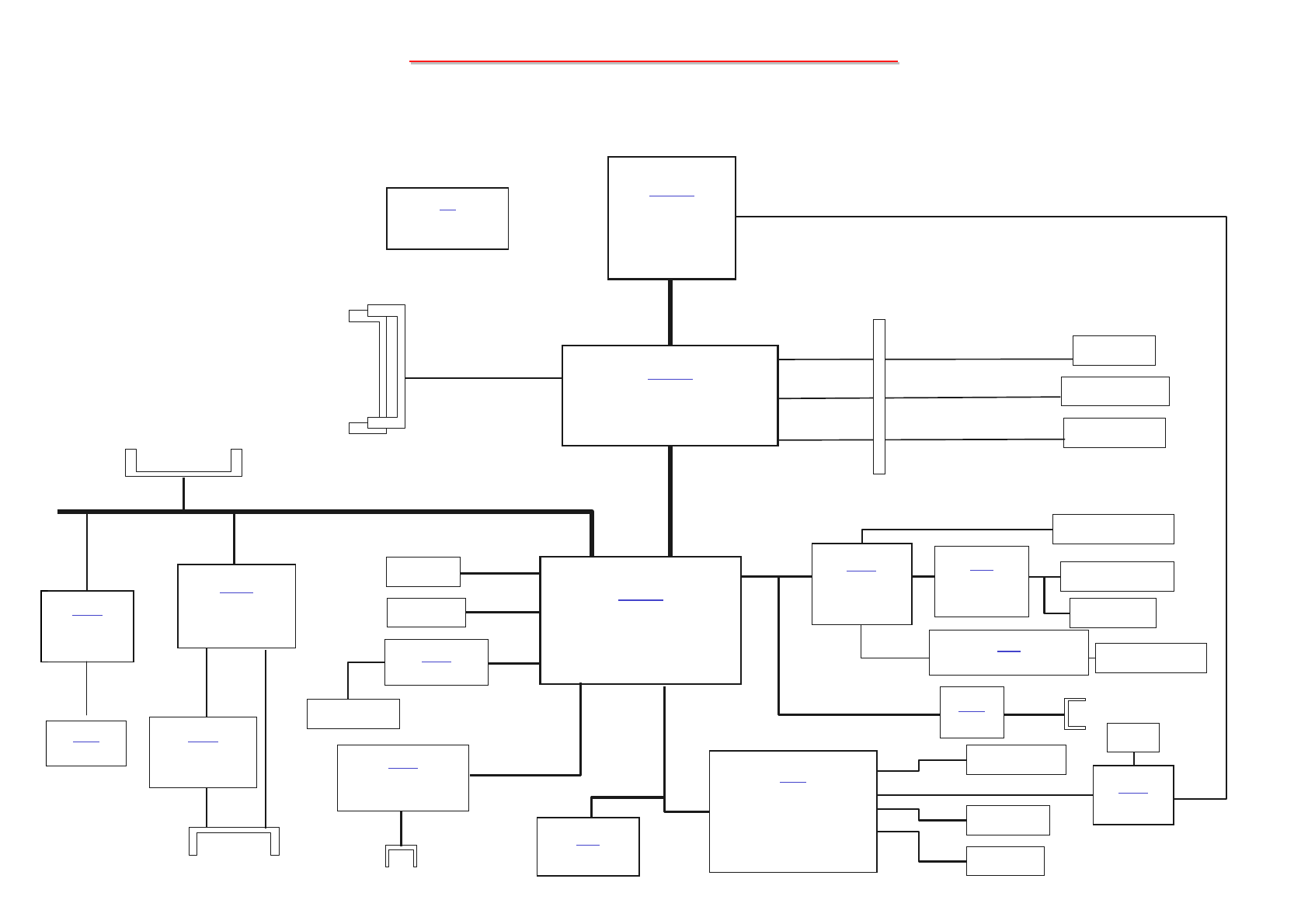
98
80
8050QMA
50QMA N/B Maintenance
N/B Maintenance
6. System Block Diagram
DVI Connector
RGB Signal
Flat Panel
LVDS Signal
200 Pins DDR2 SO-DIMM Socket * 2
USB * 4
FSB
U711
Intel CPU
Dothan
U710
North Bridge
915PM
U715
Card Bus
CB712
U509
Power Switch
CP2211A
U19
Amplifier
TPA0212
J507
M.D.C RJ-11 Jack
U517
Audio Codec
ALC655
Mic-in Connector
Internal Speaker
Headphone
CD-ROM
U724
SATA Bridge
U709
South Bridge
ICH6-M
U717
LAN Controller
RTL8110SBL
RJ-45 Jack
DMI
PCMCIA
Slot
U722
IEEE1394
VT6301T
PCI Bus
FAN
Power Button
Keyboard
Touch Pad
U13
Keyboard BIOS
Winbond
W83L950D
LPC BUS
IDE
U7
Clock Generator
ICS954226
U14
System BIOS
MINI PCI Slot
PCI-E_LAN
FWH BUS U505
ADT7460
SMBUS
THRMDA/THRMDC
TV Connector
TV Signal
PATA HDD
MXM_Connector
U18
SUBWOOFER AMP Subwoofer Jack
J719
1394 port
MiTac Secret
Confidential Document

99
80
8050QMA
50QMA N/B Maintenance
N/B Maintenance
7. Maintenance Diagnostics
7.1 Introduction
Each time the computer is turned on, the system BIOS runs a series of internal checks on the hardware. This power-
on self test (post) allows the computer to detect problems as early as the power-on stage. Error messages of post can
alert you to the problems of your computer.
If an error is detected during these tests, you will see an error message displayed on the screen. If the error occurs
before the display is initialized, then the screen cannot display the error message. Error codes or system beeps are
used to identify a post error that occurs when the screen is not available.
The value for the diagnostic port is written at the beginning of the test. Therefore, if the test failed, the user can
determine where the problem occurred by reading the last value written to the port-80H by the debug card plug at
MINI PCI slot.
MiTac Secret
Confidential Document

100
80
8050QMA
50QMA N/B Maintenance
N/B Maintenance
7.2 Maintenance Diagnostics
7.2.1 Diagnostic Tool for Mini PCI Slot :
P/N:411906900001
Description: PWA; PWA-MPDOG/MINI PCI DOGKILLER CARD
Note: Order it from MIC/TSSC
MiTac Secret
Confidential Document

101
80
8050QMA
50QMA N/B Maintenance
N/B Maintenance
7.3 Error Codes-1
Following is a list of error codes in sequent display on the MINI PCI debug board.
Test 8237A Page Registers1Fh
Initialize Monochrome Adapter1Eh
Initialize Color Adapter1Dh
Initialize Video (6845Regs)1Ch
Initialize Video Adapter(s)1Bh
Reset PIC’s1Ah
Check sum the ROM19h
Dispatch to RAM Test18h
Size Memory17h
User Register Config through CMOS16h
Reset Counter / Timer 115h
Search for ISA Bus VGA Adapter14h
Initialize the Chipset13h
Signal Power On Reset12h
Turn off FAST A20 for Post11h
Some Type of Lone Reset10h
POST Routine DescriptionCode
Sign on Messages Displayed2Fh
Search for Color Adapter2Eh
Search for Monochrome Adapter2Dh
Going to Initialize Video2Ch
Setup Shadow2Bh
Protected Mode Exit Successful2Ah
RAM Test Completed29h
Protected Mode Entered Safely28h
RAM Quick Sizing27h
Initialize Int Vectors26h
Initialize 8237A Controller25h
Test the DMA Controller24h
Test Battery Fail & CMOS X-SUM23h
Check if CMOS RAM valid22h
Test Keyboard Controller21h
Test Keyboard20h
POST Routine DescriptionCode
MiTac Secret
Confidential Document

102
80
8050QMA
50QMA N/B Maintenance
N/B Maintenance
7.3 Error Codes-2
Following is a list of error codes in sequent display on the MINI PCI debug board.
Special Init of COMM and LPT Ports3Fh
Update NUMLOCK status3Eh
Search and Init the Mouse3Dh
Initialize the Hardware Vectors3Ch
Test for RTC ticking3Bh
Test if 18.2Hz Periodic Working3Ah
Setup Cache Controller39h
Update Output Port38h
Protected Mode Exit Successful37h
RAM Test Complete36h
Protected Mode Entered Safely(2)35h
Test, Blank and Count all RAM34h
Test Keyboard Command Byte33h
Test Keyboard Interrupt32h
Test if Keyboard Present31h
Special Init of Keyboard Controller30h
POST Routine DescriptionCode
Jump into Bootstrap Code49h
Dispatch to Operate System Boot48h
OEM functions before Boot47h
Test for Coprocessor Installed46h
Update NUMLOCK Status45h
OEM’s Init of Power Management44h
Initialize Option ROMs43h
Initialize the Hard Disk42h
Initialize the Floppies41h
Configure the COMM and LPT ports40h
POST Routine DescriptionCode
MiTac Secret
Confidential Document

103
80
8050QMA
50QMA N/B Maintenance
N/B Maintenance
8. Trouble Shooting
8.1 No Power(*1)
8.2 No Display(*2)
8.3 VGA Controller Test Error LCD No Display
8.4 External Monitor No Display
8.5 Memory Test Error
8.6 Keyboard (K/B) Touch-Pad (T/P) Test Error
8.7 Hard Drive Test Error
8.8 CD-ROM Drive Test Error
8.9 USB Port Test Error
8.10 Audio Test Error
8.11 LAN Test Error
8.12 PC Card Socket Test Error
MiTac Secret
Confidential Document

104
80
8050QMA
50QMA N/B Maintenance
N/B Maintenance
*1: No Power Definition
Base on ACPI Spec. We define the no power as while we press the power button, the system can’t leave S5 status
or none the PG signal send out from power supply.
*2: No Display Definition
Base on the digital IC three basic working conditions: working power, reset, Clock. We define the no display as
while system leave S5 status but can’t get into S0 status.
Judge condition:
Check whether there are any voltage feedback control to turn off the power.
Check whether no CPU power will cause system can’t leave S5 status.
If there are not any diagram match these condition, we should stop analyzing the schematic in power supply sending
out the PG signal. If yes, we should add the effected analysis into no power chapter.
Judge condition:
Check which power will cause no display.
Check which reset signal will cause no display.
Check which Clock signal will cause no display
Base on these three conditions to analyze the schematic and edit the no display chapter.
S5: Soft Off
S0: Working
Keyword:
For detail please refer the ACPI specification
MiTac Secret
Confidential Document
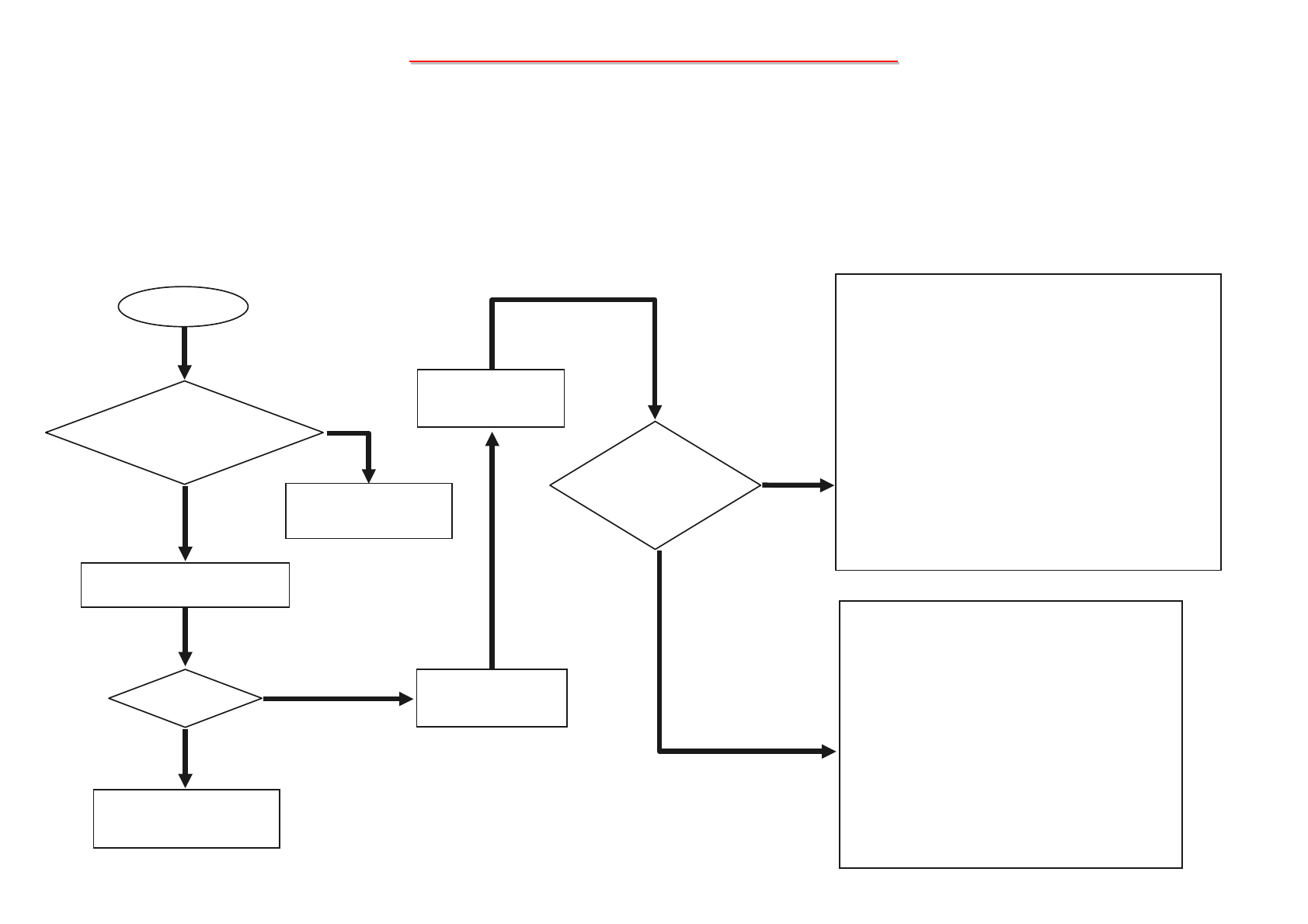
105
80
8050QMA
50QMA N/B Maintenance
N/B Maintenance
When the power button is pressed, nothing happens, no fan activity is heard and power indicator is not light up.
AC
Power
Battery
BATT
BAT_T
BAT_V
BAT_CLK
BAT_DATA
PU3
PL507
PF501
PQ506
PD505
PL508
PD507
PQ503
Where from
power source problem
(first use AC to
power it)?
Check following parts and signals:
Check following parts and signals:
Parts: Signals:
No
Board-level
Troubleshooting
Replace
Motherboard
No Power
Try another known good
battery or AC adapter.
Is the
notebook connected
to power (either AC adaptor
or battery)?
Connect AC adaptor
or battery.
No
Replace the faulty AC
adaptor or battery.
Power
OK?
Yes
Yes
8.1 No Power-1
Parts
PJ701
PL1
PF1
PQ501
PD502
U513
U515
Signals
ADINP
LEARNING
H8_I_LIMIT
SW_VDD3
Parts
Q37
Q50
U11
Signals
+PWR_VDDIN
+DVMAIN
ADINP
LEARNING
I_LIMIT
Main Board
MiTac Secret
Confidential Document

106
80
8050QMA
50QMA N/B Maintenance
N/B Maintenance
When the power button is pressed, nothing happens, no fan activity is heard and power indicator is not light up.
Main Voltage Map
+DVMAINADINPPOWER IN
PWR_VDDIN
PJ701
PF1 PL1
PL2
PD505
Discharge
PD502
PD503
BATT
PF501,PL506,PQ503
PU3,PL507,PL508,PD507
PQ506
Charge
Discharge
F4,U513
PQ501
P32
P28P32
P31
P32
8.1 No Power-2
J703
P32
+VDD5
Q50
+3V
+VDD3
U515 +VDD1.5+VDD3S
Q49 U11
+VDD3_RTC
D34,
P26
P26
P26 P26 P26
P11
+VDD3_AVREF
P26 Q37
PF502,PL512
PL506,PU5
PU503,PU504
PU506,PU511
PU512 +CPU_CORE
P30
+KBC_CPUCORE
R711 P23
PU502,PL503
PR508 +3VS_P
P27
PU2
+3V
P25
JS505~
JS507 +3VS
U504,L509
L501 P26
+3VS_HDD_ANALOG
L564 P14
L562 P14
+1.8VS_HDD
+3VS_HDD
P14
+1394_AVCC
P19
+3VS_CLK
P9
+1.8VS
P26
+3VS_TVDAC[A,B,C]
P6
+3VS_ATVBG
P6
L563
L531
L31
L32
U9
L40,L33
L41
L42
PU501,PL502
PR527 +5VS_P +5V
JS501~
JS504 P25P27
+5VS
L503,U502
L504 P26
L49 +5VS_CDROM
P14
AMPVDD
L73 P22
+5VS_HDD
L64 P14
+2.5V
P26
U8
+AVDDL
P15
L531
+2.5VS_CRTDAC
L39 P6
+2.5VS_ALVDS
+2.5VS_TXLVDS
L37
+2.5VS_HV
P6
P6
P6
L44
L35
+2.5VS
P26
Q12
+DVDD
P15
L533
PR42
PU12
PU509,PU510
PL516 +1.8V_P +1.8V
JS6,
JS515 P25P29
+DDR2_VREF
R606
R242 P8
+0.9VS_P +0.9VS
JS517~
JS518 P25P29
MiTac Secret
Confidential Document
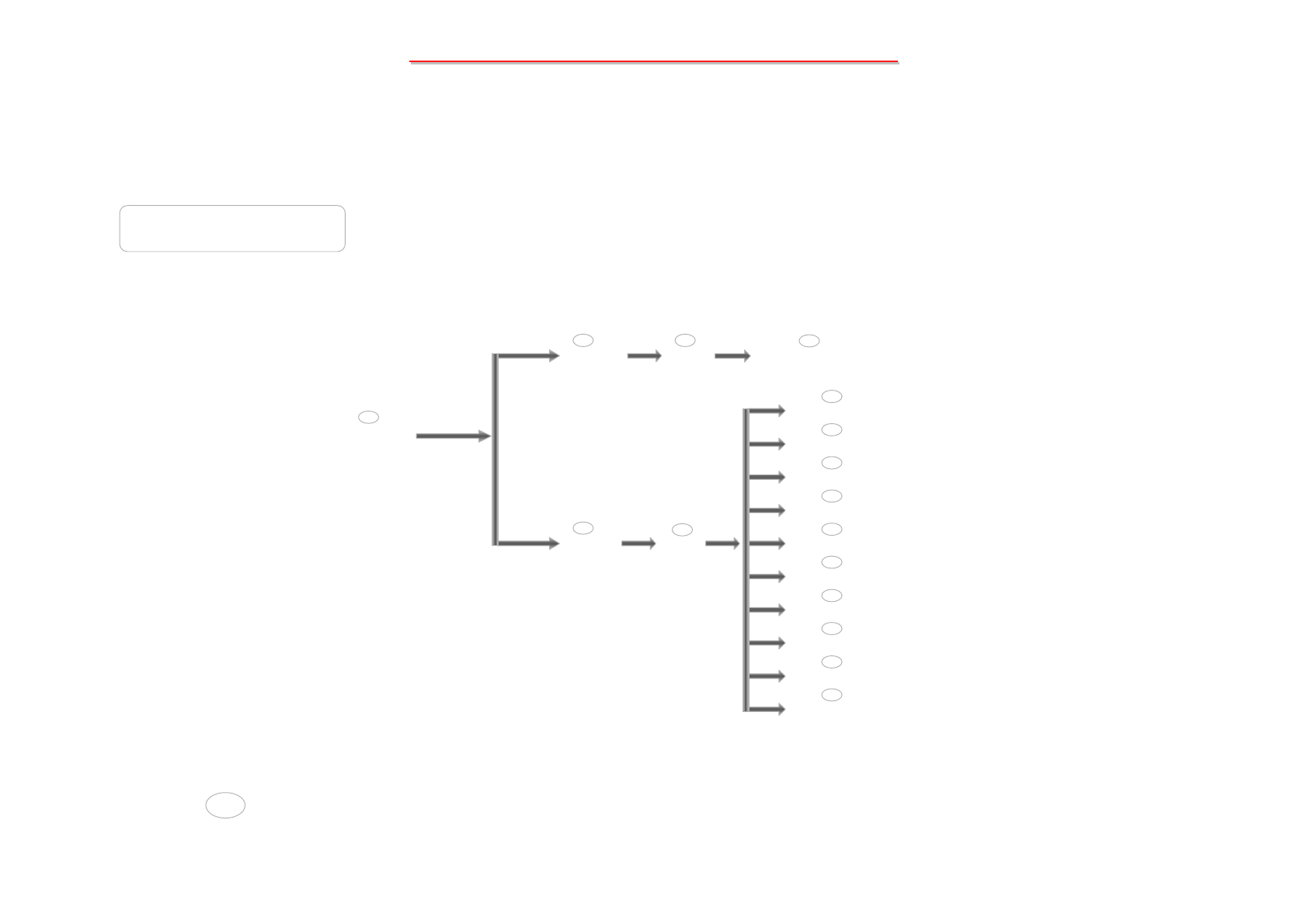
107
80
8050QMA
50QMA N/B Maintenance
N/B Maintenance
When the power button is pressed, nothing happens, no fan activity is heard and power indicator is not light up.
Main Voltage Map
8.1 No Power-3
PL514,PL515
PU6
PU507,PL514 +1.05VS_P +VCCP
JS508~
JS510 P25P28
+VCC_GMCH
L50 P6
+1.5VS_P +1.5VS
JS511~
JS513
P28
+1.5VS_DPLLA
P6
L34
+DVMAIN
P28
PU508,PL515
+1.5VS_DPLLB
P6
L46
+1.5VS_HPLL
P6
L519
+1.5VS_MPLL
P6
L518
+1.5VS_3GPLL
P6
L51
+1.5VS_QTVDAC
P6
L43
+1.5VS_DLVDS
P6
L38
+1.5VS_DDRDLL
P6
L63
+1.5VS_PCIE
P6
L516
+1.5VS_TVDAC
P6
L36
P25
: Page 25 on M/B Board circuit diagram.
NOTE :
P25
MiTac Secret
Confidential Document

108
80
8050QMA
50QMA N/B Maintenance
N/B Maintenance
When the power button is pressed, nothing happens, no fan activity is heard and power indicator is not light up.
8.1 No Power-4
+DVMAIN
ADINP
PC532
1000P
PC528
0.01µ
S
D
2
3
1
6
7
8
5
G
PR503
100K
PR502
470K
PQ501
AQ4407
LEARNING
PR505
1M
23
+PWR_VDDIN
PD504
SBM1040
AK
PQ502
2N7002
U13
Keyboard
BIOS
W83L950D
P23
SW_VDD3 17
PJ701
POWER IN
PL2
120Z/100M
PC2
0.01U
PL1
120Z/100M
1
2~4
PD501
RLZ24D
PC501
1U
PF1
7A/24VDC
P31
JO2,JO1
SPARKGAP_6
PR1
10
4
5
6
RS+
OUT
RS-
PU1
PC3
1U
PC1
0.01U
3
VCC
1
GND0
2
GND1
MAX4173FEUT-T
JO502
OPEN-SMT4
PR501
.01
P31
H8_I_LIMIT 76
I_LIMIT
PC502
0.01U
PR506
4.7K
PC520
0.01µ
PD502
SCS140P
AK
LEARNING
+3V
+VDD3
C389
4.7µ
DS
G
+PWR_VDDIN
+VDD3
+3V
+VDD3
Q50
AO3413
Q47
DDTC144WCA
SW_VDD3
C327
0.1µ
R397
100K
DS
G
Q37
AO3413
U513
NTC78L05
F4
3216FF-1
+PWR_VDDIN 3IN OUT 1
P26
2
C767
1µ
C324
10µ
+VDD5
R340
0
U515
AMS3107
INPUT OUTPUT 3
P26
2,4 C689
10µ
+VDD3_AVREF
1
PD505
SCS140P
MiTac Secret
Confidential Document

109
80
8050QMA
50QMA N/B Maintenance
N/B Maintenance
When the power button is pressed, nothing happens, no fan activity is heard and power indicator is not light up.
Charge
ADINP
PD507
SSA34
P32
PL508
33µH
PQ8
2N7002
G
S
D
PQ7
DTA144WK
PC29
0.01µ VCC
OUTPUTCTRL
REF 2IN- DTC 4
FEEDBACK
PR32
100K
3
1IN-
2IN+ 16
2
PU3
PWM
TL594C
C1,C2
PD4
BAS32L
PR45
4.7K
PR46
4.7K
PQ11
MMBT2222A
8,11
PR59
100K
PD506
SSA34
4
G
S
D
2
3
1
6
7
8
5
PQ503
AO4407
CHARGING
From H8 U13
2IN+
12
13
14
5
6
CT
RT
PR34
7.5K
PC21
1000P
PC22
0.01µ
PC30
1µ
PC23
0.1µ
P32
PR35
10K
PC25
0.1µ
15
REF
PR25
124K
PJS1
SHORT-SMT3
P23
GND GNDB
PR11
.02
GND
H8_I_CTRL
From U13
P23
PR36
590K
PR37
100K
1.25V
6
PR33
80.6K
PC24
0.1µ
+
_
+VDD3
5
PU4B
LMV393M
7
84
+DVMAIN
PR38
1K
PQ6
SCK431CSK-5
+VDD3
PC33
0.01µ BATT_DEAD#
To H8 U13
P23
8.1 No Power-5
PF501
TR/3216FF-3A
PL506
BEAD_120Z/100M
PC525
0.01µ
PC524
0.01µ
PC533
10µ
BATT
PD509
BZV55C15V
PC534
10µ
Q43
DDTC144TCA
PR47
0
PL507
3.0µH
PC535
10µ
PC536
0.01µ
PR28
287K
PQ5
2N7002
CHARGING
From H8 U510 P23
PR27
20K
PC17
0.1µ
PR24
13.7K
PR136
976K
PR135
2M
PJOL1
OPEN-SMT4
PJOH1
OPEN-SMT4
2IN+
12.65V
PR26
0
PR12
2.49K
BATT_DEAD
PC18
0.01µ
MiTac Secret
Confidential Document
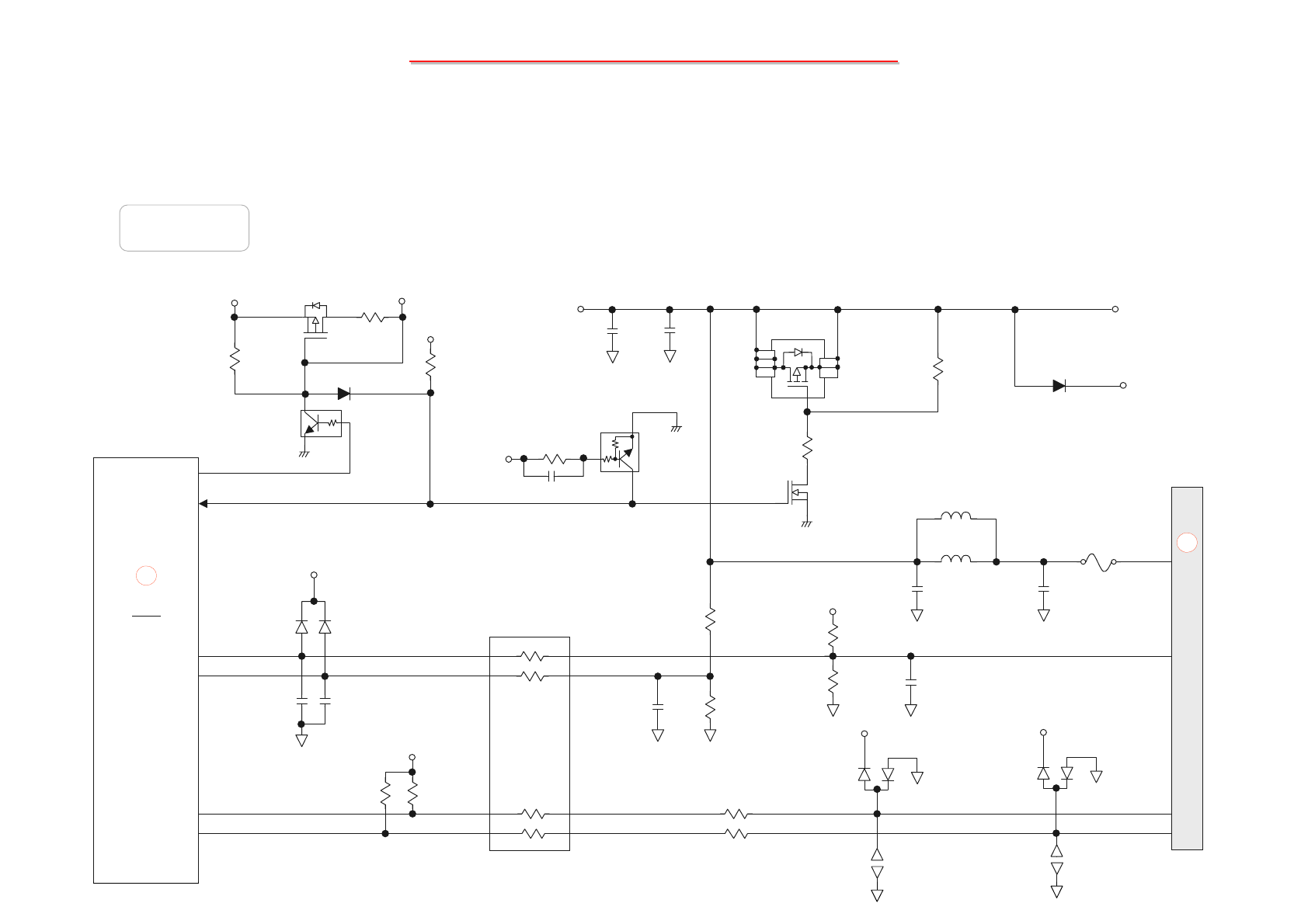
110
80
8050QMA
50QMA N/B Maintenance
N/B Maintenance
+VDD3_AVREF
1
2
3
C332
0.1µ
C333
0.1µ
D16
BAV70LT1
77
78
PC19
0.1µ
PR29
100K
PR510
499K
PL505
120Z/100M
PF701
TR/SFT-10A
PL504
120Z/100M
PC514
0.01µ
1,2
5
PC523
0.01µ
+VDD3_AVREF
PR134
4.99K
PR8
20K
PC10
0.1µ
When the power button is pressed, nothing happens, no fan activity is heard and power indicator is not light up.
Discharge
BAT_T
BAT_V
BAT_C
BAT_D
U13
Keyboard
BIOS
W83L950D
2
3
BAT_CLK
BAT_DATA
J703
Battery Connector
P31
R344
2.7K
+VDD3
R385
2.7K
P23
3
4
+VDD3
3
PD2
BAV99
2
1
+VDD3
3
PD3
BAV99
2
1
PR13
0
PR14
0
PQ504
2N7002
PR511
33K
ADEN#14
+DVMAIN
PR512
100K
BATT
G
S
D
2
3
1
6
7
8
5
PQ506
AO4407
JO10
SPARKGAP-6
PC526
1000P
PC527
0.01µ
JP1
SPARKGAP-6
4
8.1 No Power-6
+VDD3
DS
G
+VDD3S
R1
R378
100K
Q49
SI2301DS
D20
BAS32L
Q40
DDTC144TCA
RP502
10K
L81
120Z/100M +VDD3
12 KBC_PWRON_VDD3S
ADEN#
PQ507
DTC144WCA
PR509
226K
ADINP
PD505
SCS140P
AK +PWR_VDDIN
72
81
63
54
RP4
22*4
PC617
1000P
MiTac Secret
Confidential Document
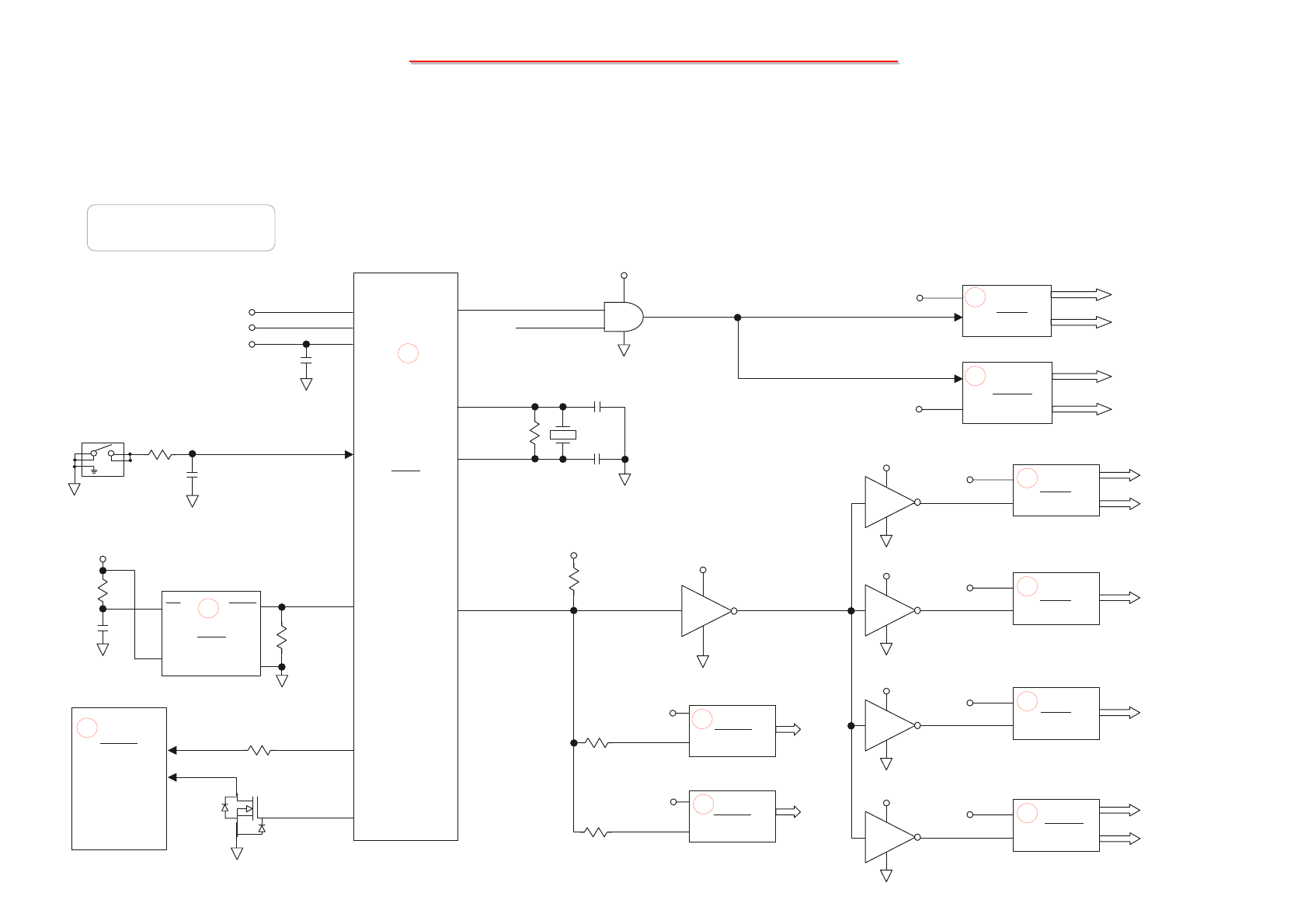
111
80
8050QMA
50QMA N/B Maintenance
N/B Maintenance
U709
South
Bridge
ICH6-M
P11
ICH_PWRBTN 7
ICH_PWRBTN#
R347
0
Q45
FDV301N
RSMRST#
8H8_RSMRST
S
D
G
When the power button is pressed, nothing happens, no fan activity is heard and power indicator is not light up.
Power Controller
8.1 No Power-7
18
1PWRBTN#
R12
1K
SW2
TCD010-PSS11CET
C7
1000P
U13
Keyboard
BIOS
W83L950D
P23
+VDD3_AVREF
+VDD3
+KBC_CPUCORE
C325
10µ
PU12
SC486
P29
+DVMAIN
+1.8V_P
+0.9VS_P
H8_PWRON
PU2
LTC3728L
P27
+DVMAIN +5VS_P
H8_PWRON
+VDD3
R435
10K
C388
0.01µ R396
100K
H8_RESET#
MN
VCC
RESET
GND
U21
IMP811
P26
25
29
X2
8MHz
C326
22P
28
C330
22P
21
KBC_X-
KBC_X+
R328
1M
+3VS_P
H8_PWRON
2
1
4
53
U726
AHC1G08DCK
+VDD3
H8_RESET#
5H8_PWRON_SUSB#
+VDD3S
R358
10K
U6C
74AHC14_V
+VDD3
56
147
PWRON_SUSB#
PWRON_SUSB6#
R69
0U504
AO4419
P26
+3V +3VS
PWRON_SUSB5#
R43
0
+5V +5VS
U502
AO4419
P26
+DVMAIN +1.5VS_P
PU6
ISL6227
P28
U6A
74AHC14_V
+VDD3
12
147
PWRON_SUSB1# +1.05VS_P
+2.5V
+2.5VS
Q12
AO3413
P26
U6D
74AHC14_V
+VDD3
98
147
PWRON_SUSB3#
+DVMAIN +1.8V_P
PU12
SC486
P29
U6E
74AHC14_V
+VDD3
11 10
147
PWRON_SUSB4# +0.9VS_P
+DVMAIN
+CPU_CORE
PU5
ISL6218
P30
U6B
74AHC14_V
+VDD3
34
147
PWRON_SUSB2#
MiTac Secret
Confidential Document
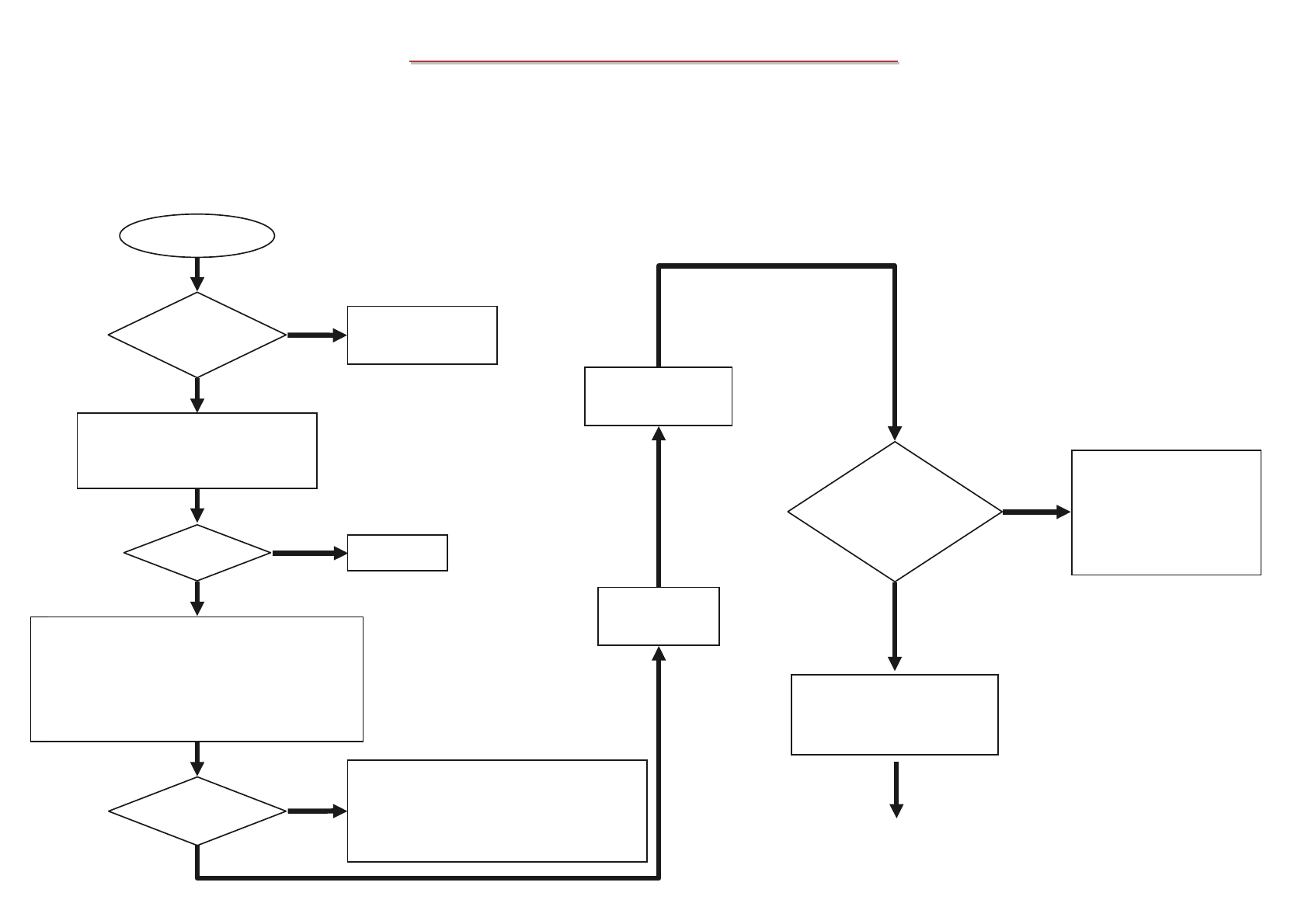
112
80
8050QMA
50QMA N/B Maintenance
N/B Maintenance
There is no display on both LCD and VGA monitor after power on although the LCD and monitor is known-good.
8.2 No Display-1
No Display
Monitor
or LCD module
OK?
Replace monitor
or LCD.
Board-level
Troubleshooting
System
BIOS writes
error code to port
378H?
Yes
No
Yes
No
Refer to port 378H
error code description
section to find out
which part is causing
the problem.
Make sure that CPU module,
DIMM memory are installed
Properly.
Display
OK?
Yes
No
Correct it.
To be continued
Clock,reset and power checking
Check system clock,
reset circuit and
reference power
Replace
Motherboard
1.Try another known good CPU module,
DIMM module and BIOS.
2.Remove all of I/O device ( HDD,
CD-ROM…….) from motherboard
except LCD or monitor.
Display
OK?
1. Replace faulty part.
2. Connect the I/O device to the M/B
one at a time to find out which part
is causing the problem.
Yes
No
MiTac Secret
Confidential Document
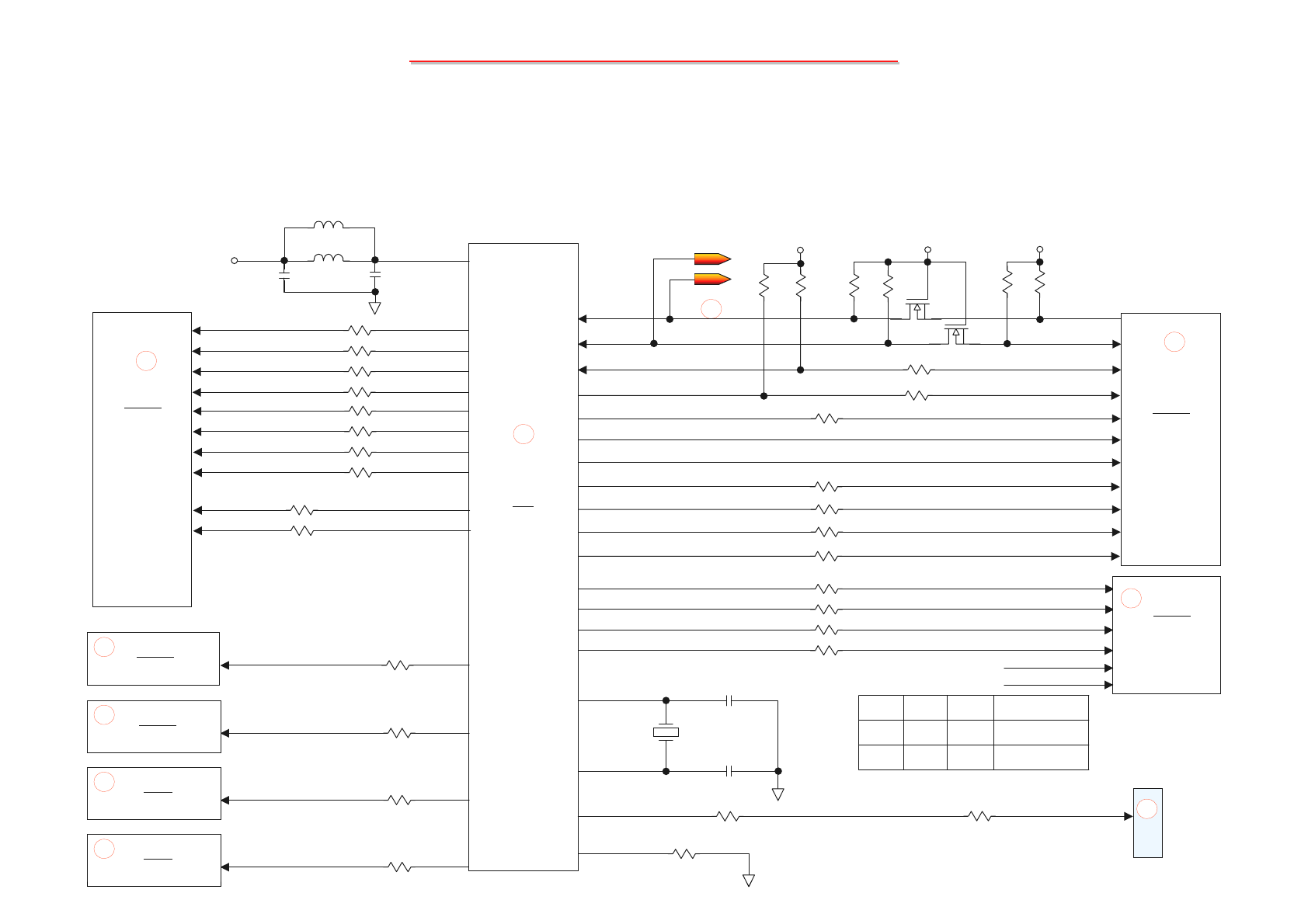
113
80
8050QMA
50QMA N/B Maintenance
N/B Maintenance
U13
W83L950D
P23
56PCICLK_KBC70
R114
33
U709
South Bridge
ICH6-M
P11
46
8
SMBCLK SMB_CLK
PCICLK_ICH
R207
2.2K
R206
2.2K
+VDD3S
To J714,J713
P8
47 SMBDATA SMB_DATA
33R93
R131 12.1
52 14M_ICH
12 CLK_USB48
54
24
STOP_PCI#
STOP_CPU#
CLK_ICH
55
33R98
R80 33
R97 33
R96 33
26
27
CLK_ICH#
CLK_SATA
CLK_SATA#
25
33R95
Q13
2N7002
G
S
D
Q14
2N7002
G
S
D
+3VS
R144
10K
R142
10K
PCICLK_F0
R103
10K
+3VS
FS_A
R76
10K
CLK_PCI_STOP#
CLK_CPU_STOP#
R127 33
R126 33
44
43
HCLK_CPU
HCLK_CPU#
R123 33
R122 33
36
35
CLK_ITP_CPU
CLK_ITP_CPU#
R111 33
R113 33
31
30
R125 33
R124 33
41
40
HCLK_MCH
HCLK_MCH#
CLK_GMCH
CLK_GMCH#
****** System Clock Check ******
8.2 No Display-2
U711
CPU
DOTHAN
P2
49
50
X1
14.318MHz
C97
56P
C98
56P
21
U7
Clock
Generator
ICS954226
P9
U710
North Bridge
GMCH
P4
39 R136 475
U715
CB712
P18
R94 33 5
PCICLK_CARD
J716
P20
PCICLK_MINIPCI 25
R92 33 R710 0
9
U717
RTL8100CL
P15
4PCICLK_LAN28
R104
33
L32
120Z/100M
+3VS C80
2.2µ C78
2.2µ
L31
120Z/100M +3VS_CLK
U14
SST49LF004A
P24
3PCICLK_FWH31
R105
33
R99 33
R87 33
R101 33
R100 33
17
18
14
15
DREFSSCLK
DREFSSCLK#
DREFCLK
DREFCLK#
133 MHzHLL
100 MHz (Default)HLH
BCLK FrequencyFS_AFS_BFS_C
R71 1K
R72 1K
16
53
CFG1
CFG2
FS_B
FS_C
HBSEL0
HBSEL1
MiTac Secret
Confidential Document

114
80
8050QMA
50QMA N/B Maintenance
N/B Maintenance
PLT_RST# 4
5
6
14
7
+3VS
FWH_PCIRST#
U14
System
BIOS
P24
JL20
JP_NET10 2
U10B
74AHC08_V
GMCH_RST#
JL21
JP_NET10
To North Bridge U710
LAN_RST#
JL26
JP_NET10
J710
CDROM
Connector
P145RSTDRV#
+5VS
R311
10K
Q18
DDTC144TCA
1
2
3
14
7
+3VS
KBC_PCIRST# U13
W83L950D
P23
JL19
JP_NET10 64
U10A
74AHC08_V R319
0
U724
88SA8040
P14
JL18
JP_NET10
17
IDE_RST#
+5VS
R293
10K
Q17
DDTC144TCA
IDE_RST#
PCIRST#
U10C
74AHC08_V
9
10
8
14
7
+3VS
PCI_PCIRST#
U715
Card Bus
CB712
P18
CARD_GRST#
U717
LAN Controller
P15
27LAN_PCIRST#
26MINIPCI_PCIRST# J716
MINI-PCI Slot
P20
JL22
JP_NET10
JL23
JP_NET10
JL25
JP_NET10
****** Power Good & Reset Circuit Check ******
8.2 No Display-3
U709
South
Bridge
ICH6-M
P9
VRMPWRGD 12
+3VS
14
13
7
11
U10D
74AHC08_V
From PU5
P30
U711
CPU
Dothan
P2
U710
North Bridge
Intel 915PM
P4
PWROK
+3VS
C374
0.1µ
R392
10K
VCC
RESET
GND
U20
MAX809
P26
J507
MDC
U517
Audio Codec
ALC655
P21
11 ACRST#
25
P21
HPWRGD
+VCCP
R169
200
HCPURST#
3
1
2
PWROK
R548
22 ICH_VGATE
PWROK
JL17
JP_NET10 J723
MXM
Connector
MXM_RST# P5
MiTac Secret
Confidential Document

115
80
8050QMA
50QMA N/B Maintenance
N/B Maintenance
Display
OK?
Replace faulty
LCD or monitor.
Display
OK?
VGA Controller Failure
LCD No Display
1. Confirm LCD panel or monitor is good
and check the cable are connected
properly.
2. Try another known good monitor or
LCD module.
Remove all the I/O device & cable from
motherboard except LCD panel or
extended monitor.
Connect the I/O device & cable to
the M/B one at a time to find out
which part is causing the problem.
Yes
No
Yes
No
Re-soldering.
One of the following parts on the mother-board may be
defective, use an oscilloscope to check the following signal or
replace the parts one at a time and test after each replacement.
Board-level
Troubleshooting
Replace
Motherboard
Yes
No
8.3 VGA Controller Test Error LCD No Display-1
There is no display or picture abnormal on LCD although power-on-self-test is passed.
Check if
J1, J2 are cold
solder?
Parts
U710
U709
U13
J506
J1
J2
J723
Signals
+3VS
LVDS_TX[0..2]+
LVDS_TX[0..2]-
LVDS_CLK+
LVDS_CLK-
LVDS_ENBKL
H8_ENABKL
Parts
L10~L13
SW1
R3
C1
R1
Signals
ENABKL
BLADJ
COVER_SW
Daughter BoardMain Board
MiTac Secret
Confidential Document

116
80
8050QMA
50QMA N/B Maintenance
N/B Maintenance
L19
120Z/100M
+3VS
R31
1M
F1
2A
Q4
AO4419
S
D
2
3
1
6
7
8
5
G
R28
0
1,2
C10
1µ
LVDS_ENVDD C15
0.22µ
8.3 VGA Controller Test Error LCD No Display-2
There is no display or picture abnormal on LCD although power-on-self-test is passed.
U710
North Bridge
Intel 915PM
P5
17
19
20
PANEL_ID0
PANEL_ID1
PANEL_ID2
J2
LCD Connector
P10
LVDS_CLK
LVDS_CLK#
EDID_CLK
EDID_DATA
LVDS_TX2
LVDS_TX2#
LVDS_TX1
LVDS_TX1#
13
15
19
21
27
25
22
20
U709
South Bridge
ICH6-M
P9
LCD
Inverter Board
+3VS
R13
20K
+3VS
R14
20K
+3VS
R15
20K
J1
Inverter
P10
L23
120Z/100M
+VDD3S 9
ENABKL_VGA
U13
Keyboard BIOS
W83L950D
P23
L25
120Z/100M
+DVMAIN 1,2
3
L22
130Z/100M
L21
130Z/100M 4
C22
0.01µ
C11
1000P
C13
0.1µ
C12
0.1µ
R3
0
+3VS
LVDS_ENBKL
H8_ENABKL
80
BLADJ
11
H8_LIDSW#16
R1
470K
+3V
R511
1K
Cover Switch
SW1
30V/0.1A
C1
0.1µ
LVDS_ENBKL 1
2
PANEL_ID3
+3VS
R25
20K
S
D
G
R33
10K
Q5
2N7002 J723
MXM_Connector
P5
IGP_LVDS_CLK
IGP_LVDS_CLK#
IGP_EDID_CLK
IGP_EDID_DATA
IGP_LVDS_TX2
IGP_LVDS_TX2#
IGP_LVDS_TX1
IGP_LVDS_TX1#
From J723
P5
MiTac Secret
Confidential Document

117
80
8050QMA
50QMA N/B Maintenance
N/B Maintenance
8.4 External Monitor No Display-1
There is no display or picture abnormal on CRT monitor, but it is OK for LCD.
Yes Re-soldering.
No
One of the following parts on the mother-board may be
defective, use an oscilloscope to check the following signal or
replace the parts one at a time and test after each replacement.
Parts:
U710
U2
J702
J723
L11
L2
L10
L30
Signals:
+3VS
CRT_DDDA
CRT_HSYNC
CRT_VSYNC
CRT_DDCK
CRT_RED
CRT_GREEN
CRG_BLUE
Check if
J702
are cold solder?
Display
OK?
External Monitor No Display
1. Confirm monitor is good and check
the cable are connected properly.
2. Try another known good monitor.
Remove all the I/O device & cable from
motherboard except monitor.
Display
OK?
Replace faulty monitor.
Connect the I/O device & cable
to the M/B one at a time to find
out which part is causing the
problem.
Yes
No
Yes
No
Board-level
Troubleshooting
Replace
Motherboard
MiTac Secret
Confidential Document

118
80
8050QMA
50QMA N/B Maintenance
N/B Maintenance
8.4 External Monitor No Display-2
There is no display or picture abnormal on CRT monitor, but it is OK for LCD.
IGP_CRT_RED
IGP_CRT_GREEN
IGP_CRT_BLUE
1
2
3
CON_RED
CON_GREEN
CON_BLUE
L2
130OHM/100M
L11
130OHM/100M
L10
130OHM/100M
JO52JO53 JO51
IGP_CRT_DDDA
IGP_CRT_HSYNC
IGP_CRT_VSYNC
IGP_CRT_DDCK
12
14
72
63
54
81
CP1
47P*4
U710
North Bridge
Intel 915PM
GMCH
P5
J702
P10
External DVI Connector
CON_DDDA
13CON_HSYNC
CON_VSYNC
15CON_DDCK
L568
130Z/100M
L569
130Z/100M
L15
130Z/100M
L14
130Z/100M
1A
2A
1Y
2Y
U2
SN74LVC2G125
P10
VCC 6
3
2
5
8
JO48
JO47 JO49
JO50
J723
MXM_Connector
139
141
220
218
R216
0
R219
0
DVI_DDDA
CRT_HSYNC
CRT_VSYNC
DVI_DDCK
CRT_RED
CRT_GREEN
CRT_BLUE
144
140
136
+DVMAIN
L30
120Z/100M
+3VS
MiTac Secret
Confidential Document

119
80
8050QMA
50QMA N/B Maintenance
N/B Maintenance
8.5 Memory Test Error-1
Extend DDRAM is failure or system hangs up.
Memory Test Error
One of the following components or signals on the motherboard
may be defective ,Use an oscilloscope to check the signals or
replace the parts one at a time and test after each replacement.
Test
OK? Correct it.
Yes
No
Parts:
U710
U7
J713
J714
R691
R692
R606
R242
C285
C604
Signals:
1. Check if on board SDRAM chips are no cold
solder.
2. Check the extend SDRAM module is installed
properly. ( J713,J714)
3. Confirm the SDRAM socket (J713,J714) is
ok,no band pins.
If your system host bus clock running at
266MHZ then make sure that SO-DIMM
module meet require of PC 266.
Test
OK?
Yes
No
+1.8V
+3VS
S[A..B]_MA[0..13]
CKE#[0..3]
CS#[0..3]
ODT[0..3]
S[A..B]_BS#[0..2]
S[A..B]_CAS#
S[A..B]_RAS#
S[A..B]_WE#
S[A..B]_DQS#[0..7]
S[A..B]_DQS[0..7]
S[A..B]_DM[0..7]
S[A..B]_DQ[0..63]
Board-level
Troubleshooting
Replace
Motherboard
Replace the faulty
DDRAM module.
SMBDATA
SMBCLK
NB_CLK _DDR[0,1,3,4]
NB_CLK _DDR[0,1,3,4]#
MiTac Secret
Confidential Document

120
80
8050QMA
50QMA N/B Maintenance
N/B Maintenance
8.5 Memory Test Error-2
Extend DDRAM is failure or system hangs up.
R243,R263….
56
+0.9VS
SMBDATA
SMBCLK
J713
P8
DDR SODIMM
+DDR2_VREF
R606
75
+1.8V
R242
75
C304
0.1µ
C604
2.2µ
C295
2.2µ
S[A..B]_DQS#[0..7], S[A..B]_DQS[0..7]
S[A..B]_A[0..13], CKE#[0..3], CS#[0..3], ODT[0..3]
S[A..B]_BS#[0..2], S[A..B]_CAS#, S[A..B]_RAS#, S[A..B]_WE#
S[A..B]_DM[0..7], S[A..B]_DQ[0..63]
NB_CLK_DDR[0,1,3,4], NB_CLK_DDR[0,1,3,4]#
U7
Clock
Generator
ICS954226
SMBDATA
SMBCLK
R692
10K
R691
10K
+3VS
47
46
SA_DQS#[0..7], SA_DQS[0..7]
SA_MA[0..13], CKE#[0..1], CS#[0..1], ODT[0..1]
SA_BS#[0..2], SA_CAS#, SA_RAS#, SA_WE#
SA_DM[0..7], SA_DQ[0..63]
NB_CLK_DDR[0,1], NB_CLK_DDR[0,1]#
J714
P8
DDR SODIMM
SB_DQS#[0..7], SB_DQS[0..7]
SB_MA[0..13], CKE#[2..3], CS#[2..3], ODT[2..3]
SB_BS#[0..2], SB_CAS#, SB_RAS#, SB_WE#
SB_DM[0..7], SB_DQ[0..63]
NB_CLK_DDR[3,4], NB_CLK_DDR[3,4]#
C285
0.1µ
P9
U710
North Bridge
915PM
GMCH
P4P7
SMBDATA
SMBCLK
MiTac Secret
Confidential Document
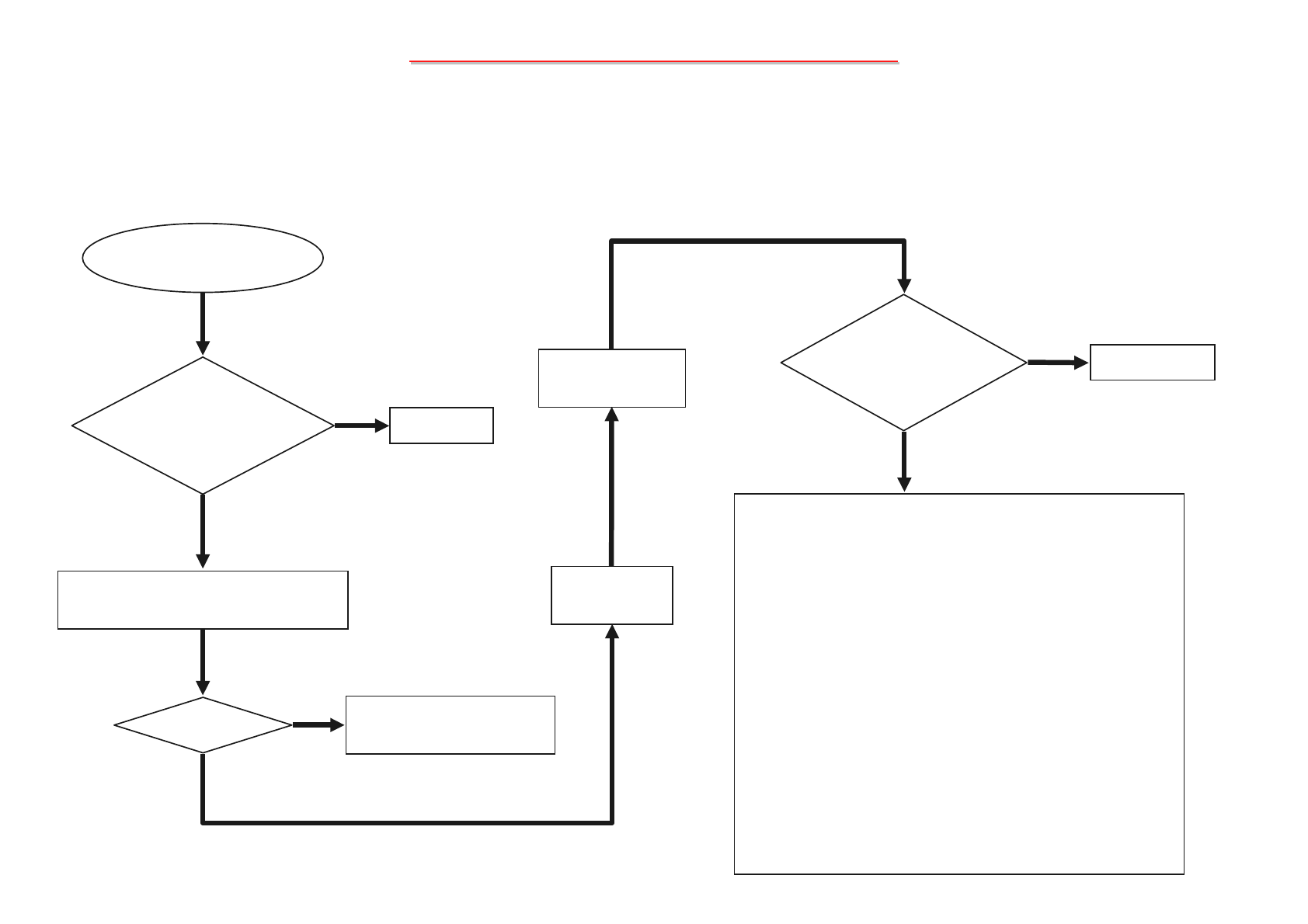
121
80
8050QMA
50QMA N/B Maintenance
N/B Maintenance
8.6 Keyboard (K/B) Touch-Pad (T/P) Test Error-1
Error message of keyboard or touch-pad failure is shown or any key does not work.
Keyboard or Touch-Pad
Test Error
Try another known good Keyboard
or Touch-pad.
Test
Ok?
Replace the faulty
Keyboard or Touch-Pad.
Check
J4, J5
for cold solder?
Yes
No
One of the following parts or signals on the motherboard
may be defective, use an oscilloscope to check the signals
or replace the parts one at a time and test after each
replacement.
Yes
No
Re-soldering.
Parts
U13
U14
U709
X2
SW3
SW4
F2
J4
J5
L48
Signals
+3VS
+VDD3
+KBC_CPUCORE
KI[0..7]
KO[0..15]
T_CLK
T_DATA
Is K/B or T/P
cable connected to notebook
properly?
Yes
No Correct it.
Board-level
Troubleshooting
Replace
Motherboard
MiTac Secret
Confidential Document

122
80
8050QMA
50QMA N/B Maintenance
N/B Maintenance
C330
22P
28
29
C326
22P
X2
8MHZ
R328
1M
T_CLK
T_DATA
6
9
L47 130Z/100M 11,12
9,10
TP_CLK
TP_DATA
U709
South Bridge
ICH6-M
+VDD3 71
U13
Keyboard
BIOS
W83L950D
8.6 Keyboard (K/B) Touch-Pad (T/P) Test Error-2
Error message of keyboard or touch-pad failure is shown or any key does not work.
U14
SYSTEM
BIOS
SST49LF004A
P24
P11
SERIRQ 69
13~15,17 LAD[0..3] 65~68
J5
+5V
L48
120Z/100MHZ
C537
0.1µ
Touch-Pad
P24
F2
0.5A/POLYSW
1,2
SW_RIGHT 5,6
7,8
SW_LEFT
R346
10K
R348
10K
+5VS
74
+KBC_CPUCORE
R704
10K
+3VS
LAD[0..3]
P23
KI[0..7]
KO[0..15]
17~24
1~16
Internal
Keyboard Connector
P23
J4
55~62
39~54
KBD_US/JP# 25
R146
10K
+3VS
LFRAME#
LFRAME#
23 63
+3VS
7
32,1
C694
0.1µ
8
25,27
R317 4.7K
R315 4.7K C709
4.7µ
KBD_US/JP#
R168
0
C541
47P
C542
47P
C539
47P
C540
47P
L72 130Z/100M
SW3
1
5
32
4
SW4
1
5
32
4
+5V
MiTac Secret
Confidential Document
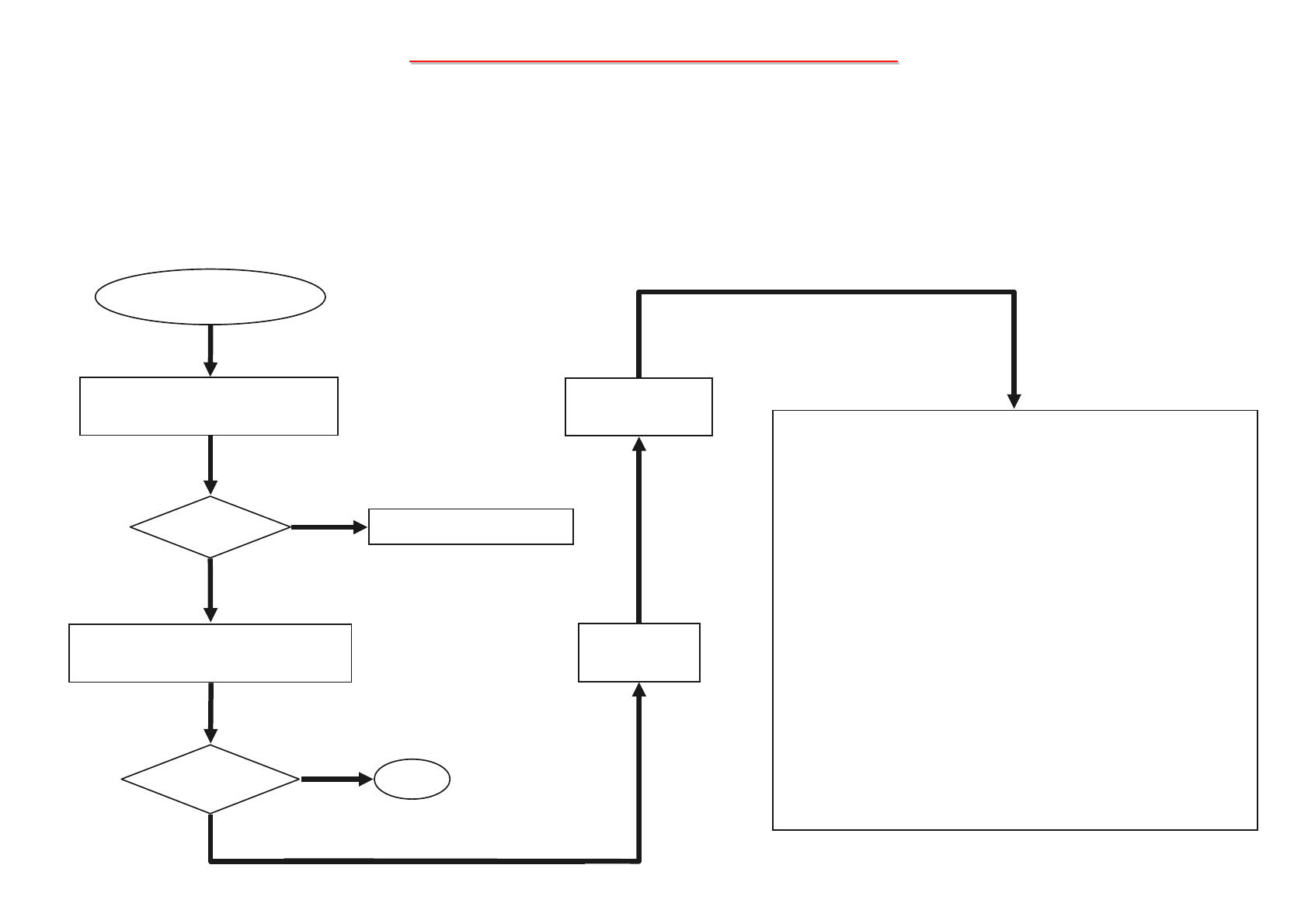
123
80
8050QMA
50QMA N/B Maintenance
N/B Maintenance
Hard Disk Drive
Test Error
One of the following parts or signals on the motherboard may
be defective, use an oscilloscope to check the signals or replace
the parts one at a time and test after each replacement.
Yes
No
Re-boot
OK? Replace the faulty parts.
1. Check if BIOS setup is OK?.
2. Try another working drive.
Check the system driver for proper
installation.
No
Re - Test
OK? End
Yes
Board-level
Troubleshooting
8.7 Hard Disk Drive Test Error-1
Either an error message is shown, or the drive motor spins non-stop, while reading data from or writing
data to hard disk.
Parts: Signals:
U709
U724
J715
X4
L64
D26
C294
C303
C309
C575
C577
C580
C582
+5VS
+5VS_HDD
SATA_RXN0
SATA_RXP0
SATA_TXN0
SATA_TXP0
DDRQ
DIORDY
DIRQ
DD[0..15]
DA[0..2]
DCS[0..1]#
Replace
Motherboard
MiTac Secret
Confidential Document
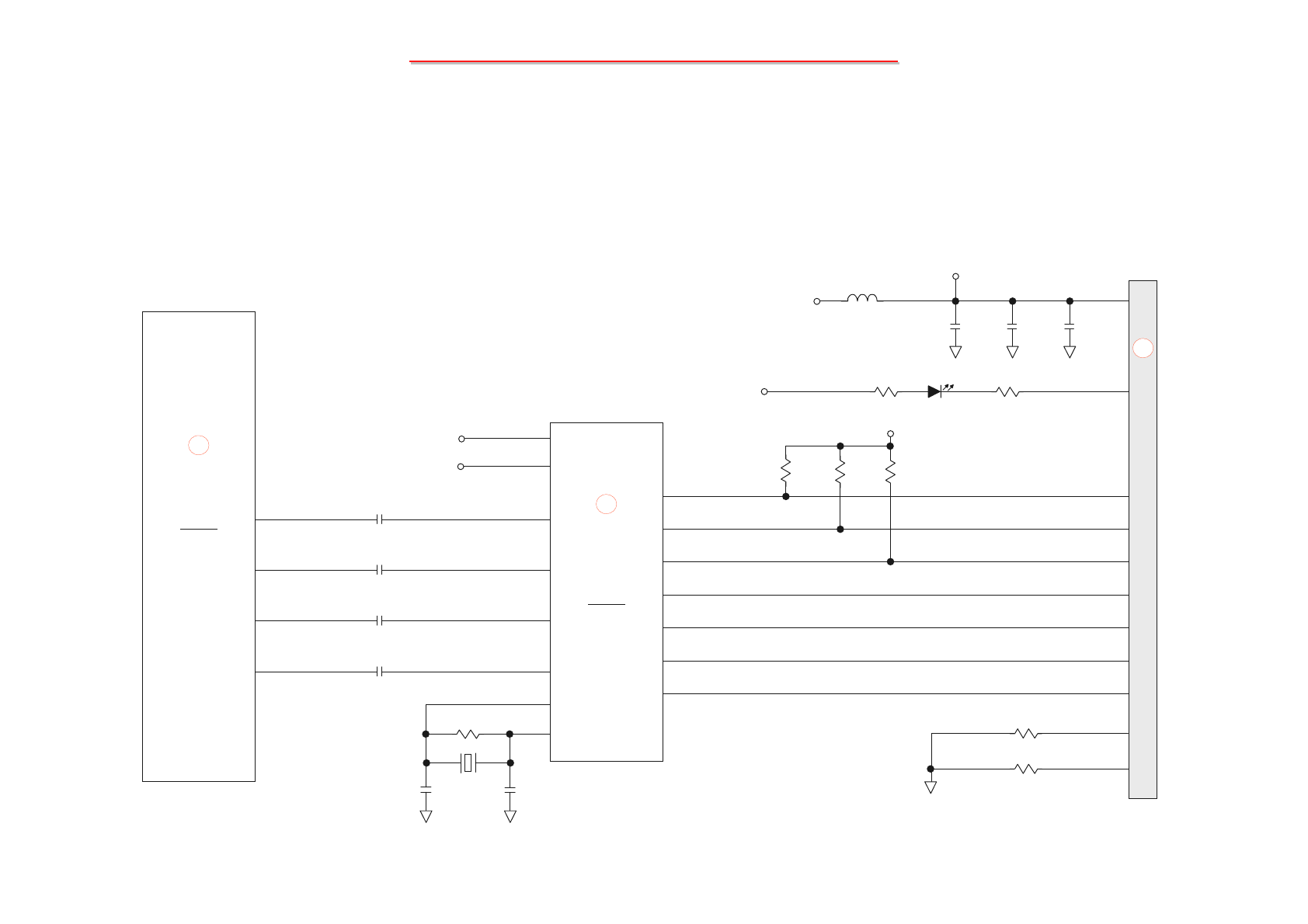
124
80
8050QMA
50QMA N/B Maintenance
N/B Maintenance
+1.8VS_HDD 41,56
C126
12P
23
22
C125
12P
X4
25MHZ
R225
1M
+5VS
R422
0
D26
CL-190G
R439
470
SATA_TXP
SATA_TXN
SATA_RXP
SATA_RXN
C582
3900P
C580
3900P
C577
3900P
C575
3900P
SATA_TXP0
SATA_TXN0
SATA_RXP0
SATA_RXN0
27
28
32
31
DDRQ 2460
DIORDY 1855
DIRQ 1453
DD[0..15] 27~421~3,5~7…
DA[0..2] 9,10,1249~51
DCS[0..1]# 7,847,48
DACK#,DIOR#,DIOW#,DRST# 16,20,22,4454,58,59,16
R824
10k 11
R825
470 17
8.7 Hard Disk Drive Test Error-2
Either an error message is shown, or the drive motor spins non-stop, while reading data from or writing
data to hard disk.
U709
South Bridge
ICH6-M
P11
J715
P14
PATA HDD Connector
U724
88SA8040
P14
+3VS
R819
8.2K
R818
4.7K
R817
5.6K
+5VS
C303
0.1µ
C309
0.1µ
L64
120Z/100MHZ
3,4
+5VS_HDD
C294
22µ
HDD_LED# 6
+3VS_HDD 44
MiTac Secret
Confidential Document

125
80
8050QMA
50QMA N/B Maintenance
N/B Maintenance
8.8 CD-ROM Drive Test Error-1
An error message is shown when reading data from CD-ROM drive.
CD-ROM Driver
Test Error
One of the following parts or signals on the motherboard may
be defective, use an oscilloscope to check the signals or replace
the parts one at a time and test after each replacement.
Yes
No
Parts: Signals:
Test
OK? Replace the faulty parts.
1. Try another known good compact disk.
2. Check install for correctly.
Check the CD-ROM drive for
proper installation.
No
Re - Test
OK?
U709
J710
L49
D27
C198
C208
C209
R198
R414
R441
R558
Yes
Board-level
Troubleshooting
+5VS
+5VS_CDROM
SD_D[0..15]
SDA1
IDEIRQ
SDDACK#
SIORDY
SDIOW#
SDDREQ
SDIOR#
SDA0
SDCS1#
SDCS3#
SDA2
End
Replace
Motherboard
MiTac Secret
Confidential Document

126
80
8050QMA
50QMA N/B Maintenance
N/B Maintenance
8.8 CD-ROM Drive Test Error-2
An error message is shown when reading data from CD-ROM drive.
J710
P14
CD-ROM Connector
R441
470
D27
CL-190G CD_LED#
+5VS
+3VS
R558
4.7K 5
37
6~21
38~42
31
29
28
27
25
22
24
35
36
34
33
+5VS
C198
10µ
C209
0.1µ
L49
120Z/100MHZ
IDEIRQ
SIORDY
SDIOW#
SDDREQ
SDDACK#
SDIOR#
SDA1
RSTDRV#
SD_D[0..15]
SDA0
SDCS1#
SDCS3#
SDA2
RSTDRV#
Refer Section 8.2(No display-3)
+5VS_CDROM
R414
0
IDEIRQ
SIORDY
SDIOW#
SDDREQ
SDDACK#
SDIOR#
SDA1
SDA0
SDCS1S#
SDCS3S#
SDA2
+3VS
R198
8.2K
U709
South Bridge
ICH6-M
P11
SD_D[0..15]
C208
0.1µ
MiTac Secret
Confidential Document
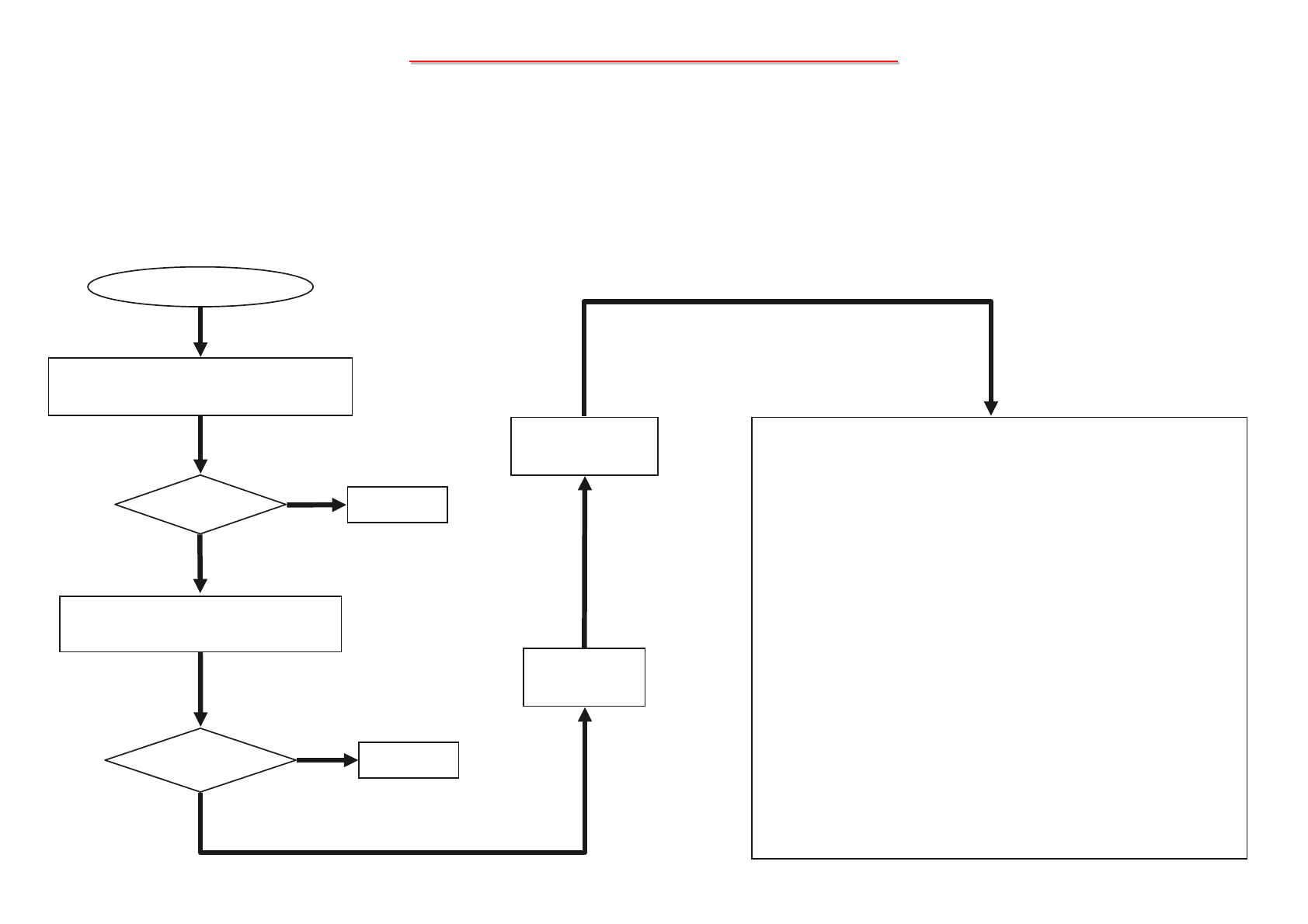
127
80
8050QMA
50QMA N/B Maintenance
N/B Maintenance
8.9 USB Test Error-1
An error occurs when a USB I/O device is installed.
Re-test
OK?
Test
OK?
USB Test Error
Check if the USB device is installed
properly.
No
Yes
No
Yes
Check the following parts for cold solder or one of the following
parts on the mother-board may be defective, use an oscilloscope
to check the following signal or replace the parts one at a time
and test after each replacement.
Replace another known good USB
device.
Board-level
Troubleshooting
Correct it.
Correct it.
Replace
Motherboard
Signals:
USB_OC0#
USB_OC1#
USBP[0..3]+
USBP[0..3]-
+VCC_USB_0
+VCC_USB_1
+VCC_USB_2
+VCC_USB_3
+5V
SW_VDD3
Parts:
U709
U501
U503
J701
J706
L5
L6
L10
L13
F503
F504
C2
C501
MiTac Secret
Confidential Document

128
80
8050QMA
50QMA N/B Maintenance
N/B Maintenance
8.9 USB Test Error-2
An error occurs when a USB I/O device is installed.
U709
South Bridge
ICH6-M
P11
U501
RT9701-CB
P14
USB Port
J701
2
3
L5
90Z/100M
32
14
1
+VCC_USB_1
L6
90Z/100M
41
23
A3
A2
A1
P14
R502
33K
C505
1000P
VIN
3
+5V
C172
1µ
VOUT0,1 1,5
C504
150µ
R503
47K +VCC_USB_0
R791
22 4CE C503
0.1µ
L502
120Z/100M
C502
0.1µ
L501
120Z/100M
SW_VDD3
From U13
P23
USB_OC0#
USBP0+
USBP0-
USBP1-
USBP1+
GND 2
R179
0
R180
0
R192
0
R186
0
F503
1.1A
U503
RT9701-CB
P14
USB Port
J706
2
3
L10
90Z/100M
23
41
1
+VCC_USB_3
L13
90Z/100M
14
32
A3
A2
A1
P14
R10
33K
C163
1000P
VIN
3
+5V
C178
1µ
VOUT0,1 1,5
C2
150µ
R159
47K +VCC_USB_2
R792
22 4CE C4
0.1µ
L1
120Z/100M
C769
0.1µ
L552
120Z/100M
SW_VDD3
From U13
P23
USB_OC1#
USBP2+
USBP2-
USBP3-
USBP3+
GND 2
R191
0
R190
0
R786
0
R787
0
F504
1.1A
MiTac Secret
Confidential Document

129
80
8050QMA
50QMA N/B Maintenance
N/B Maintenance
8.10 Audio Test Error-1
No sound from speaker after audio driver is installed.
Re-test
OK?
Test
OK?
Audio Failure
1. Check if speaker cables are
connected properly.
2. Make sure all the drivers are
installed properly.
Try another known good
speaker, CD-ROM.
Board-level
Troubleshooting
Yes
Yes
Check the following parts for cold solder or one of the following parts on the
motherboard may be defective,use an oscilloscope to check the following signal
or replace parts one at a time and test after each replacement.
1.If no sound cause
of line out, check
the following
parts & signals:
2. If no sound cause
of MIC, check
the following
parts & signals:
3. If no sound cause
of CD-ROM, check
the following
parts & signals:
No
No Parts:
U517
U19
U709
J509
J7
J3
L60
L61
Q48
L20
L18
L73
Q510
Signals:
AMP_RIGHT
AMP_LEFT
DEVICE_DECT
DECT_HP#OPT
SPDIFOUT
SPK_OFF
EAPD
OPTIN#
Parts:
U517
U709
U16
U17
MIC1
J720
J721
L71
L74
D4
L554
L543
L548
Signals:
+5VS
+3VS
+VA
MIC_VREF
MIC1
MIC2
MIC_EXT
Parts:
U709
U517
J710
R420
R407
R438
R419
R406
R434
Signals:
CDROM_LEFT
CDROM_RIGHT
CDROM_COMM
Correct it.
Correct it.
Replace
Motherboard
MiTac Secret
Confidential Document
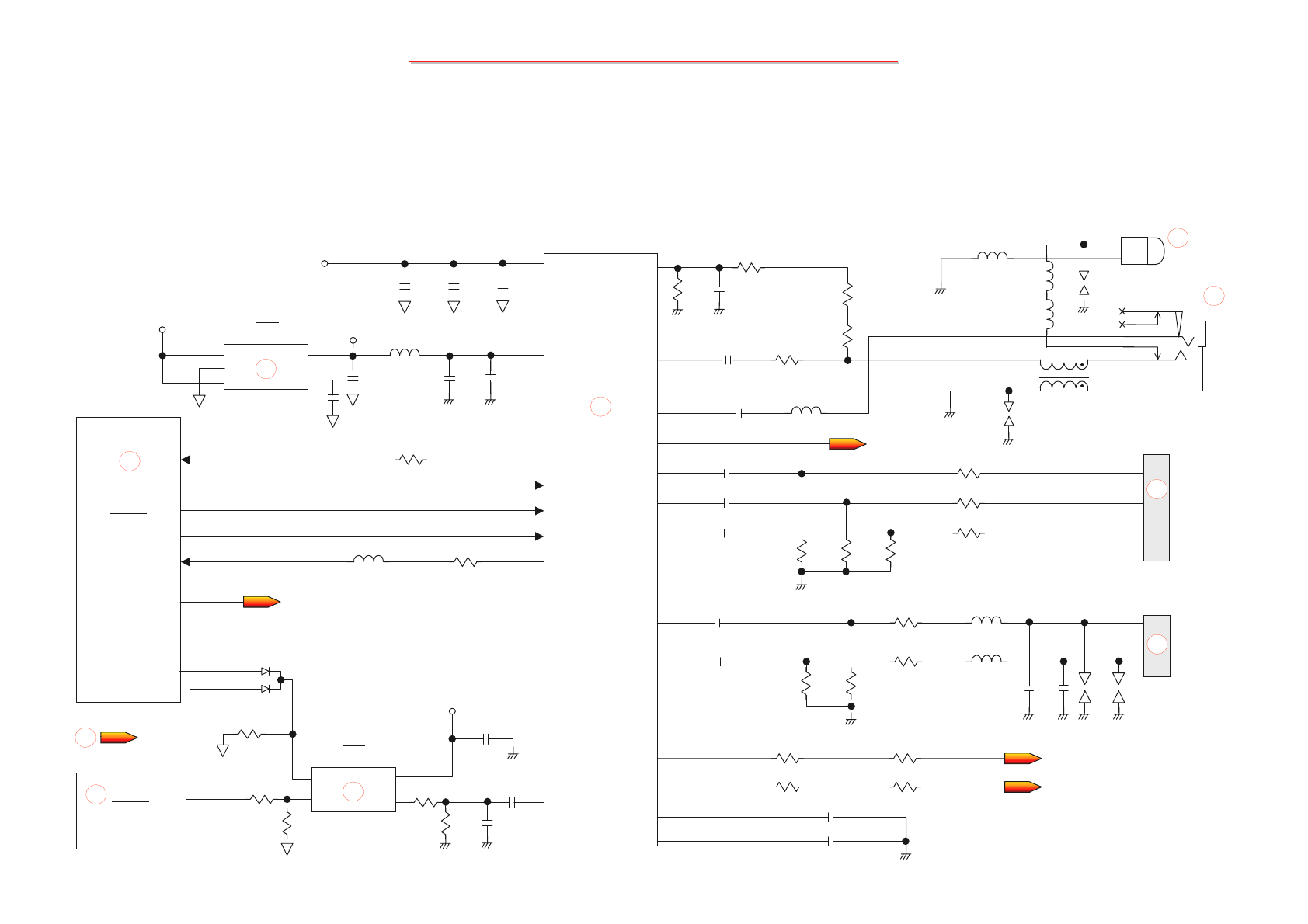
130
80
8050QMA
50QMA N/B Maintenance
N/B Maintenance
AGND
R406
6.8K
R419
6.8K
8.10 Audio Test Error-2 (Audio In)
U517
Audio Codec
ALC655
U709
South Bridge
ICH6-M
U715
PC14510GHK
C335
1µ
C339
0.1µ
SBSPKR
R336
10K
CARDSPK 12 PC_BEEP
SPK_OFF
To next page
1
24
+VA
DVDD1,2
AVDD1,2
25,38
P21
P18
R337
47K
R338
47K
+VA
L71
120Z/100M
C755
0.1µ
+3VS 1,9
20
C380
1µ CDROM_RIGHT
J710
CDROM
Connector
2
P14
R420
6.8K
18
C377
1µ CDROM_LEFT 1
R407
6.8K
19 C385
0.22µ CDROM_COMM 3
R438
0
AGND
+5VS
C581
10µ
C351
10µ
C725
0.1µ
ACSYNC
ACRST#
ACSDOUT
ACSDIN0
ACBITCLK
8
5
10
11
R391 22
6R390 22
P11
No sound from speaker after audio driver is installed.
C741
0.1µ
C748 1µ
C746 1µ
31
32
AGND
VIN
1OUT
U17
RT9167-47CB
5
P19
3CE ADJ 4
GND
2
C364
0.01µ
C763
1µ
C756
1µ
23
24
LINE_IN/L
LINE_IN/R
R436
0
R417
0
AGND
R418
22K
R437
22K
J721
Line In Jack
2
3,5 P21
L79
BEAD_600Z/100M
L78
BEAD_600Z/100M
C578
0.1µ
L74 220
R205
0
D31
BAV70LT1
2
13
KBC_DEEP
From U13
P23
AVCC
U16
NC7S32
P21 Y
B
5
R335
1K
C334
100P
External MIC
J720
1
2
6
3
5
4
P21
R784
4.7K
R783
0
C764
1µ
21 MIC
22 MIC2
C757
1µ
CAGND
MIC1
28 MIC_VREF
R405
0
R412
5.6K
C751
1µ
R785
0MIC_EXT
CAGND
C381
100P
L554
BEAD_600Z/100M
JO518
MIC1 P21
+
-
1
2
L520
BEAD_600Z/100M JO517
AGND
L62
BEAD_600Z/100M
AGND
To next page
36
35
AOUT_R
AOUT_L
AMP_RIGHT
AMP_LEFT
R758
0
R767
0
R756
0
R771
0
R434
0
CAGND
C378
100P
CAGNDCAGND
J10 J9
SPDIFOUT
To next page
48
L543
BEAD_600Z/100M
AGND
34
12
CAGND
L548
120OHM/100MHZ
MiTac Secret
Confidential Document

131
80
8050QMA
50QMA N/B Maintenance
N/B Maintenance
8.10 Audio Test Error-3 (Audio Out)
U19
Audio
Amplifier
TPA0212
R343
1K
C345
100P
R380
1K
C365
100P
C354
100µ
R379
22
P22
J7
21
16
ROUT+
ROUT-
1
2RInternal Speaker
Connector
C341
100µ
R404
22
L83
BEAD_600Z/100M
L76
BEAD_600Z/100M
C356
1µ
C347
1µ
AMP_RIGHT 20
23
From previous page RLINEIN
RHPIN
+5VS
7,18 PVDD0/PVDD1
AGND
C342
100µ
L73
120Z/100M
C734
0.1µ
C735
0.1µ
22SPK_OFF#
GAIN1 3
R362
100K
R741
100K
GAIN0 2
J3
4
9
LOUT+
LOUT-
1
2LInternal Speaker
Connector
15,17 DEVICE_DECT
+5VS
R1
Q31
DDTC144TCA
R729
4.7K
GND
LLINEIN
AMP_LEFT
5
6LHPIN
From previous page
C360
1µ
C355
1µ
19 VDD
+AMPVDD
R61 BEAD_600Z/100M
J509 P22
No sound from speaker after audio driver is installed.
P22
P22
AGND
+5VS
R365
1.3M
SPK_OFF
From previous page
R73
0
D514
BAW56
2
13
OPTIN#
GND
R208
1K
R60 BEAD_600Z/100M
R18 BEAD_600Z/100M
R20 BEAD_600Z/100M
Drive
IC
LED
L539
BEAD_600Z/100M
SPDIFOUT 7
8
9
LINE OUT
From previous page
+VA
R400
10K
Q48
DDTC144TCA
DEVICE_DECT#
L547
BEAD_600Z/100M
3
2
1
5
4
L546 0
AGND
AGND
+VA
R775
10K
R381
4.7K
DECT_HP#OPT
+3VS
DS
G
R1
R754
10K
Q509
AM2301P
Q510
DDTC144TCA
OPTIN#
L538
BEAD
600Z/100M
DECT_HP#OPT
DEVICE_DECT#
L77 BEAD_600Z/100M
MiTac Secret
Confidential Document
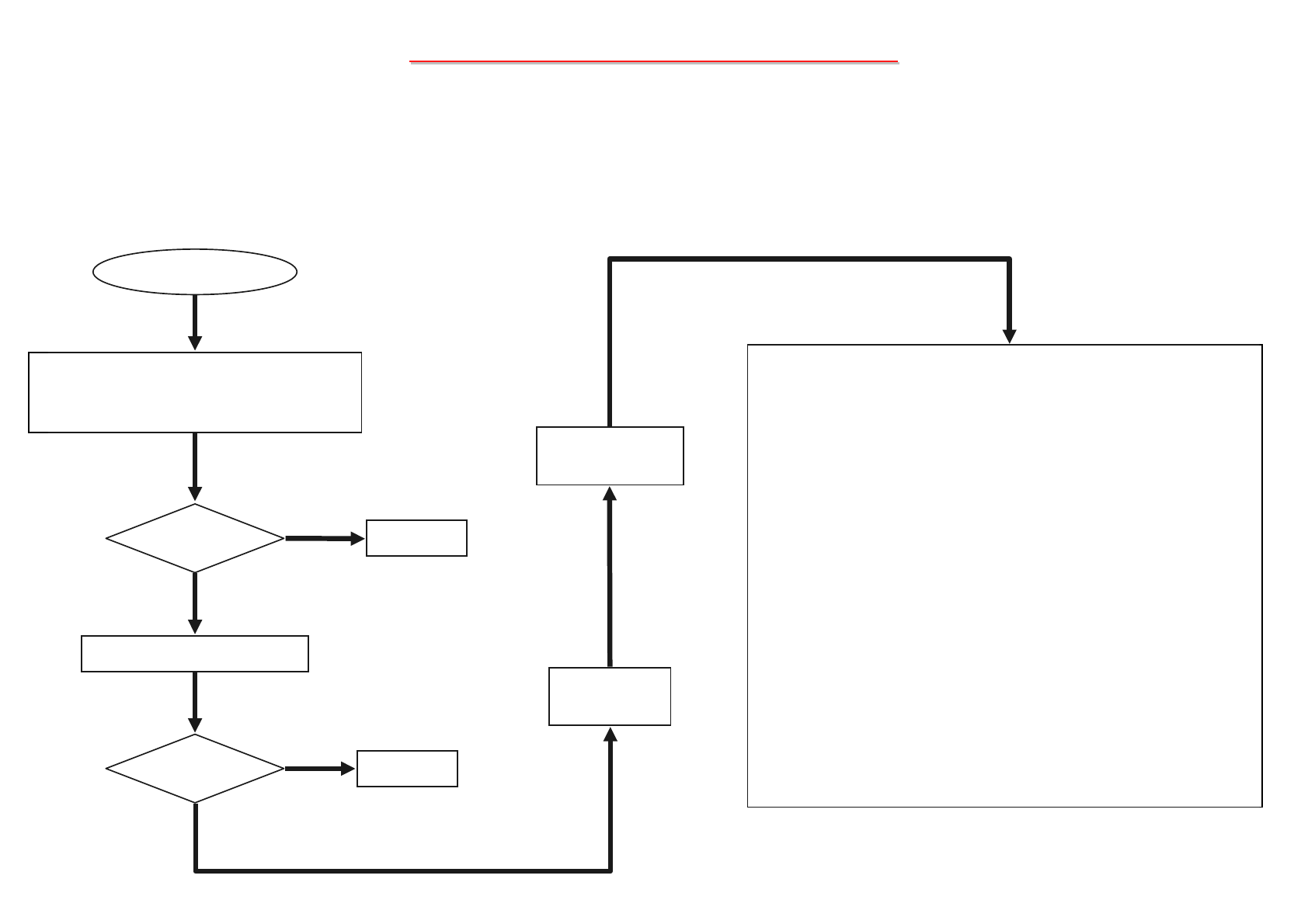
132
80
8050QMA
50QMA N/B Maintenance
N/B Maintenance
8.11 LAN Test Error-1
An error occurs when a LAN device is installed.
LAN Test Error
Yes
No
Test
OK?
No
Check if BIOS setup is ok.
Re-test
OK?
Board-level
Troubleshooting
Check the following parts for cold solder or one of the following
parts on the mother-board may be defective, use an oscilloscope
to check the following signal or replace the parts one at a time and
test after each replacement.
Parts: Signals:
1.Check if the driver is installed properly.
2.Check if the notebook connect with the
LAN properly.
Yes
U717
U709
U511
J506
U507
X503
L508
L510
L511
L512
R682
R683
R667
R670
+3V
ICH_PME#
PCI_C/BE#[0..3]
PCIKRUN#
PCI_DEVESEL#
PMDI[0..3]+
PMDI[0..3]-
EECS
EECK
EEDI
EEDO
PCI_SERR#
Correct it.
Correct it.
Replace
Motherboard
MiTac Secret
Confidential Document
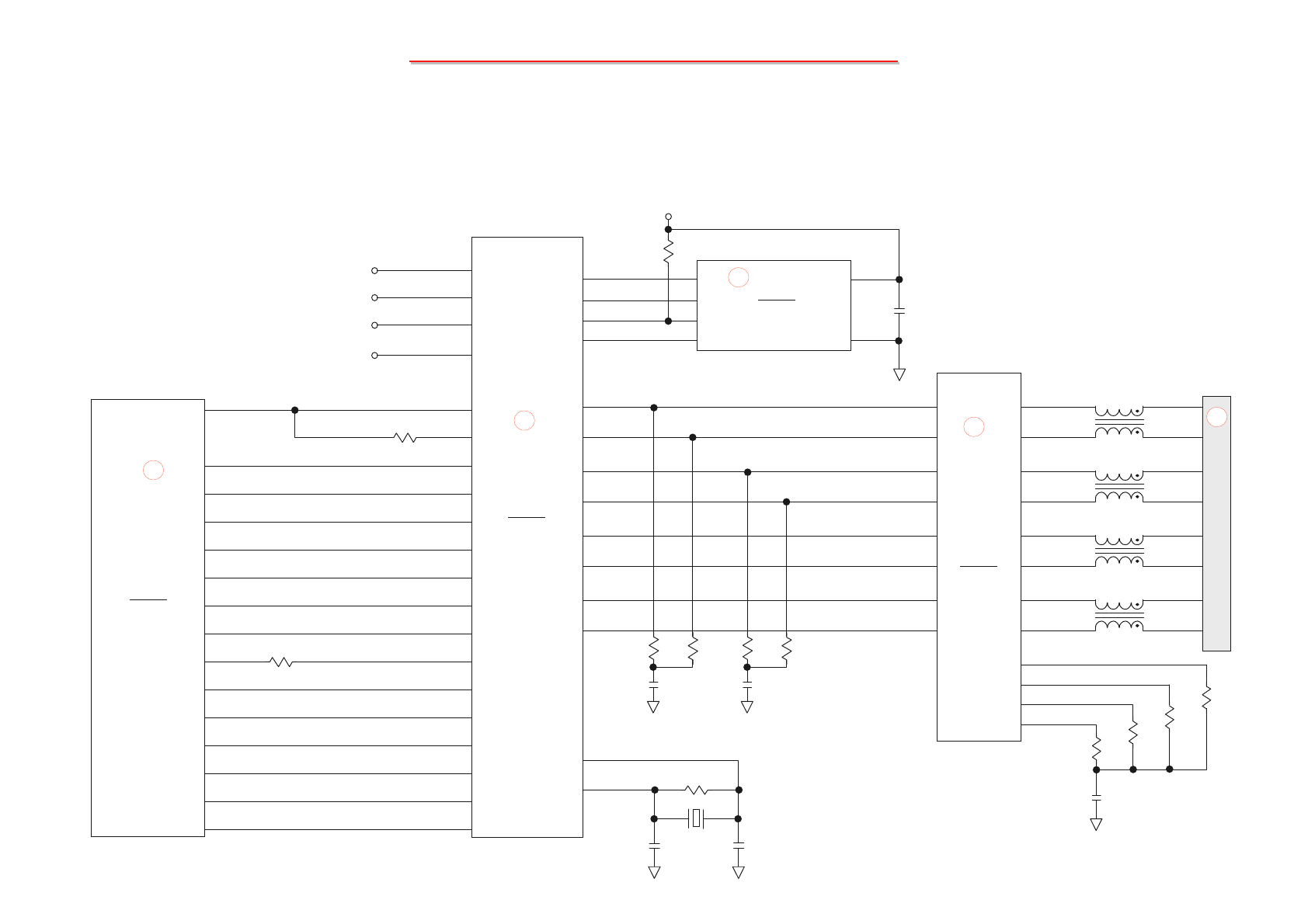
133
80
8050QMA
50QMA N/B Maintenance
N/B Maintenance
PCI_AD[0..31] 33…
PCI_AD20 46
ICH_PME# 31
PCI_C/BE[0..3] 44…
PCLKRUN# 65
PCI_DEVSEL# 68
PCI_FRAME# 61
PCI_GNT3# 29
PCI_REQ3# 30
PCI_INTE# 25
PCI_IRDY# 63
PCI_TRDY# 67
PCI_PAR 76
PCI_PERR# 70
PCI_SERR# 75
PCI_STOP# 69
MCT1
MCT3
MCT2
MCT4
24
21
18
15
R227
75
GND_45
R20
75
R204
75
R202
75
C263
1000P
MDI0+
MDI0-
MDI1+
MDI1-
MDI2+
MDI2-
MDI3+
MDI3-
13
14
16
17
19
20
22
23
1
2
3
6
4
5
7
8
L512
90Z/100M
32
14
L63
90Z/100M
L68
90Z/100M
L67
90Z/100M
PJTX0+
PJTX0-
PJRX1+
PJRX1-
MDO2+
MDO2-
MDO3+
MDO3-
U507
NS692408
P15 P15
J506
RJ45 LAN Connector
R670
49.9
R667
49.9
C651
0.01µ
GND
R683
49.9
R682
49.9
C668
0.01µ
GND
12
11
9
8
6
5
3
2
1
2
5
6
14
15
18
19
PMDI0+
PMDI0-
PMDI1+
PMDI1-
PMDI2+
PMDI2-
PMDI3+
PMDI3-
8.11 LAN Test Error-2
An error occurs when a LAN device is installed.
U717
LAN
Controller
RTL8100CL
P15
+3V
U709
South Bridge
ICH6-M
P11
LAN_XTAL1
LAN_XTAL2
C682
27P
121
122
C681
27P
X503
25MHZ
R686
1M
U511
93C46
P15
3
4
2
1
C660
1µ
DI
DO
SK
CS
GND
VCC
5
8
109
108
111
106
EEDI
EEDO
EECK
EECS
+3V
R696
3.6K
R508
100
R213
0
+AVDDL
+AVDDH
+DVDD
32
14
32
14
32
14
MiTac Secret
Confidential Document

134
80
8050QMA
50QMA N/B Maintenance
N/B Maintenance
Re-test
OK?
Test
OK?
PC Card Socket Failure
1. Check if the PC Card device is installed
properly.
2. Confirm PC Card driver is installed ok.
Yes
No
Yes
No
Change the faulty
part then end.
Check the following parts for cold solder or one of the following
parts on the mother-board may be defective, use an oscilloscope
to check the following signal or replace the parts one at a time and
test after each replacement.
Parts:
U715
U709
U509
J8
R625
R604
R240
Try another known good PC
Card or device.
Correct it
Board-level
Troubleshooting
Signals
PCI_REQ0#
PCI_SERR#
PCI_PERR#
PCI_DEVSEL#
PCI_FRAME#
PCI_IRDY#
PCI_TRDY#
PCI_STOP#
PCLKRUN#
PCI_PME#
PCI_GNT0#
PIC_PAR
PCI_AD[0..31]
PCI_C/BE#[0..3]
VCC5_EN#
VCC3_EN#
VPPD0
VPPD1
8.12 PC Card Socket Test Error-1
An error occurs when a PC card device is installed.
Replace
Motherboard
MiTac Secret
Confidential Document
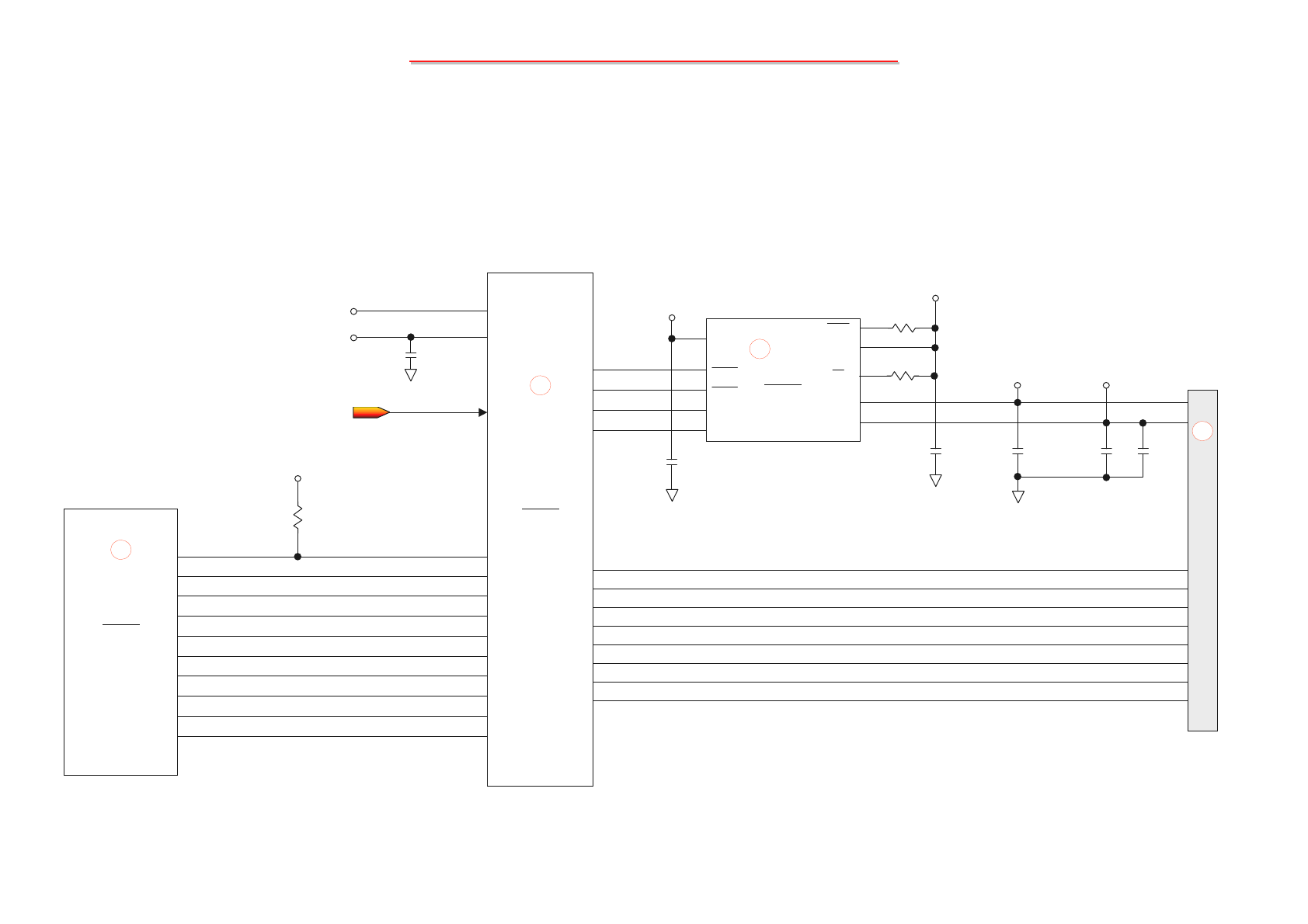
135
80
8050QMA
50QMA N/B Maintenance
N/B Maintenance
PCI_C/BE#[0..3]
PCI_PAR, PCI_STOP#
PCI_SERR#, PCI_PERR#
PCI_AD[0..31]
PCI_TRDY#, PCI_IRDY#
PCI_DEVSEL#
PCLKRUN#
PCI_GNT0#, PCI_REQ0#
IDSEL
PCI_FRAME#
R240
43.2
R2_D2, R2_D14, R2_A18
CAUDIO, CSTSCHG
8.12 PC Card Socket Test Error-2
An error occurs when a PC card device is installed.
CRST#, CCD[1,2]#,CVS[1,2]#
CAD[0..31], CC/BE[0..3]#
CFRAME#, CIRDY#, CTRDY#,
CREQ#, CGNT#, CINT#
CBLOCK#, CSTOP#, CDEVSEL#
U715
CardBus
Controller
CB712
P18
+3VS
C650
0.1µ
+CARD_VCC J8
Card Bus Socket
P16
C657
0.1µ
C662
0.1µ
+VPPOUT
VPPD0
VPPD1
VCC5_EN#
VCC3_EN#
3.3VA,B
AVCCC,B,A
AVPP
1
2
15
14
VCCD1
VCCD0
VDDP0
VDDP1
U509
CP2211A
P16
16
SHDN
5,6 5VA,B
C603
0.1µ
+5VS
+3VS
3,4
11-13
10
C610
0.1µ
CARD_VCC
VCC[1..10]
C628
0.1µ
VCCA1/2
U709
South Bridge
ICH6-M
P11
CARD_PCIRST#
Refer Section 7.2(No display-3)
OC 8
R604
10K
R625
10K
PCI_PME#
+3VS
CPAR, CPERR#, CSERR#
MiTac Secret
Confidential Document

Reference Material
Intel Pentium-M Processor Intel, INC
Intel 915PM North Bridge Data Sheet Intel, INC
Intel ICH6 South Bridge Data Sheet Intel, INC
System Explode View Technology.Corp./MiTAC
8050QMA Hardware Engineering Specification Technology.Corp./MiTAC

SERVICE MANUAL FOR 8050QMA
Sponsoring Editor : Jesse Jan
Author : ZX.Xiao
Assistant Editor : Ping Xie
Publisher : MiTAC International Corp.
Address : 1, R&D Road 2, Hsinchu Science-Based Industrial, Hsinchu, Taiwan, R.O.C.
Tel : 886-3-5779250 Fax : 886-3-5781245
First Edition : Jun. 2005
E-mail : Willy.Chen @ mic.com.tw
Web : http: //www.mitac.com http: //www.mitacservice.com